So far, I’ve looked at the biggest shake-ups in comics status quos in the 2010s. Of course, I think those were important. They’re paradigm shifts that allow for different stories. But sometimes, you need to go smaller, and that’s what this is. This time, I’m going to be highlighting specific moments in comics that I feel were the best in the 2010s.
These can range from a single scene to a single panel, but they’re what I consider the best the 2010s have to offer. They might stand on their own or be the payoff for years of storytelling, but these are the ones that had the biggest impact on me as a reader. As a rule: it can’t be an entire issue. I’m also trying to avoid placing similar scenes on this list. So yes, it’s a loose criterion, but it’s mine. Anyway, let’s see what we have for arbitrarily ranked my personal best comic book moments of the 2010s…
15. “He was an Adventure”, Die #2
Die is a comic that embodies the best of Kieron Gillen. His knack for clever dialogue, interesting ideas, strong characterisation and self-aware contemplative narration are felt in every issue, bolstered by Stephanie Hans’ beautiful art. The concept of a role-playing game that sucks its players in is a bit derivative, but Gillen leans into the teenage side of things and really shows what an RPG made and played by a bunch of pretentious, conflicted teenagers would be like, and the world that would result. Nowhere is that better shown than when Dominic (or rather, Ash) reunites with Sir Lane.
After the cast return to their game as adults after having escaped it as teenagers, they run into immediate trouble. After dealing with it, the party discusses whether to take a horrible route to their destination or the one they used years prior, where everyone knows them. Before they can decide, Ash runs into an old flame of sorts — Sir Lane, a typical knight in shining armour who she was in a relationship with and said she would come back to. She teasingly cursed him so that he couldn’t rest until he saw her again, and now she’s come back… after over a decade and he’s a zombie. They’re forced to kill him, and decide to avoid taking the same path, lest they run into more from their past.
Die is a great series that captures the spirit and fun of RPGs while giving things just enough edge to feel interesting but not like the creative team is going out of their way to be edgy. This here is a great instance of that, bringing a dark edge to a fantasy cliché and taking full advantage of the setting and characters. The first issue of Die didn’t fully land with me, but this issue definitely did, with this dark and morbid scene and the poetic narration. Just a wonderfully executed moment.
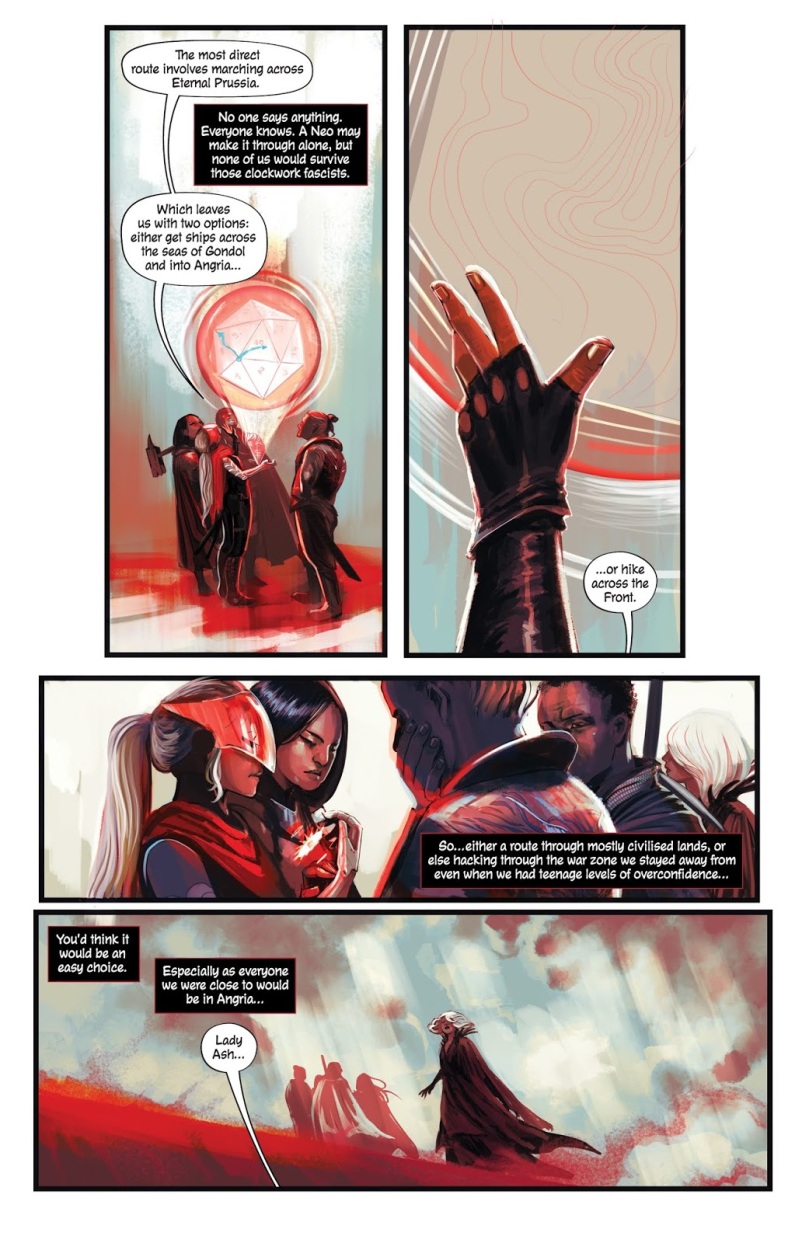
14. “You can’t help yourself… you are Apocalypse”, Uncanny X-Force (2010) #4
Here’s a moment that is heavily carried by the art. Rick Remender’s Uncanny X-Force is great, but this moment, which is otherwise not that spectacular, is elevated by an understated use of layouts and not only established that this would be a very different X-Force run, but also the threat to come — one of morality, rather than overt force.
After the new, black ops and secretive X-Force team has hunted down the rejuvenated form of Apocalypse, they are at a crossroads when Psylocke refuses to allow them to kill the now child despot. The team debates before falling to infighting, before Angel finally gets the upper hand after wrestling with his inner demon, Archangel. When Apocalypse says he won’t become who they think he’ll become, Angel says he won’t be able to stop himself and goes in for the kill… only to hesitate… then Fantomex kills Apocalypse anyway. The team leaves with no fanfare or celebration.
The art is what really sells this scene. The fight between the X-Force members is well done and easy to follow, and the narration from Warren is executed very well with some great lettering, but that moment when Angel says that Apocalypse will always be a monster, and the art slows things down with wide panels and extreme close-ups and a peak into Warren’s soul, that is what sells this moment. It is a powerful pause in time that and scene that is emblematic of what the run would entail — wrestling with morality, nature vs. nurture and struggling with one’s inner demons.
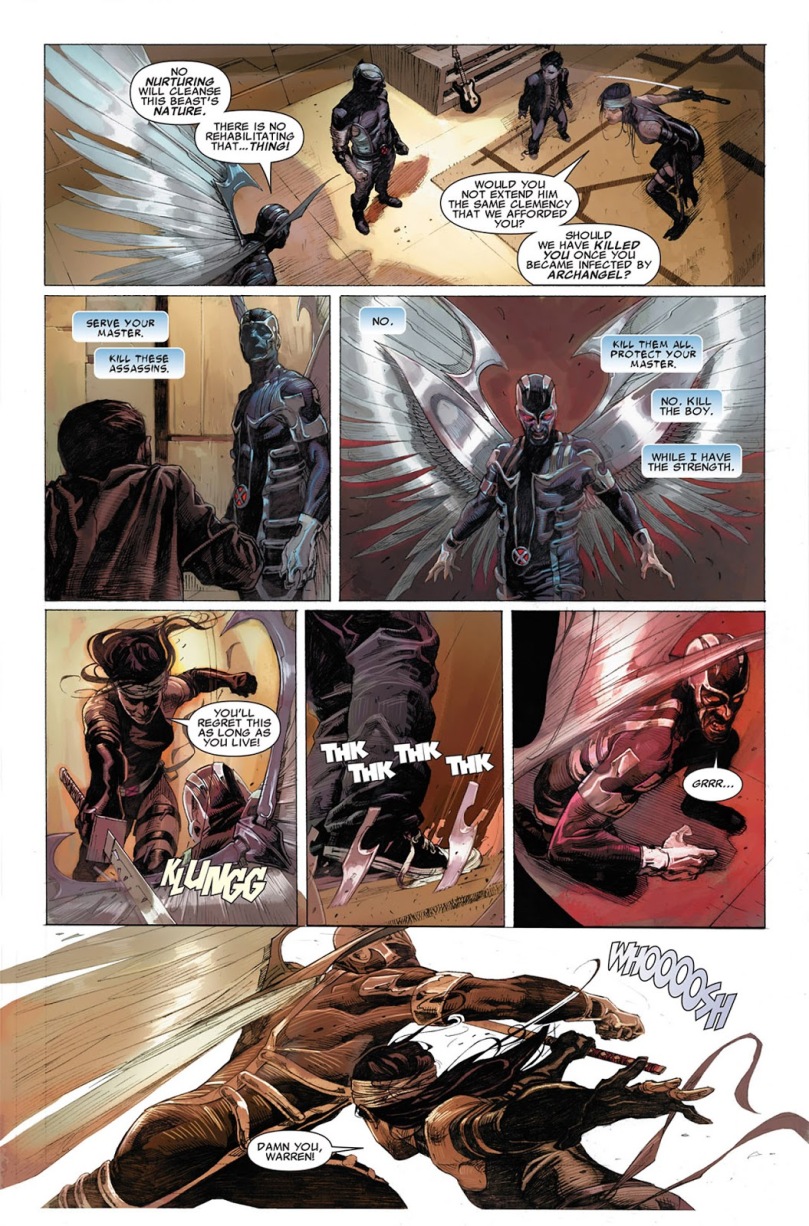
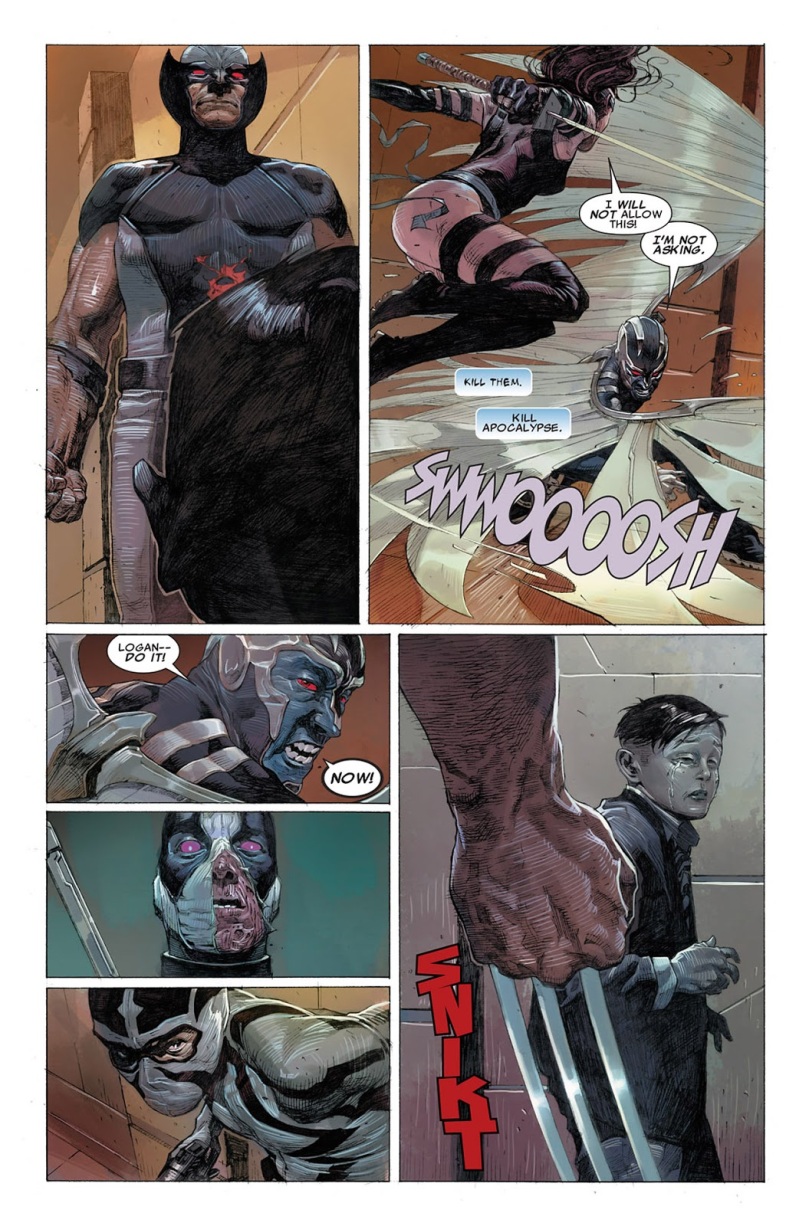
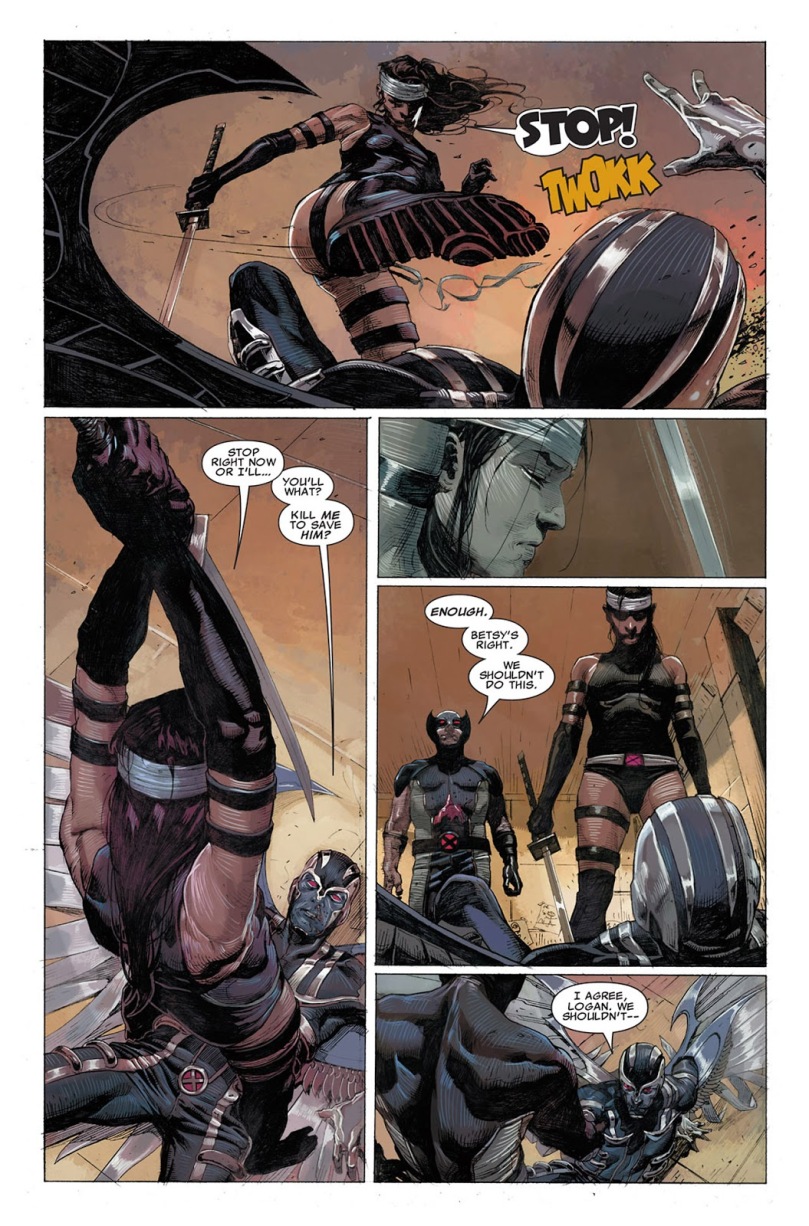
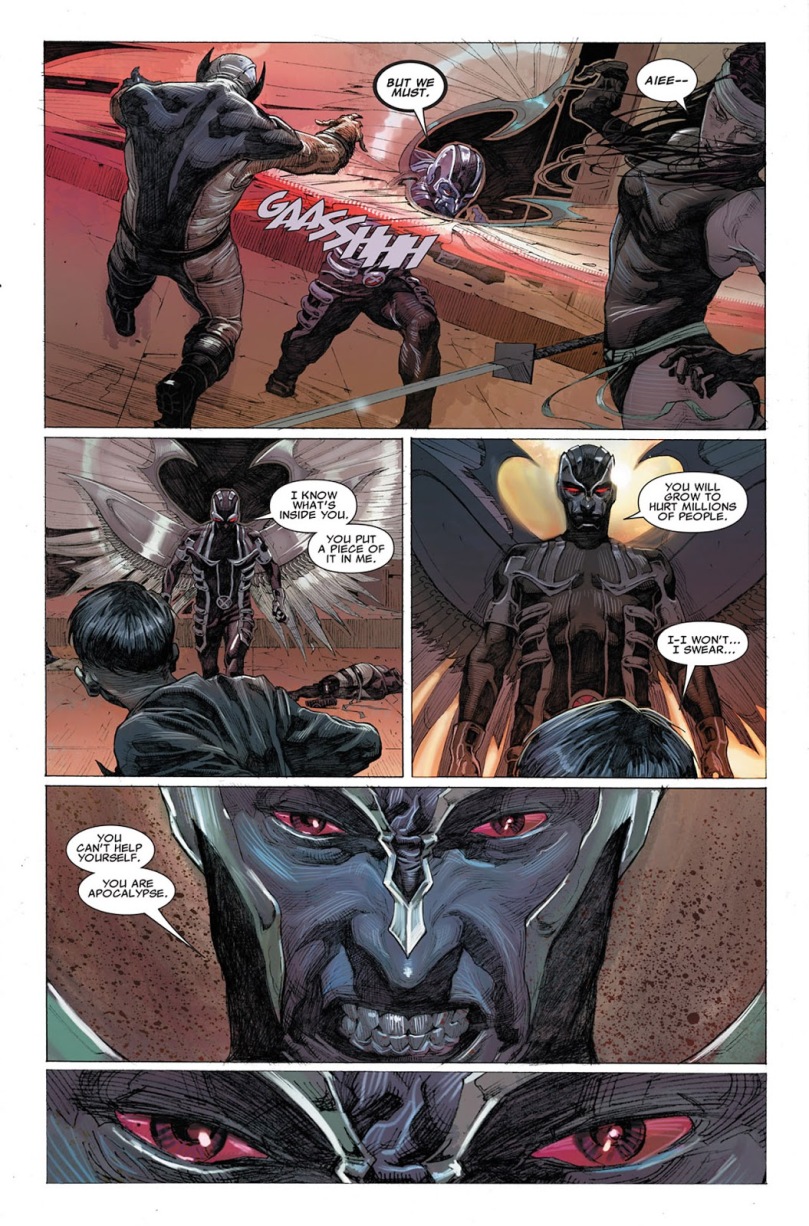
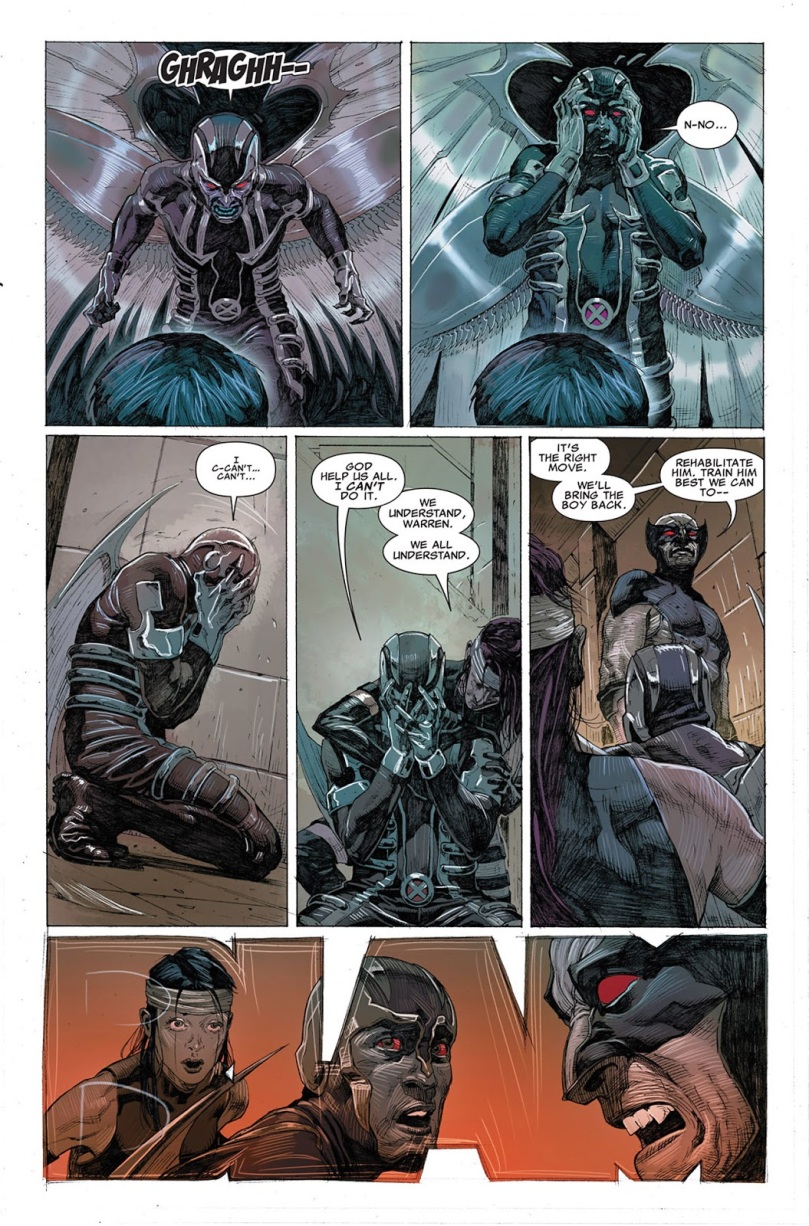
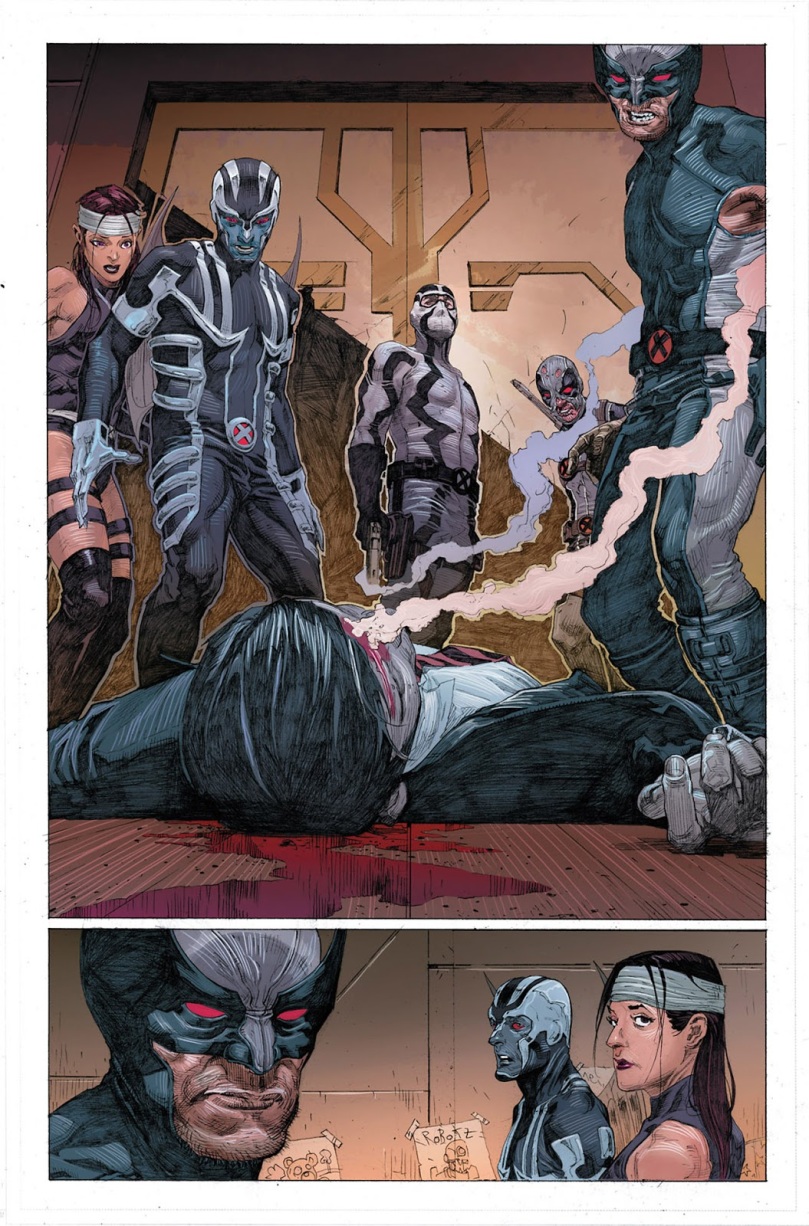
13. “I think about it every day”, Grayson #12
Grayson is a series I will never shut up about, because it just works so much better than it should. Taking Dick Grayson out of the world of superheroes and putting him in the more morally ambiguous and backstab-prone spy world allowed Tom King and Tim Seeley to get to the root of his character, and make it all the more satisfying when he returned to the world of capes and tights. Case in point: Grayson #12, where Dick reunites with the Batfamily. While every reunion is great, the one that was the best executed in my mind is Dick’s reunion with Barbara Gordon.
Dick is reuniting with his family after his boss at Spyral forces him to come back to the organisation. She lets him get in his goodbyes, however. Having already spoken to an amnesiac Bruce Wayne, he went on to talk to Jason Todd and Tim Drake and gave them a gift of two batarangs, and is now talking to Barbara. Dick had previously run into her in his secret Spyral identity, but she didn’t really know it was him. He tries to explain why he did what he did, but she’s not having it and leaves. Dick jumps after her… off a bridge, and gives her the trapeze pole from when they swung together after she was crippled in The Killing Joke, and confesses all his unspoken feelings for her.
There’s really nothing more to this moment than that, it’s just Dick and Babs reuniting and Dick telling her what she means to him. It’s heart-warming and cute, and the whole “Cluemaster’s Code” that Dick is using — the first letter of every sentence will spell out the real message — is used really well this issue, but I like that Dick repeats himself when he says he’ll come back to her. It’s as if he’s willing to muddle the message and Barbara understanding it just to reiterate how important she is to him. This moment wouldn’t properly go anywhere, since Tim Seeley set Dick up with a new love interest in a terribly executed romantic subplot in his Nightwing run, but for a moment, one of the best relationships in comics got a moment in the sun.

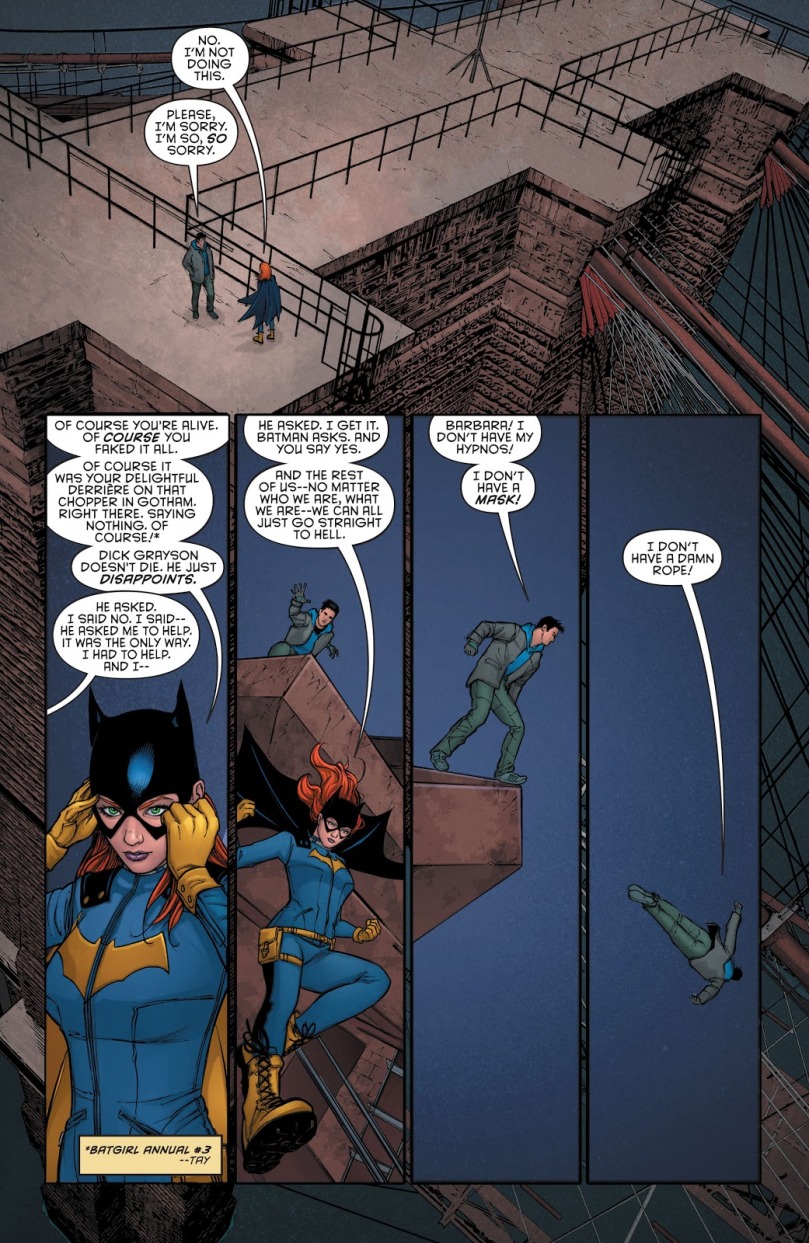

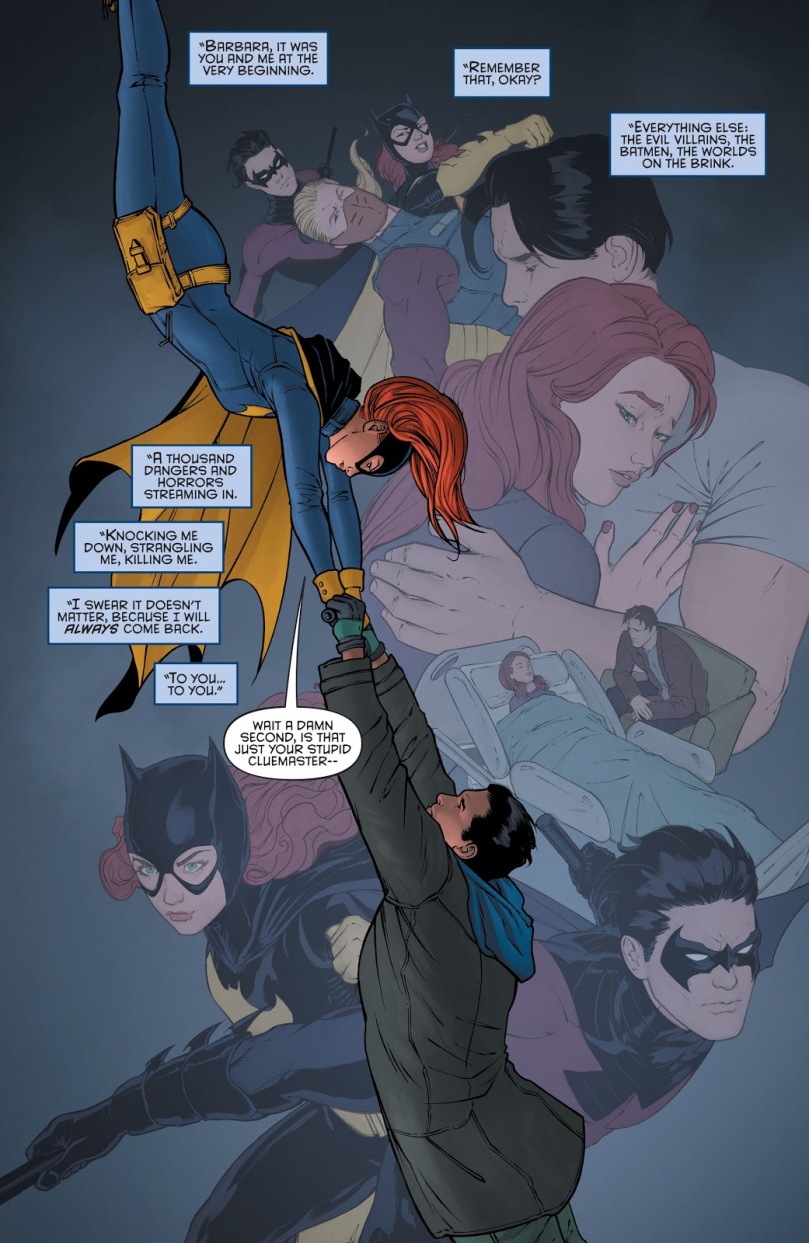
12. “You’re poison”, The Sandman Universe Presents: Hellblazer #1
Hellblazer is at its best when it acknowledges what a toxic influence John Constantine is on his friends and family. Very few people come out of their interactions with him unscathed and his addiction to magic only guarantees that those around him will have a rough time of it. Nowhere is that better demonstrated than with how his long-time friendship with Chas Chandler ends, which ushered in a return to form for Constantine.
After coming back from a terrible future and promising his future self to live his best life, Constantine goes to visit his friend Chas. He learns that, since his absence, Chas has contracted cancer and is now in the cancer ward of a hospital. Upon his visit, he finds demons possessing Chas and goes to free his friend, using the bodies of other cancer patients, only for Chas himself to call John out on his years of being a prick, his abandonment and the fact that John gave him cancer. Constantine’s constant smoking in Chas’ cab is what it’s attributed to and he tells John to leave him alone and fuck off. John respects his friend’s wishes just before Chas dies and John is left truly alone.
Despite how their friendship ended, this issue also did a great job giving it something of a heart-warming ending… sort of, as in the future, John tricks Chas into essentially performing a magic suicide bombing, but Chas, ignorant of this, tells John that sometimes you need to step up and be a hero. Both scenes work together to show the nature of this friendship — Chas is a good person at heart and one whom Constantine values and trusts… but he’s still someone Constantine will manipulate, and who will call John out on his bullshit. It’s a fitting end to the character and a great way to kick off this new era of Hellblazer.
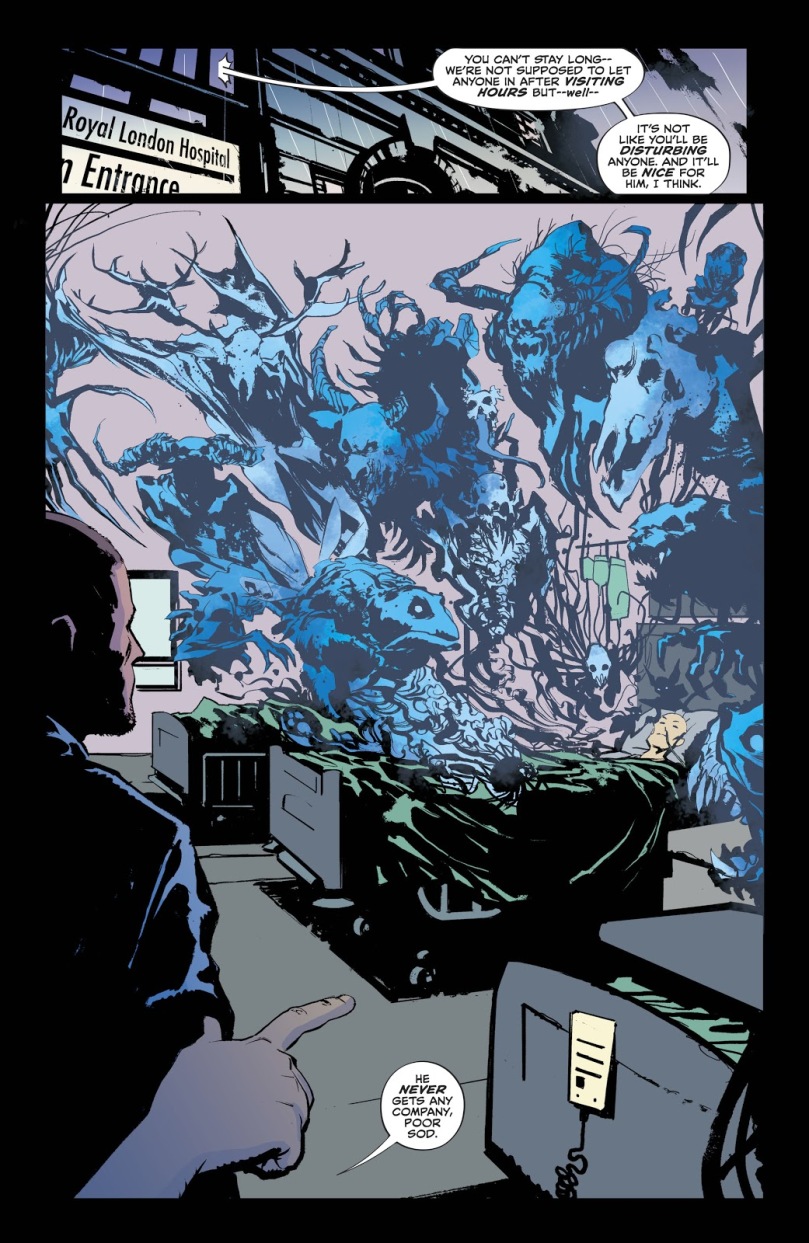
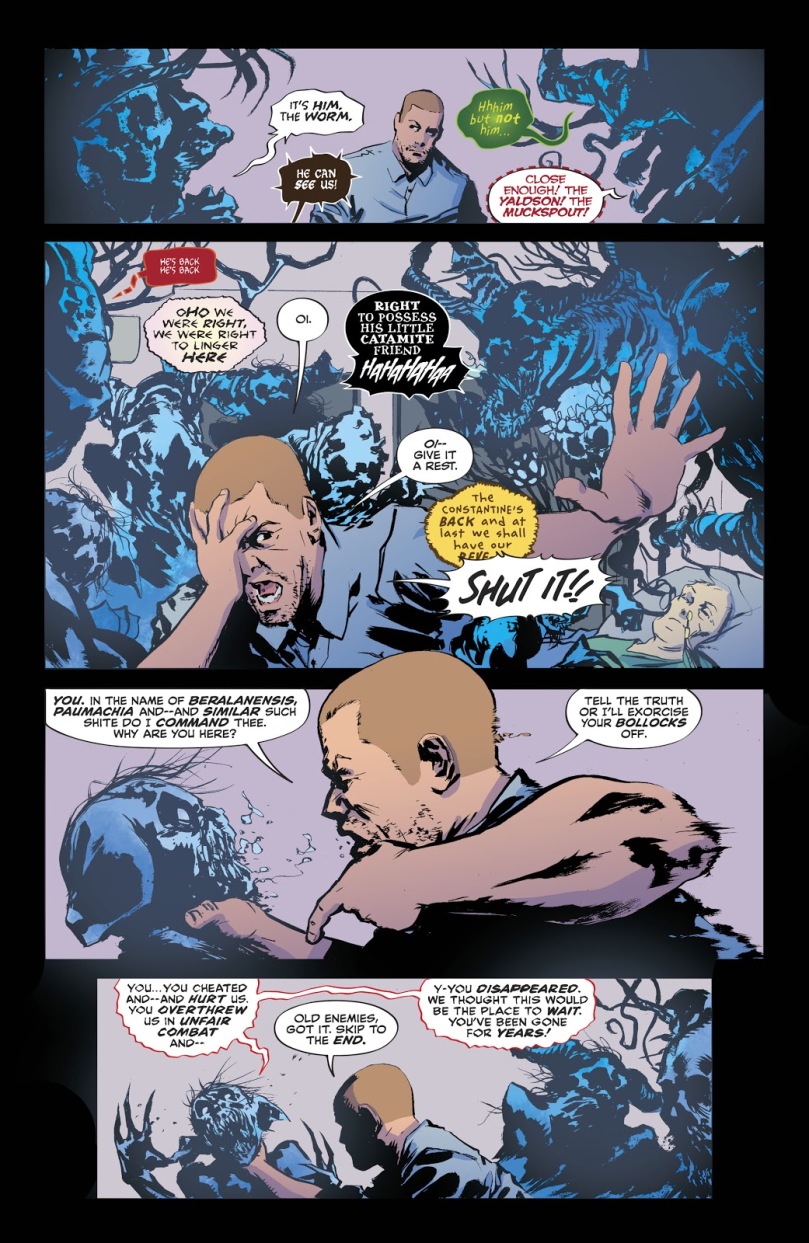
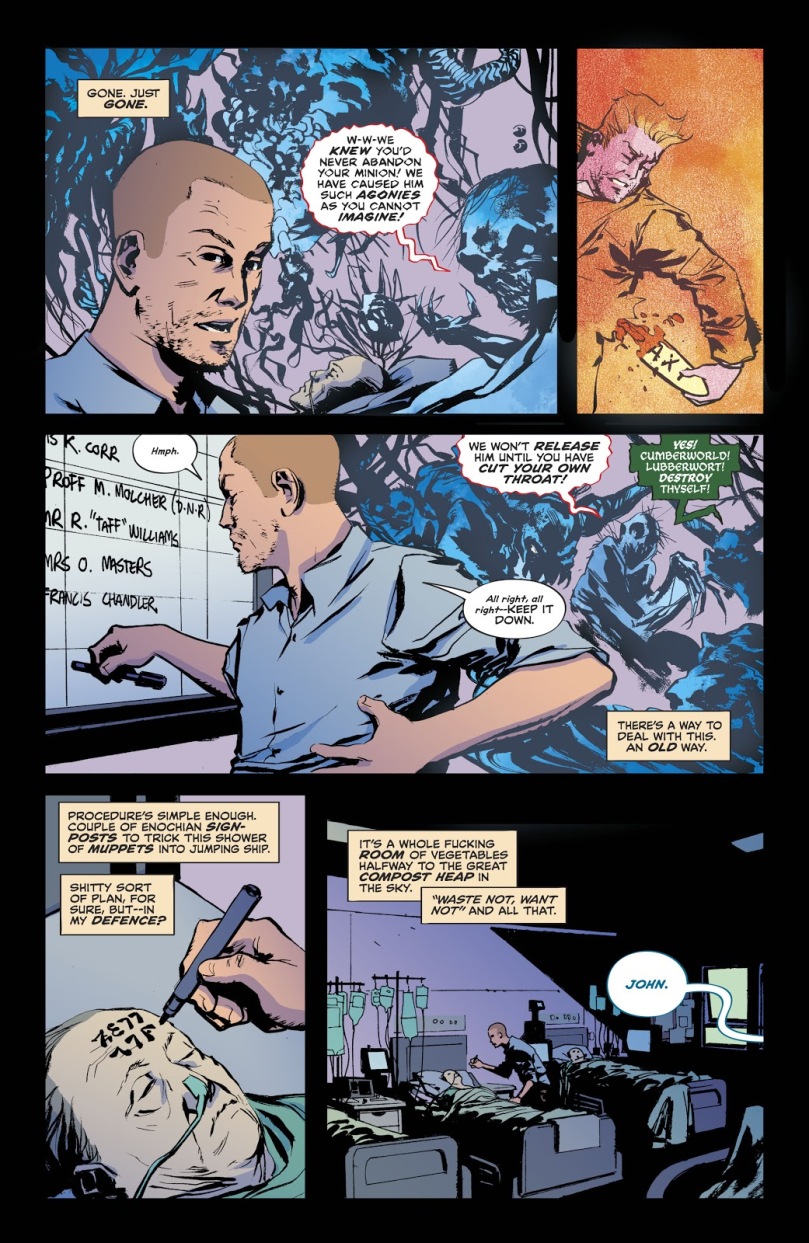
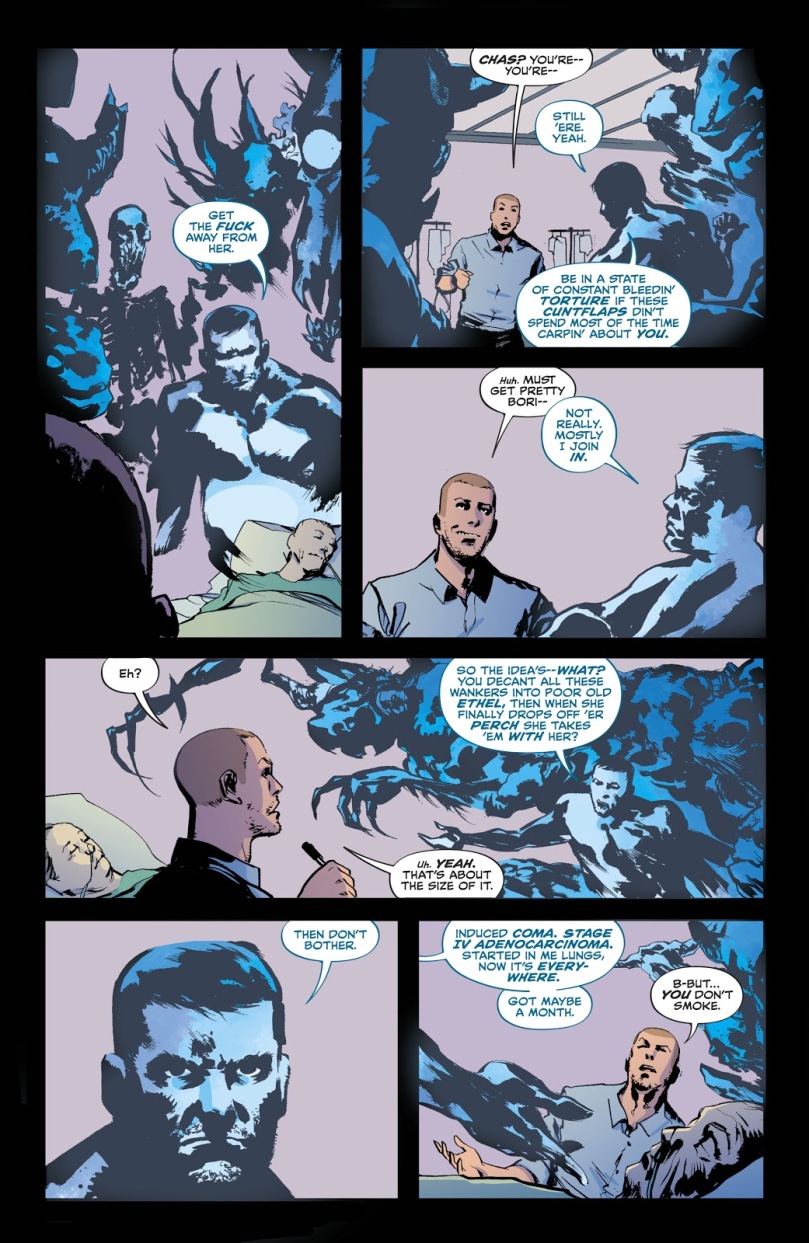
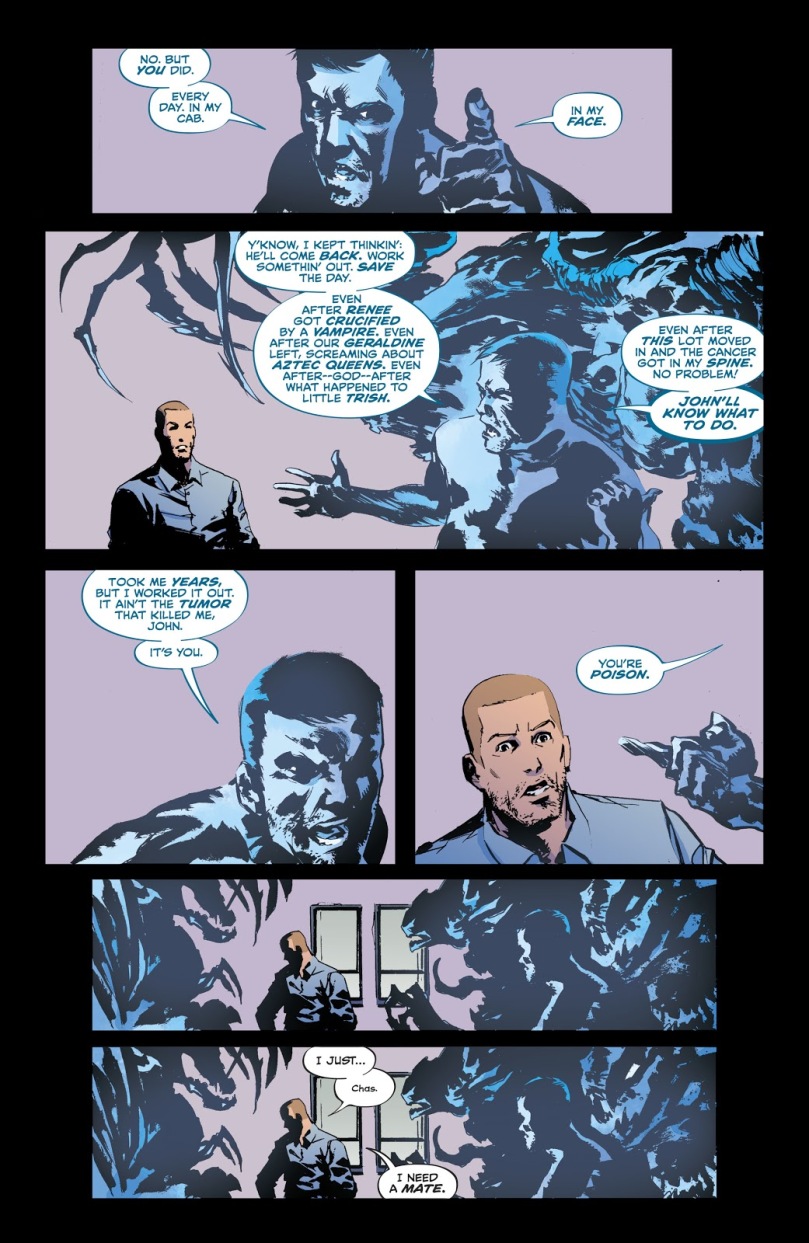


11. “I thought you loved me”, Venom (2018) #11
The relationship between Eddie Brock and the Venom symbiote has always been some level of abusive, but whether or not it’s a romantic relationship has generally not been touched on where it can be avoided. Maybe it’s the idea that Venom fans wouldn’t want a gay relationship, maybe it’s fear of the repercussions of a negatively portrayed gay relationship — the symbiote is identified as male a few times, after all — or maybe it’s just weird that Eddie is in a romantic relationship with alien ooze. But in the end, it’s usually more allegory and not so much a literal romantic relationship… until now, and it is glorious.
After a handful of issues of the Venom symbiote lacking its voice and Eddie’s cancer resurfacing, the Maker is able to “fix” Eddie while he goes through his memories and learns that certain parts were fake — his sister and initial cancer diagnosis being the primary ones he focuses on. He confronts the Venom symbiote, which can speak again, about why it changed his memories and it says Eddie needed to need it. They argue and Eddie wakes up to protect Dylan Brock, who he has just learned is his son.
Eddie’s relationship with the symbiote has always been destructive and unhealthy, and Cates fully leans into that here. The symbiote has manipulated Eddie into staying with it, forced him to become Venom and lied to him about his son. It has fully become an abusive lover and the sheer superhero-ness of this scene lends it a sense of self-awareness in what could otherwise have devolved into melodrama. However, Donny Cates is still able to end the scene with such conviction that it carries all the weight it was supposed to.
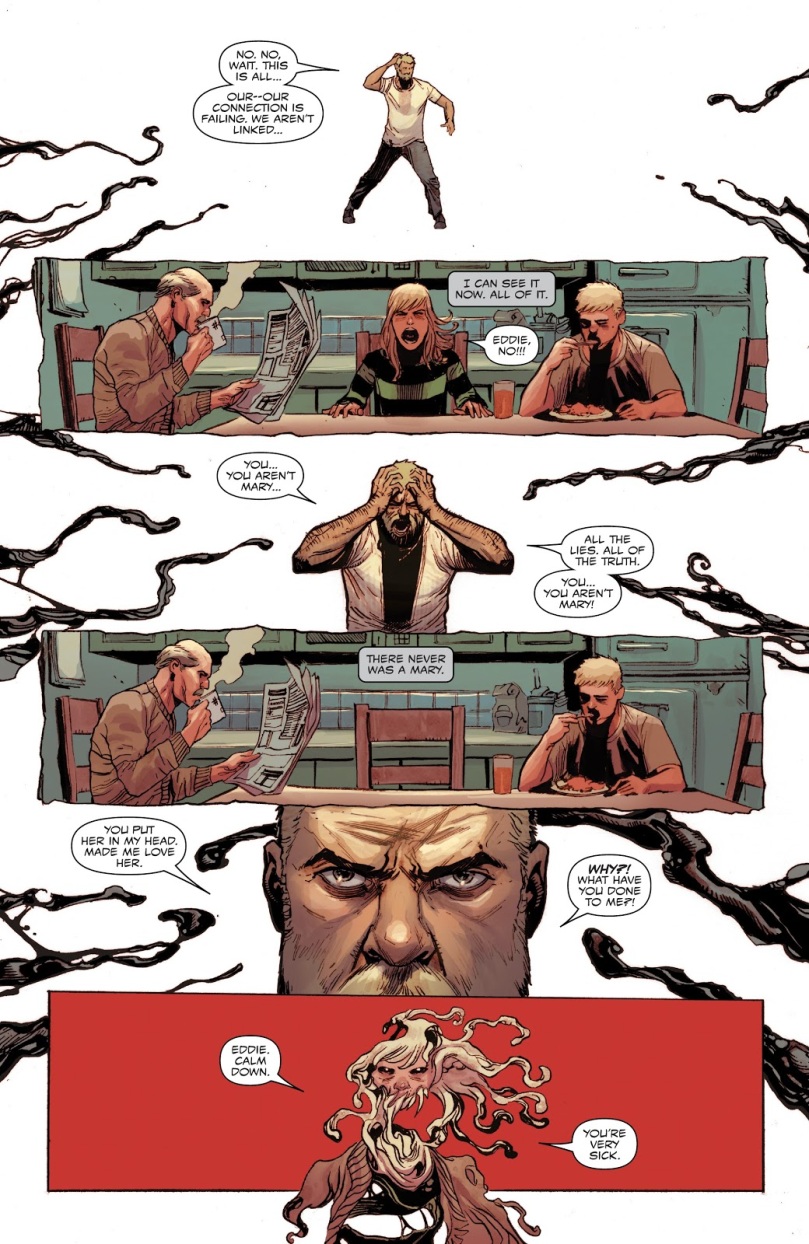

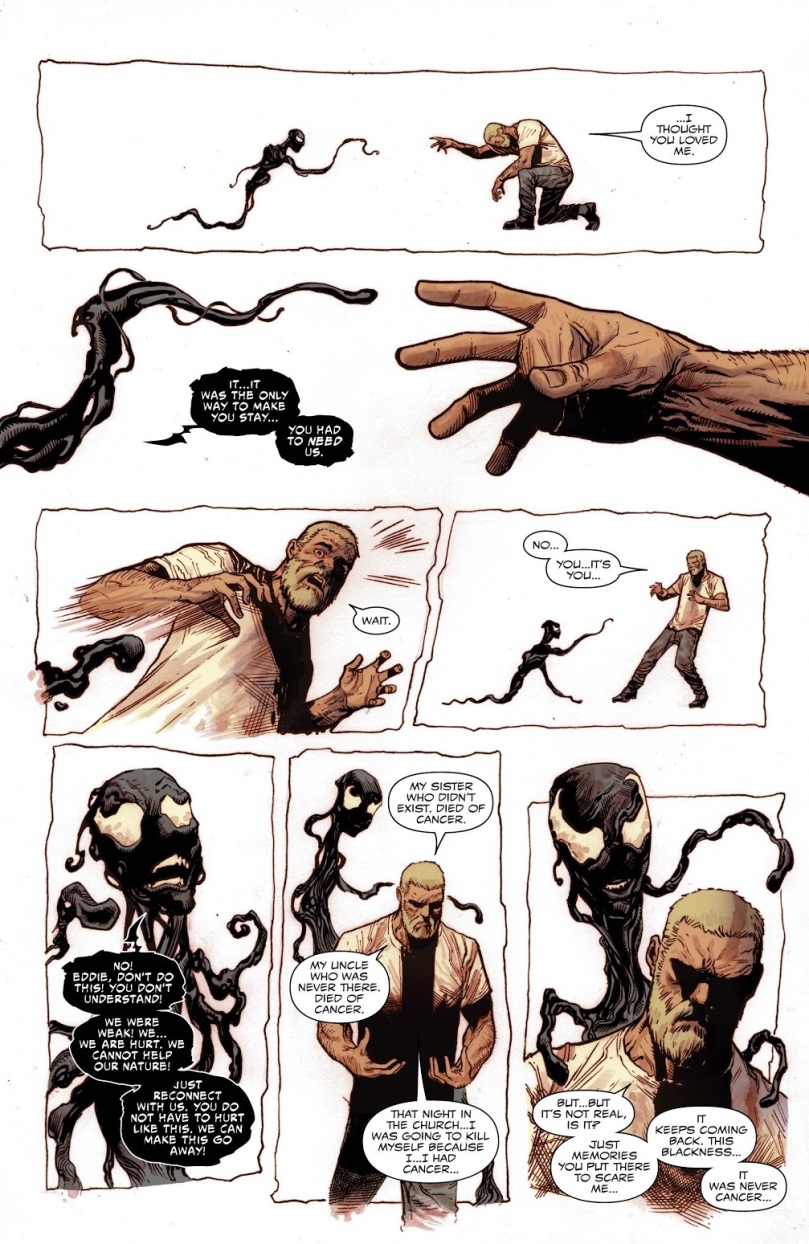

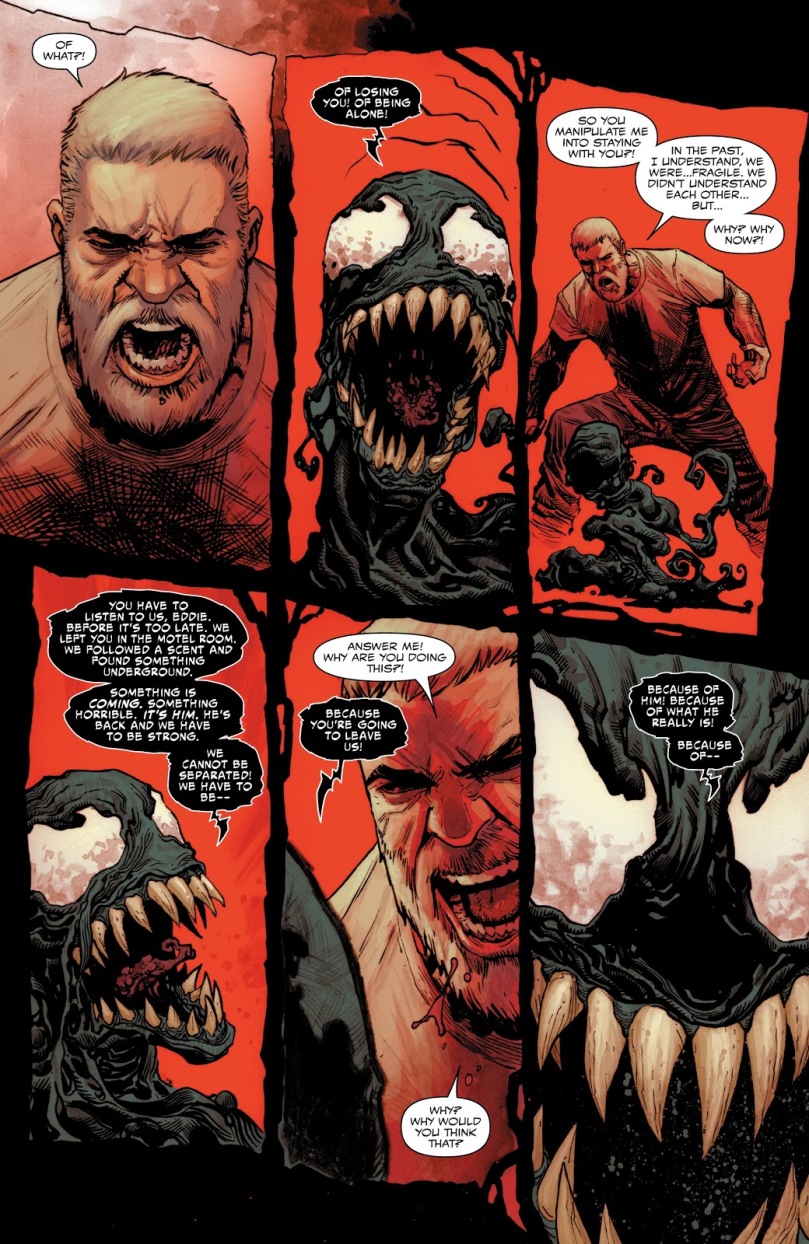
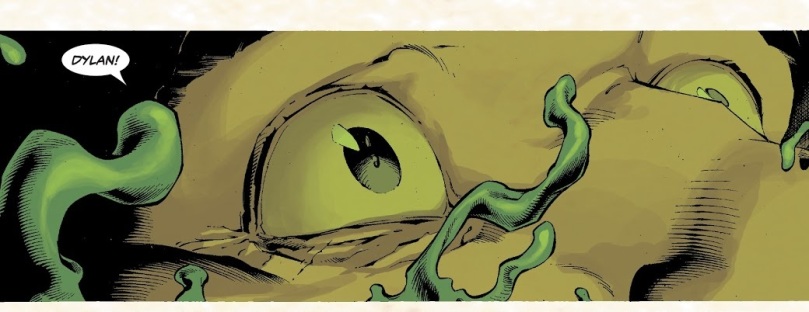
10. “Smoke the meat”, Animosity #7
The biggest strength of Animosity is Marguerite Bennett’s keen eye for worldbuilding. The basic premise of “what if animals suddenly became fully aware” is explored for all it’s worth, with small bits of worldbuilding that truly make the world of Animosity feel alive yet not too divorced from our own. The way Bennett uses these little pieces of worldbuilding to craft a nuanced and morally grey story is what really sells this series, and nowhere is that more apparent than in Animosity #7.
The scene in question deals with the aftermath of a fight the main characters get into, where they run into some carnivores. While everyone else tends to their wounds and gets some rest, main dog Sandor and the cat Pallas go to deal with the aftermath. They find their dead friends and we learn what they’re actually doing, and that it’s not uncommon — they eat the corpses of the dead. This time, they bury their friends, but the other animals that were killed are eaten all the same, and this isn’t the first time Sandor and Pal have done this, nor is it expected to be the last, and Sandor reminds Pal that, when Sandor himself dies, to feed him to his owner Jesse.
The scene is a wonderfully dark revelation, in a story where we learned more and more about what Sandor will do to protect his owner. It plays really well off the previous issues and does a great job escalating the moral ambiguity of the story. It not only adds more moral complexity to the wider world of Animosity, but furthers the story and characters. Every part of Animosity feels well thought out, and this moment not only advances the world but the story, in an unexpected and dark way.
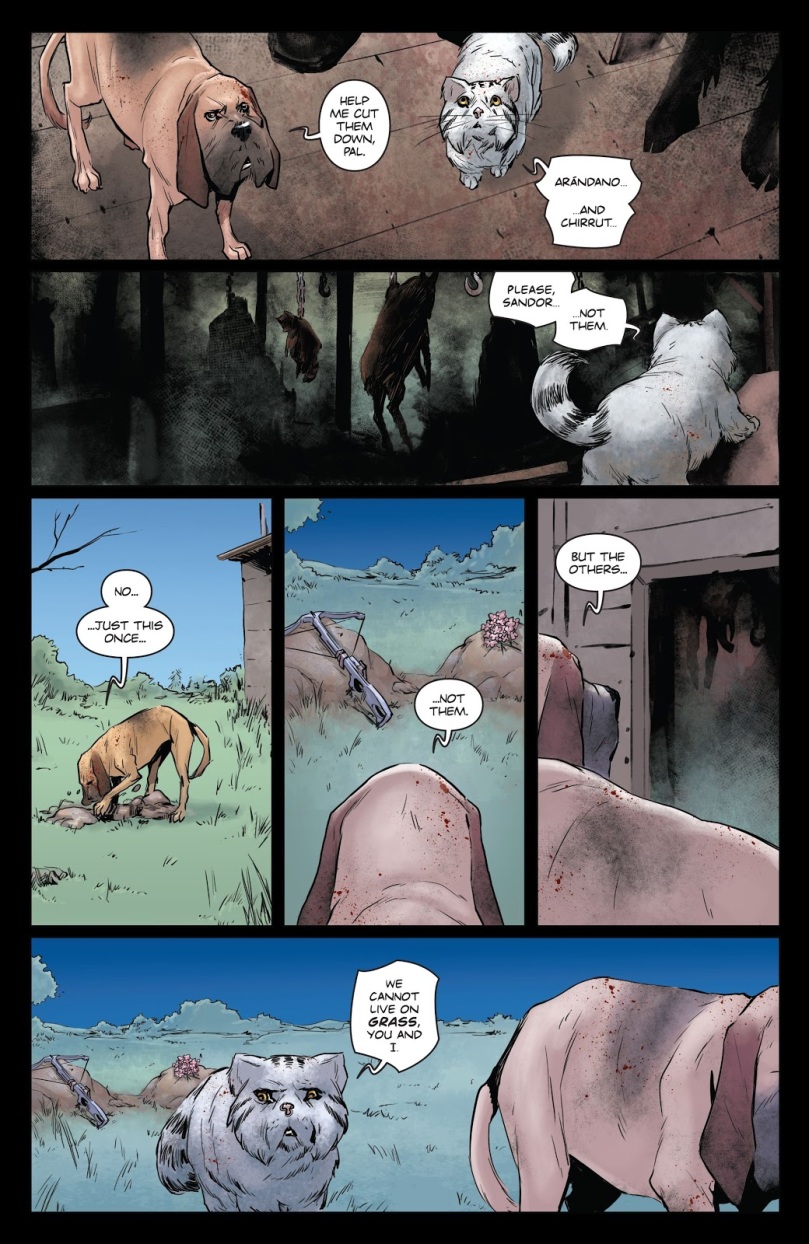

9. “He has you and me”, Doomsday Clock #12
DC Rebirth was a relaunch that truly returned some of what the DC universe had lost that made it so great. It lamented the loss of love, legacy and optimism, all of which were indeed sorely lacking, and told a story of how corrupting outside forces altered the DCU’s history and characters to better reflect a cynical outlook. Well, Doomsday Clock finally ended last week, and for all its faults and the discussions that can be had concerning creator rights and Watchmen, I think it delivered on its promise — the return of love, legacy and optimism, the latter of which was best exemplified in the return of the Justice Society of America and, as a result, the Legion of Super-Heroes and Ma and Pa Kent.
After Flashpoint, it was established that Clark Kent had lost his parents at a young age, after they were hit by a drunk driver. Even after the Superman Reborn crossover patched up Superman’s history to essentially be the post-Crisis one — with some New 52 stuff sprinkled in here and there — he still had dead parents. Doomsday Clock revealed that Doctor Manhattan had caused the Kents’ accident, in order to transform Superman into a more cynical figure that he could relate to. However, after Superman inspires him, Manhattan believes in the ideals of love, legacy and optimism and undoes his changes to the timeline — or at least most of them, since DC’s plans clearly changed as this story was being published — and the restoration of the Justice Society of America is what kicks things into gear. Not only are the JSA my favourite superhero team, but their existence now changes Jonathan Kent’s outlook — instead of a cynical, protective outlook that causes him to discourage Clark using his abilities, the JSA’s existence causes Jonathan to encourage Clark instead, and he saves his parents as Superboy. The emergence of Superboy in turn causes the Legion of Super-Heroes to exist again. And they save the day, and all ends well, and Clark goes to reunite with his parents.
This moment is the perfect pay off to the entire Rebirth saga. There’s some wonkiness here as a result of rewrites, clearly. The Legion of Super-Heroes, as written now, are not inspired by Clark as Superboy but by Jonathan Samuel Kent as Superboy helping to found the United Planets, but the dialogue pretends like this is the Retroboot Legion from a few years back. Ignoring that, however, this moment just works. After the darkest parts of the story, with Imra fading away and Johnny Thunder broken and defeated, Superman’s inspiration is what undoes the changes and brings those people back. The legacy of the JSA that creates a new world of optimism, one that extends into the far future, and the return of the Kents is just makes it that much more satisfying that optimism and hope won out. This is a perfect ending to the story that Geoff Johns began in 2016, one that embraces what the DCU is about, even through its various reboots.
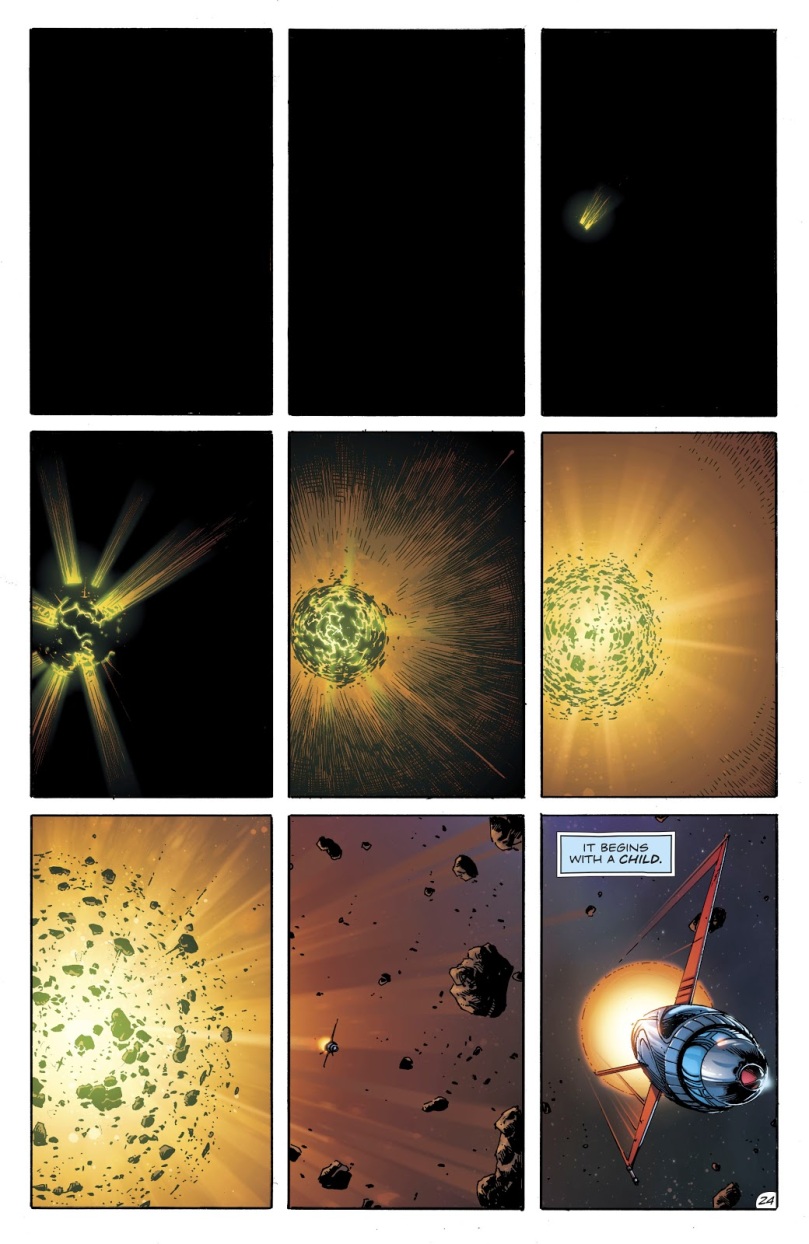






8. “I’ll still hold your hand”, Doom Patrol (2016) #1
Gerard Way’s Doom Patrol run is a bit uneven, at least if you read it as it was ongoing like I did (you know, when every issue after the second was released late). But the first issue is a great introduction to the Doom Patrol, and the opening scene does a wonderful job setting the tone for Way’s run and introducing a character who is probably one of the best audience surrogate characters in comics.
The scene is pretty short and simple, giving a quick intro to Casey Brinke as she drives an ambulance during her day job. The narration is what sells it, as it carries this sense of poetry and angst that feels like it has enough conviction to be done well. Casey’s narration doesn’t feel ironic, self-defeating or cliché, but oddly reassuring — fitting, given she talks about what her job means to her. There’s some fun, of course, helped by the cartoony visuals and the neon colours, but otherwise it is just a relatively quiet intro to a character.
This introduction to Casey really does set the tone for the rest of Way’s Doom Patrol run, the more modern, straightforward and character-focused run. While there are stranger elements, such as when Casey and Terry None (a woman) have a biological son together and the cult that wants to transport itself inside Crazy Jane, at its core Way’s run was about the characters moving forward with their lives and Casey finding a place on the team. This introduction is great for setting that up, especially since some of the poetic narration is actually literally true, which was a very unexpected twist.
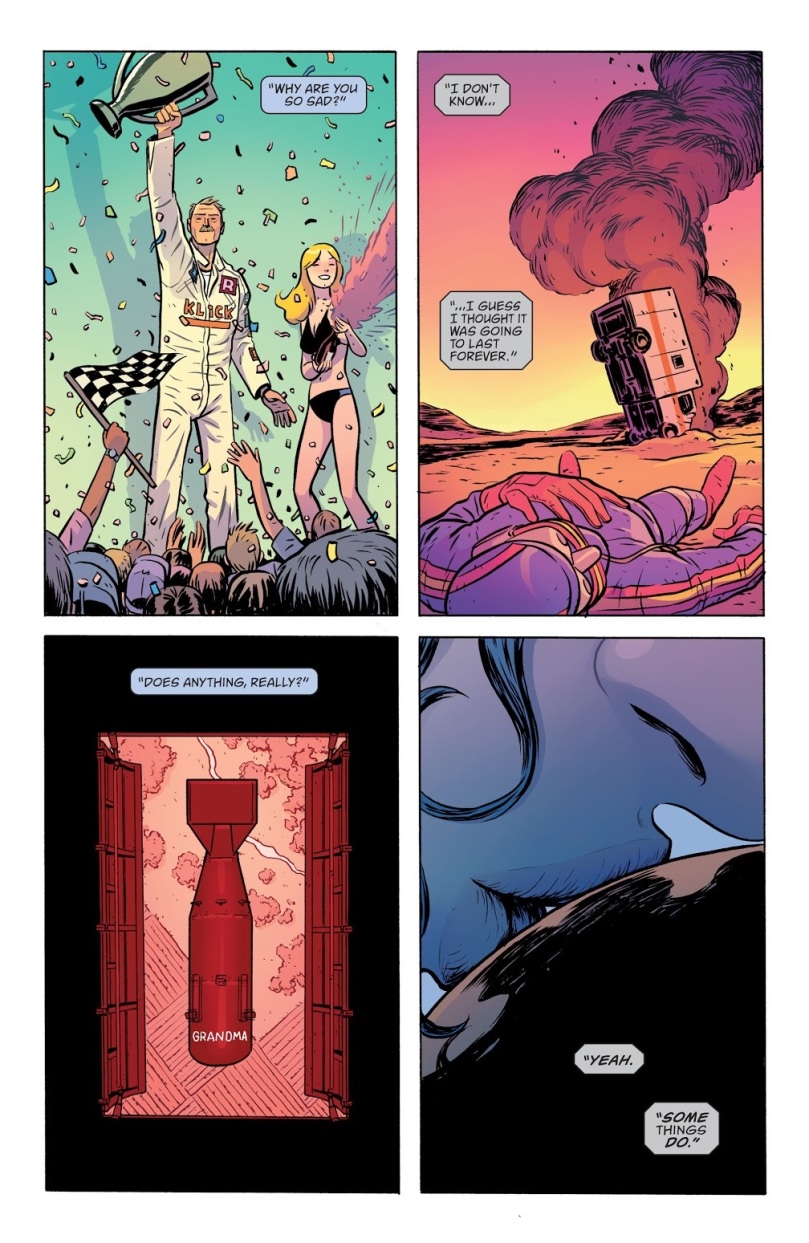
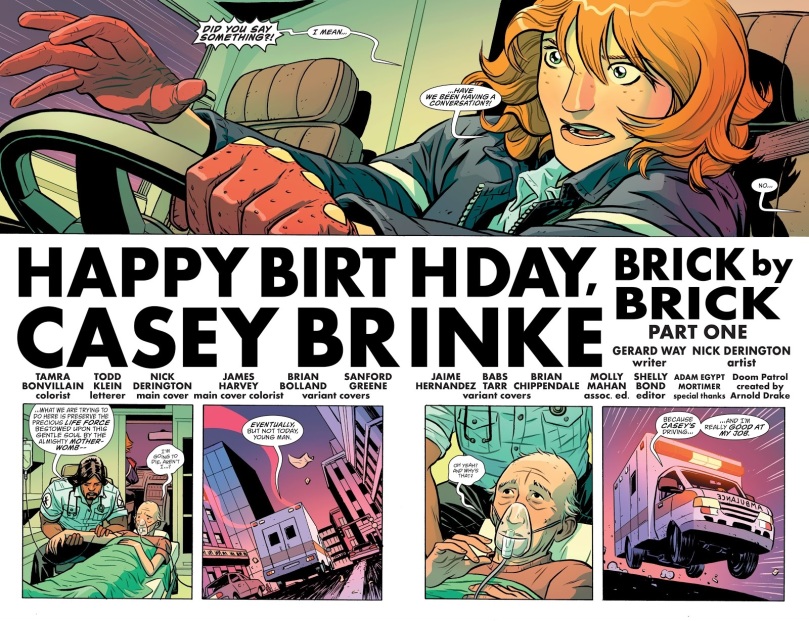
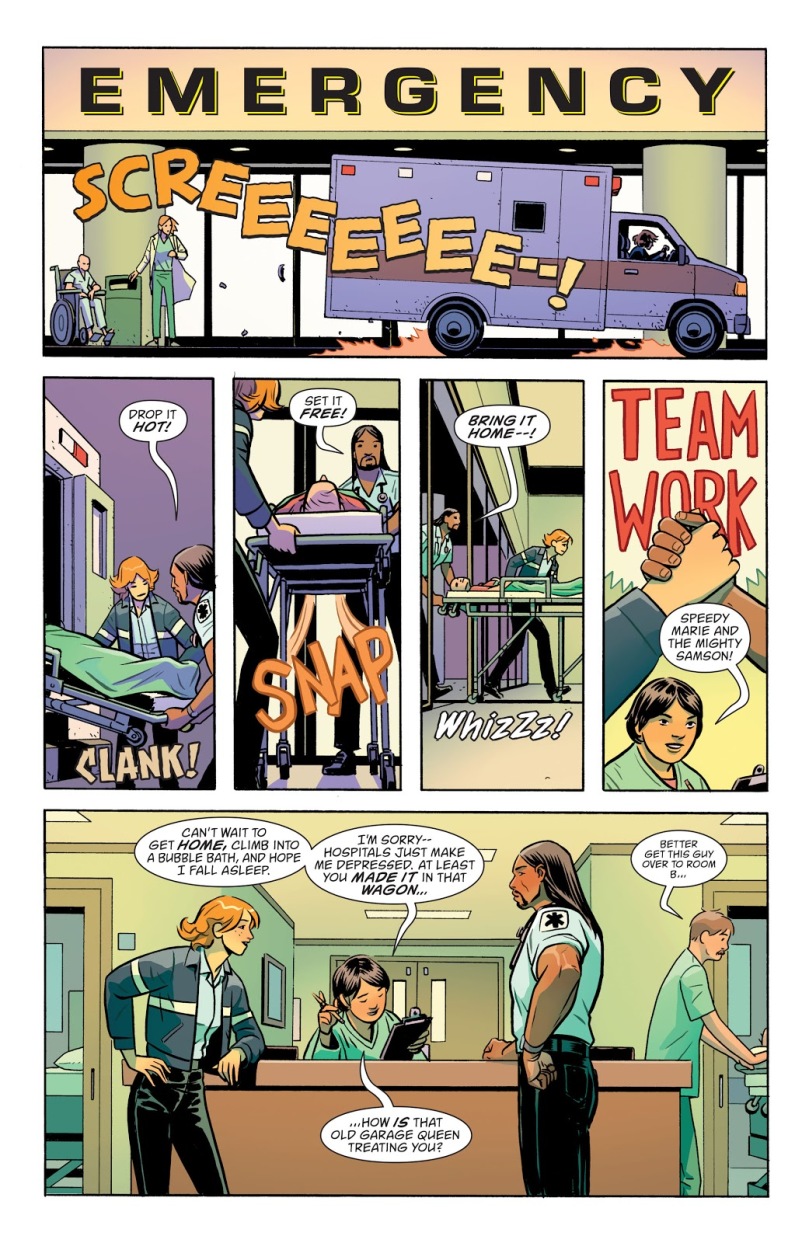
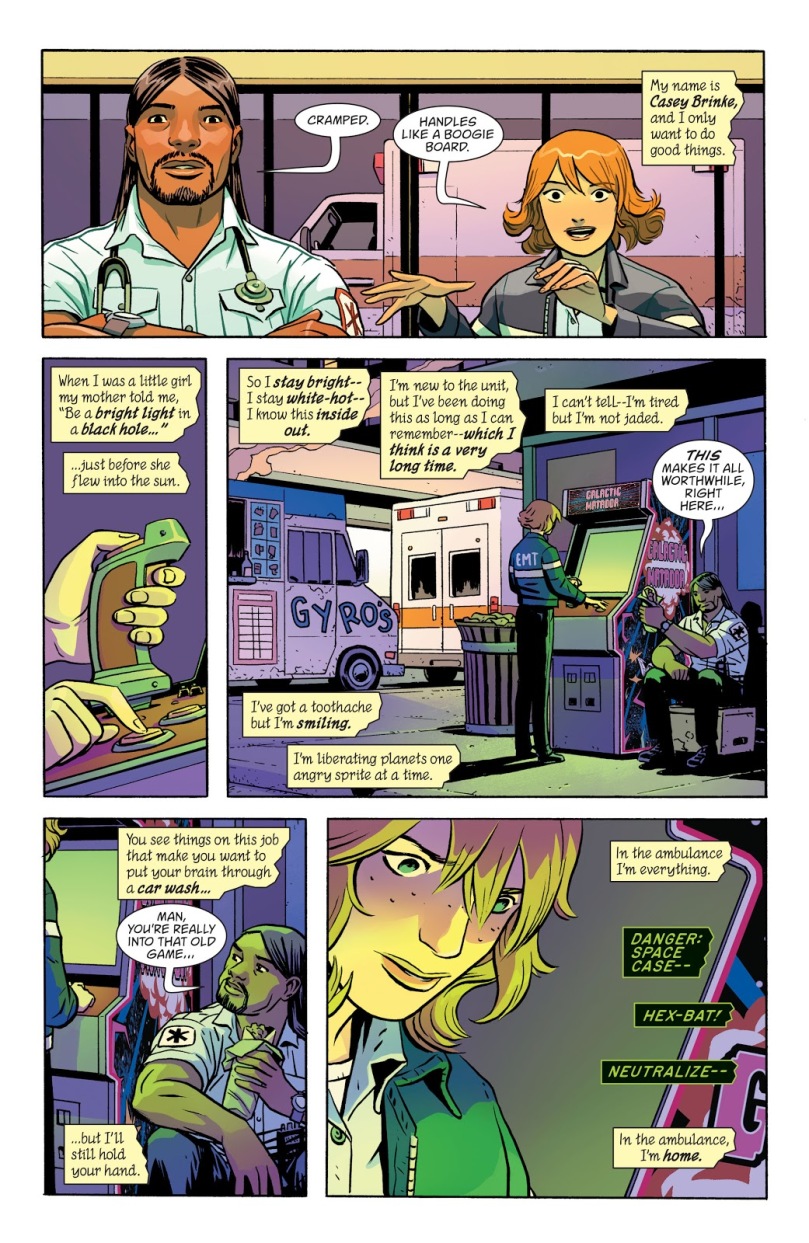


7. “Batman punches people in the face”, Batman (2016) #53
Tom King’s Batman run is a thoroughly mixed bag, but it has moments of brilliance. One such moment is during the “Cold Days” arc, where Mr. Freeze is on trial after being captured by Batman, and a jury discusses his potential conviction. All are in favour of a guilty verdict but one — Bruce Wayne, who laments Gotham’s worship of Batman. This moment is probably the best culmination of Tom King’s Batman run up until this point, and gave real hope that his run would recover after the controversial wedding issue.
With Mr. Freeze arrested and on trial, Gotham’s jury is quick to label him as guilty despite the lack of evidence. Bruce attributes this to Gotham’s hero worship of Batman that he compares to worship of a god, because of the jurors’ perception of Batman is all-knowing, with his will having power over life and death. When asked what Batman means to him, Bruce tells the jurors that after his parents’ deaths, Batman was something he could believe in to keep him going, something he could rely on to always be there and save him. Not anymore; now that being Batman has taken Catwoman away from him, Bruce has become disillusioned with Batman.
This moment, as understated as it is, does a wonderful job paying off what had come in King’s Batman run. Bruce’s suicidal nature, his reliance on Batman as a means of achieving peace, his own obsession to keep fighting as Batman and the recent dissolution of his engagement with Catwoman resulting from his need to be miserable in order to be Batman, it’s all wonderfully played off by this moment that gives the readers a peak into how his breakup has shaken his foundation and made him doubt Batman. King’s run has a lot of flaws, but every now and then it delivered a powerhouse moment.
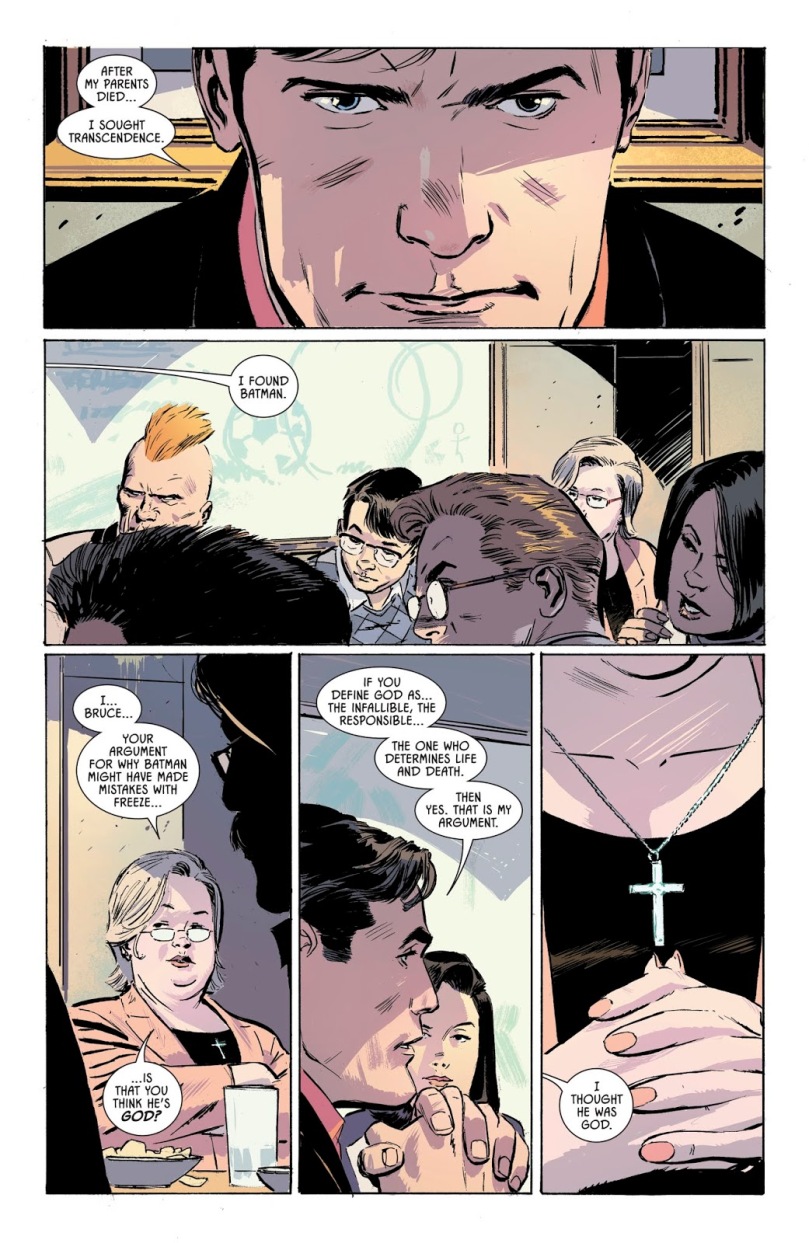
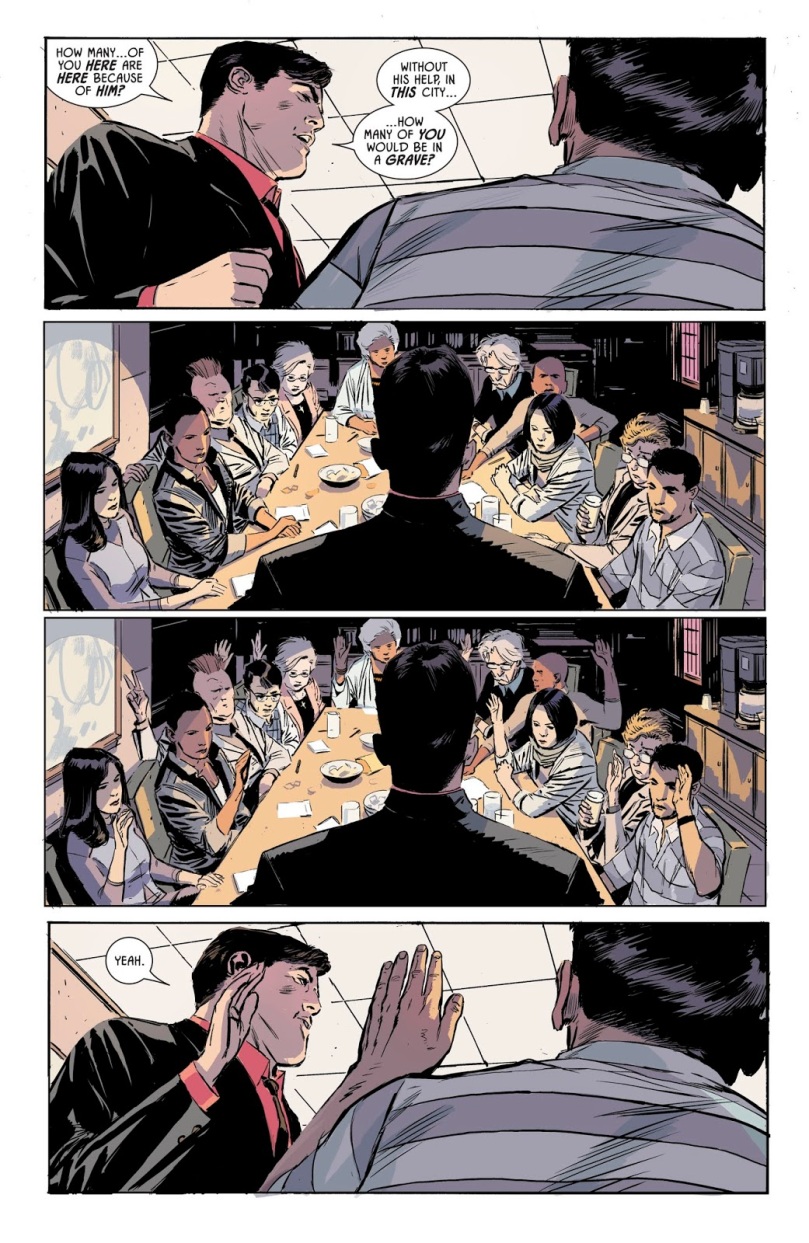
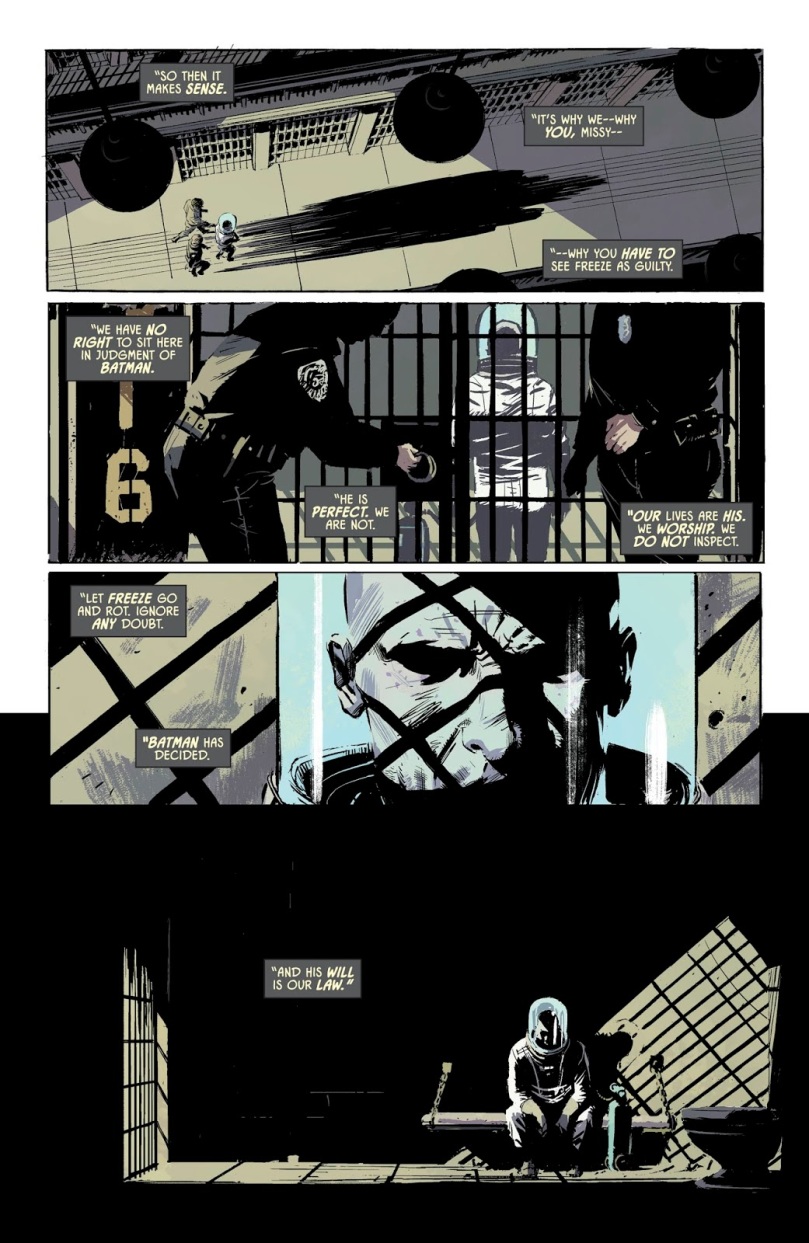
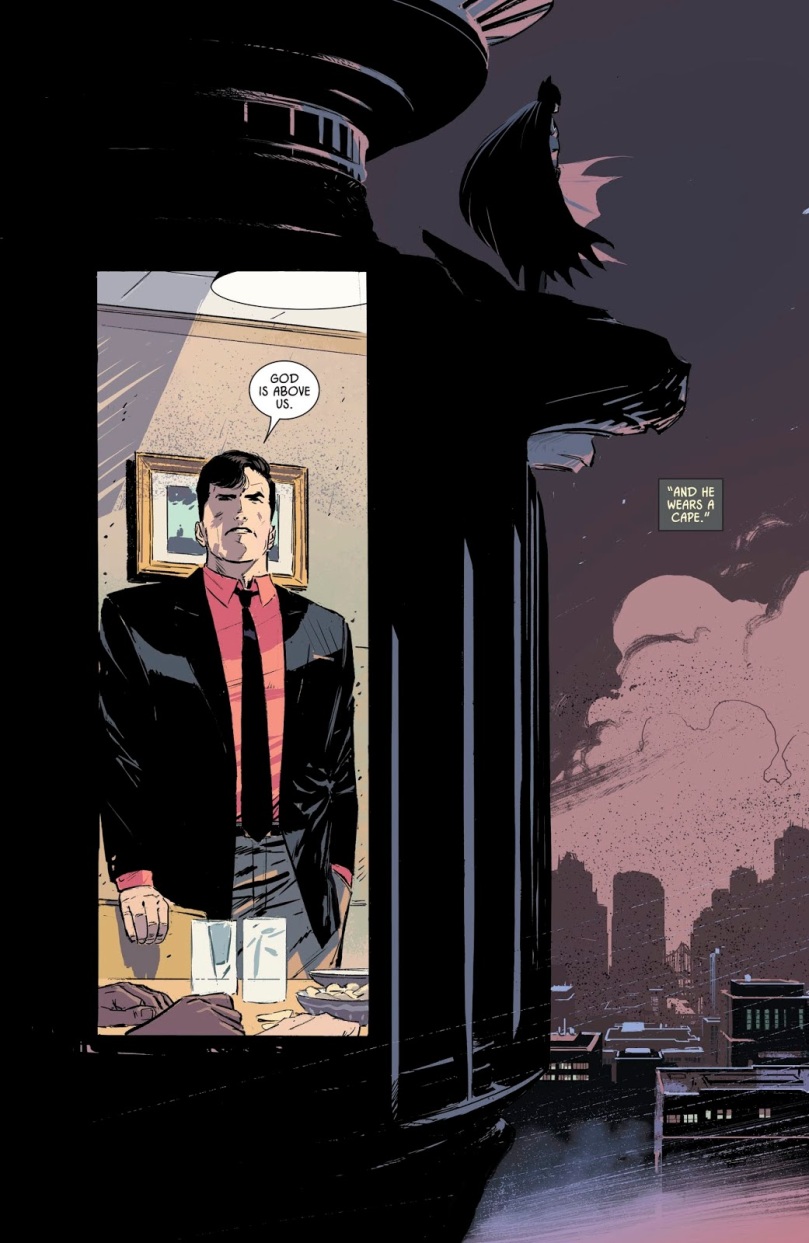
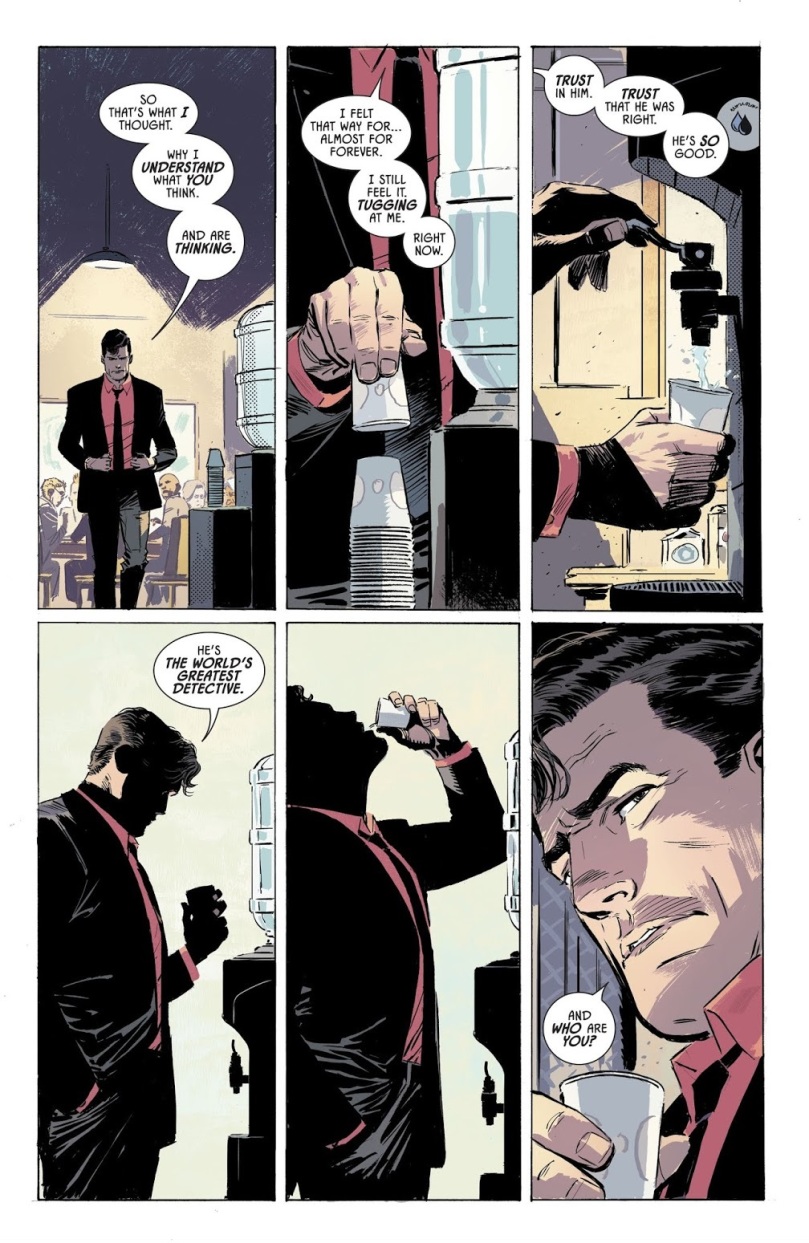
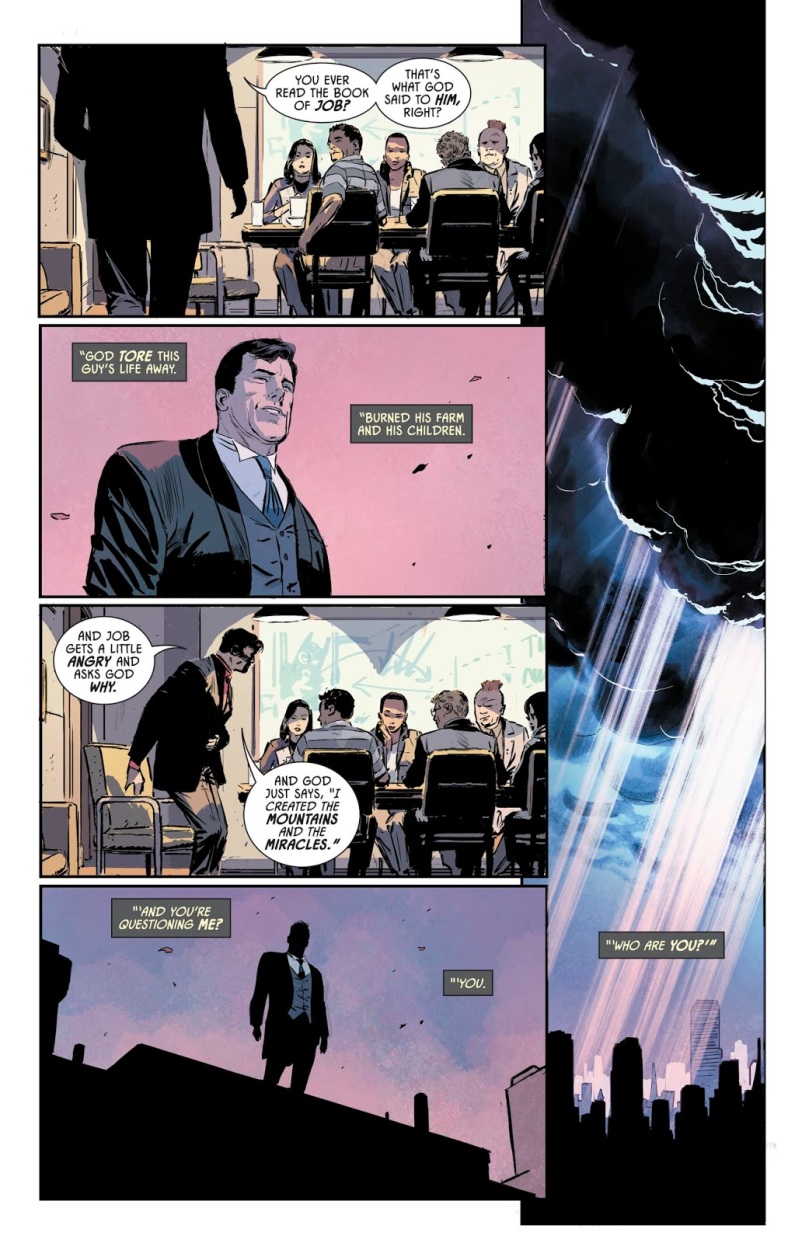
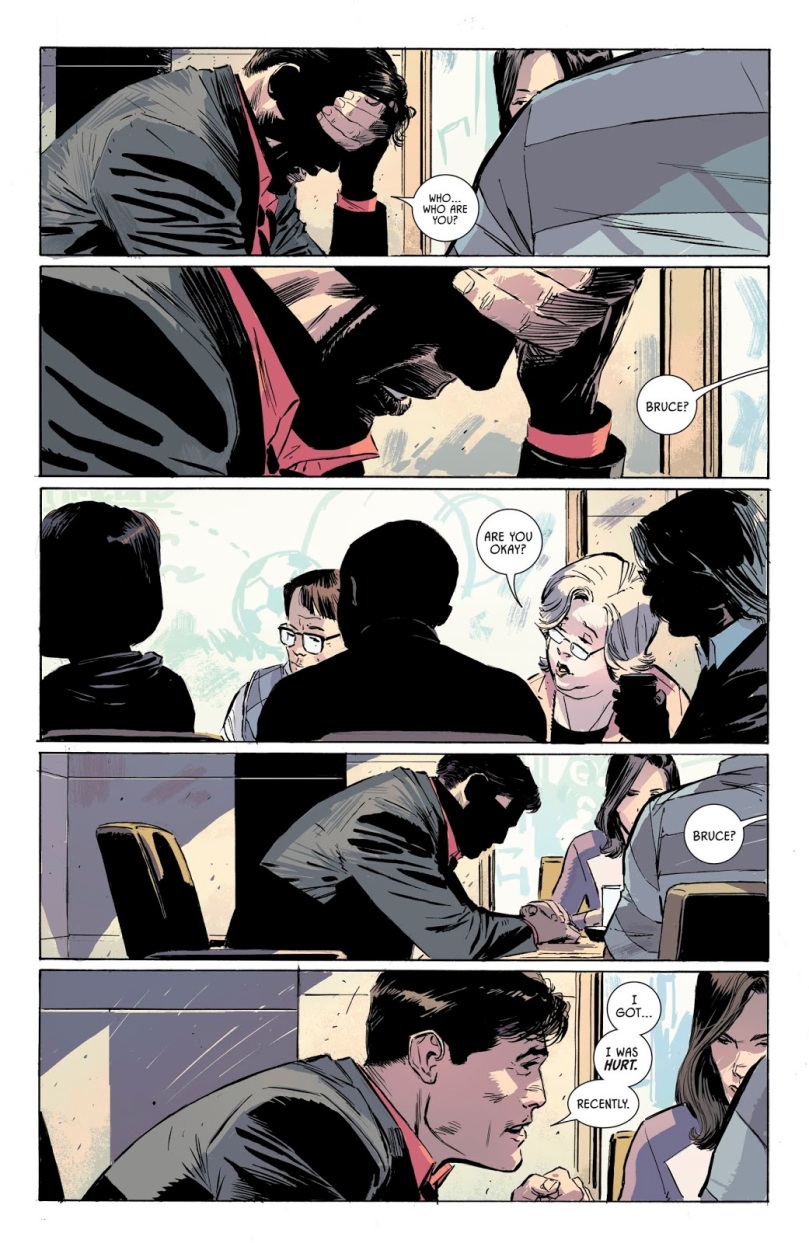

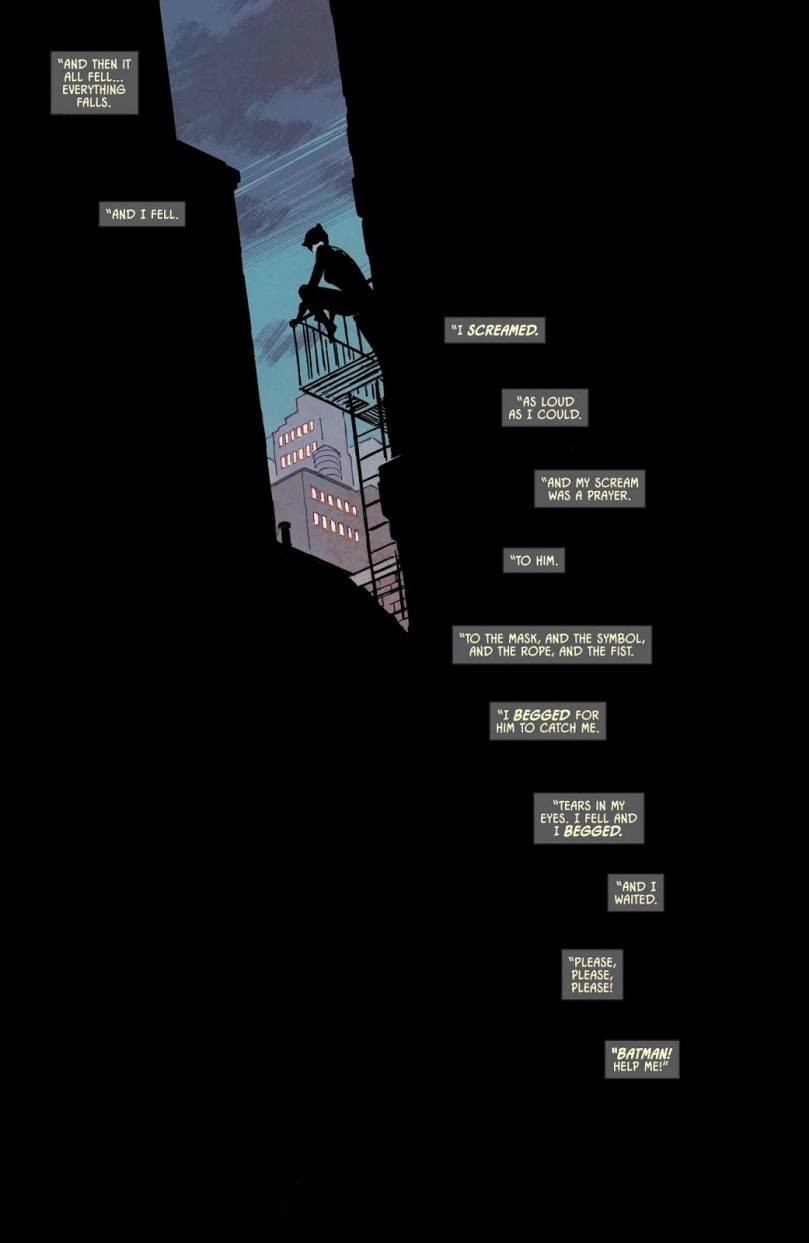
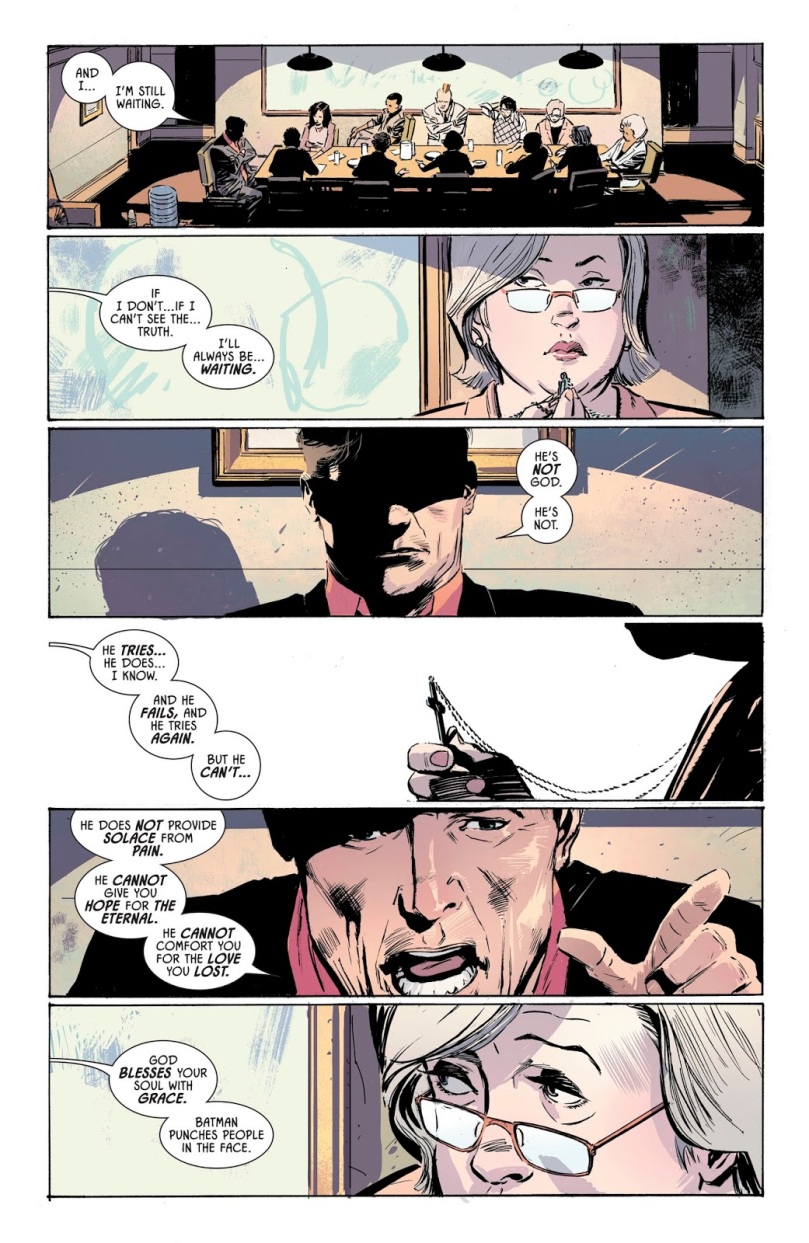
6. “A man shouldn’t…”, Redneck #16
Redneck‘s core concept is relatively simple: vampires in the South of America. Donny Cates milks this for all its worth, with engaging characters and interesting lore. But what makes Redneck great is the characters, and how Cates is able to imbue them with a real sense of life. After a long string of tragedies, Cates gives his characters a few issues to breathe, and the result is one of the best scenes of the 2010s that deftly defies expectations.
The central family of the Bowmans is given a chance to breathe after their home is destroyed, they are betrayed from within and their generosity almost gets them killed. One character who is given a bit of a spotlight is Greg, who we learn is gay and who has a cute fling with minor character Winny. They talk about it becoming more when the patriarch of the Bowmans, his father JV, walks in on the two. What follows Greg trying to calm his father down, who walks away in shock, and Greg assumes his dad isn’t okay with his sexuality and ends up verbalising it for the first time ever… and it turns out his dad was more shocked because, well, he just saw his son after said son had just fucked someone. The two bond for a bit and JV says Greg should do whatever makes him happy.
The scene is just a really heart-warming moment and well-done, in addition to playing with expectations. The southern dad having a problem with his son’s homosexuality is pretty played out, but this series has its roots in the south, from its characters to its dialogue, so it wouldn’t be out of place for that trope to be played straight — especially given that JV is very old. But Cates defies expectations — and rather than think that is what makes a good story, actually does something with it, delivering what one of my favourite gay scenes of the 2010s. Cates gets a lot of praise for his narratives, but I don’t think his dialogue and character work gets as much praise as it deserves.
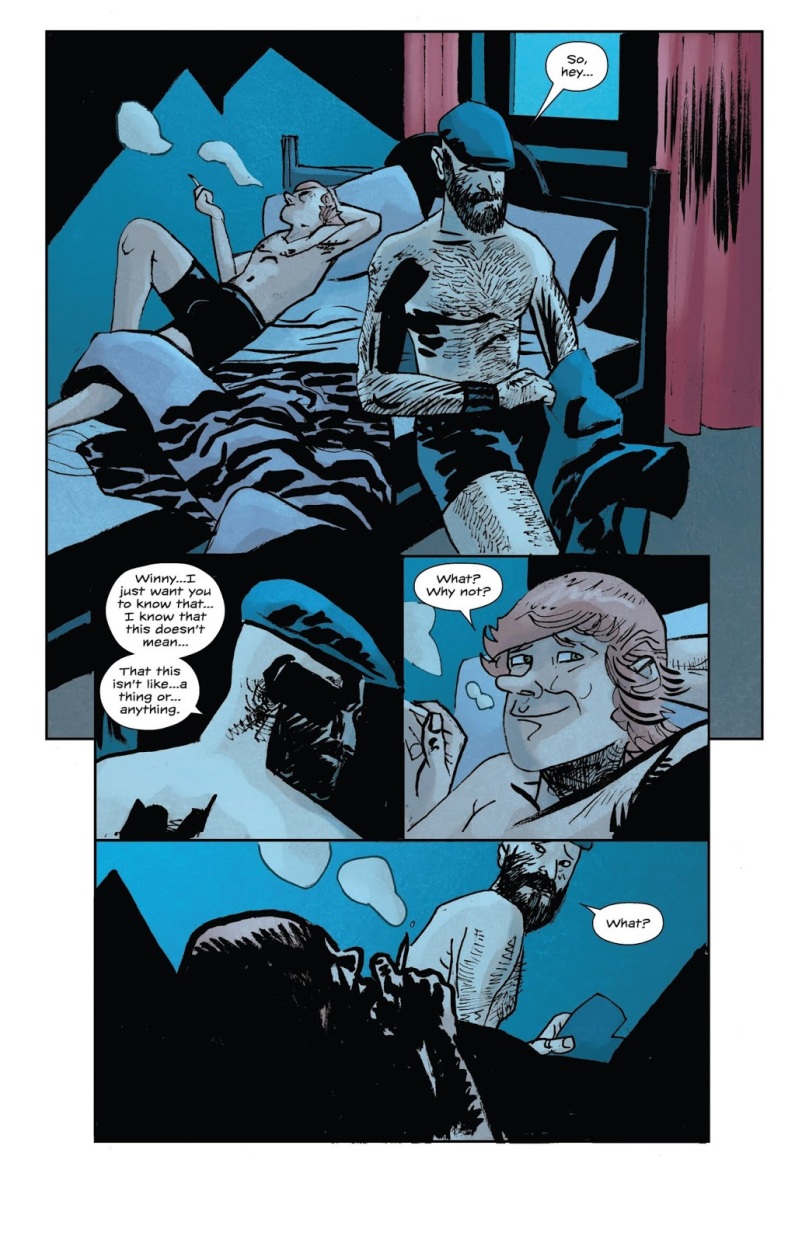
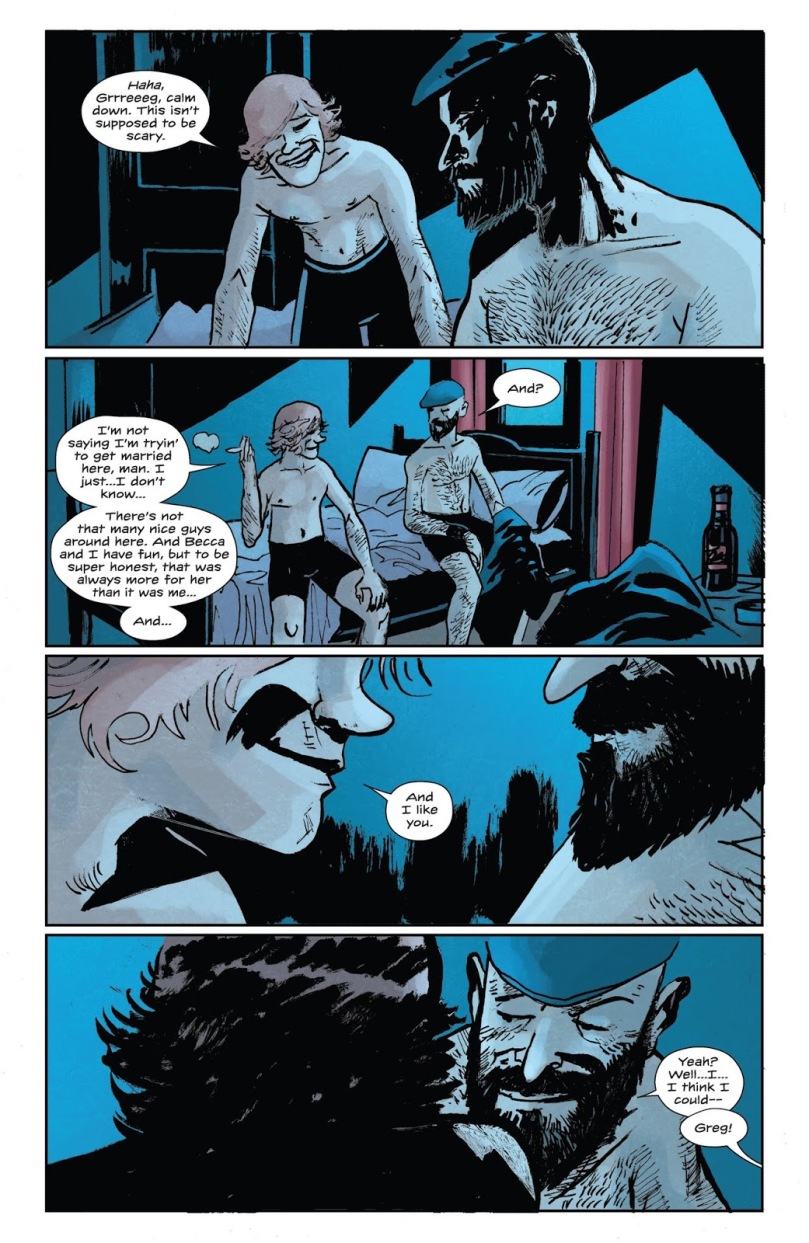
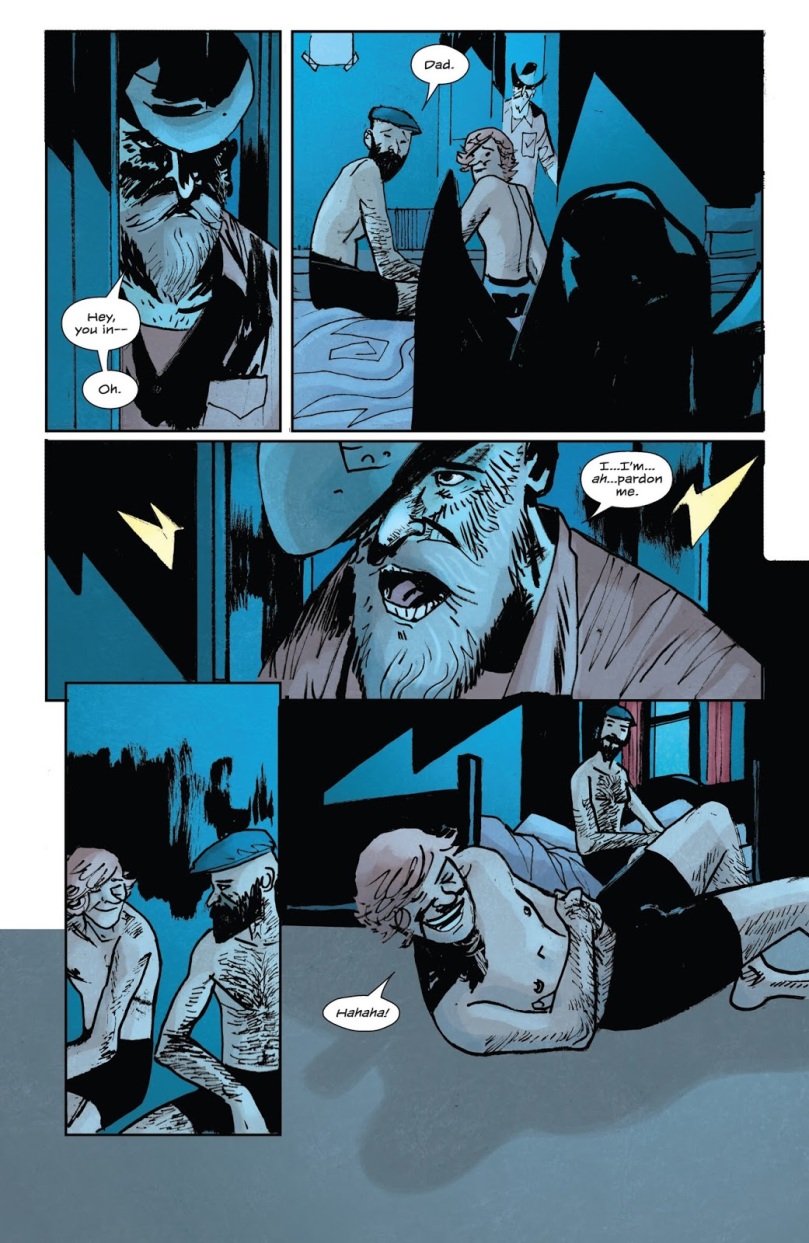

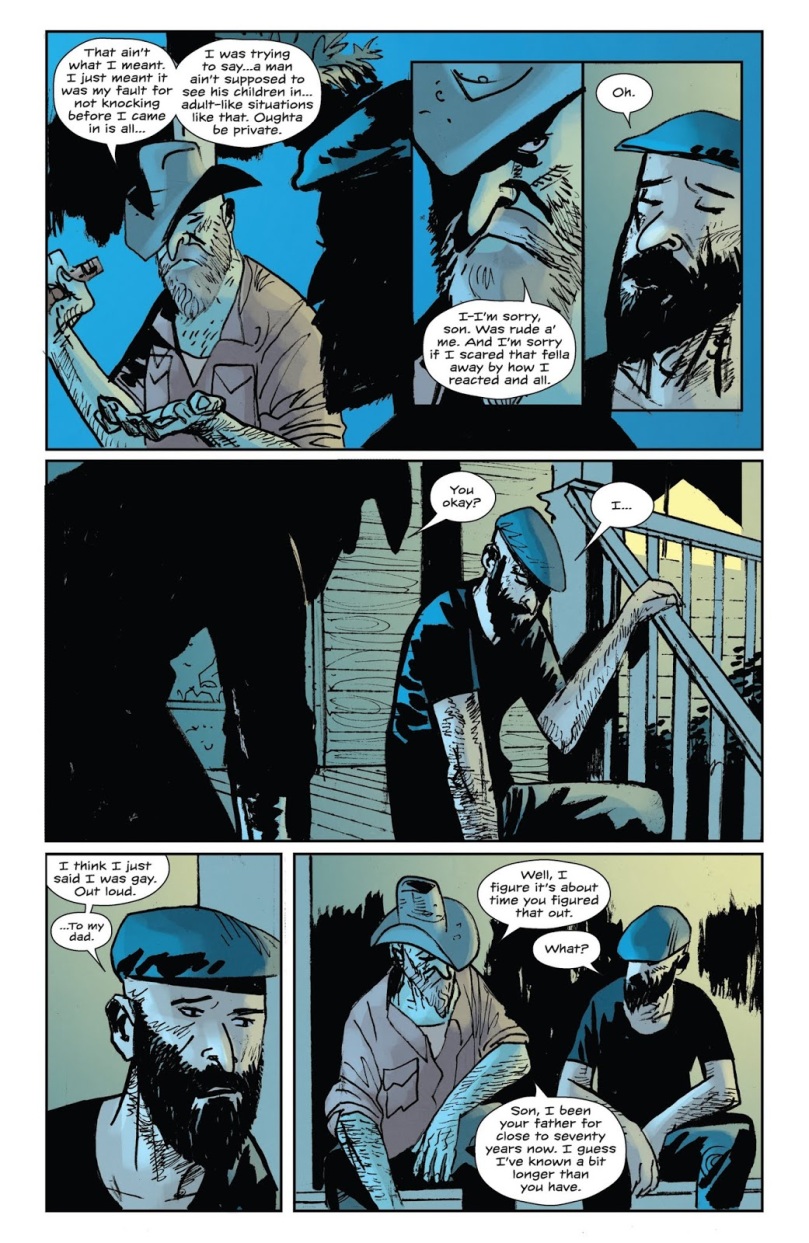
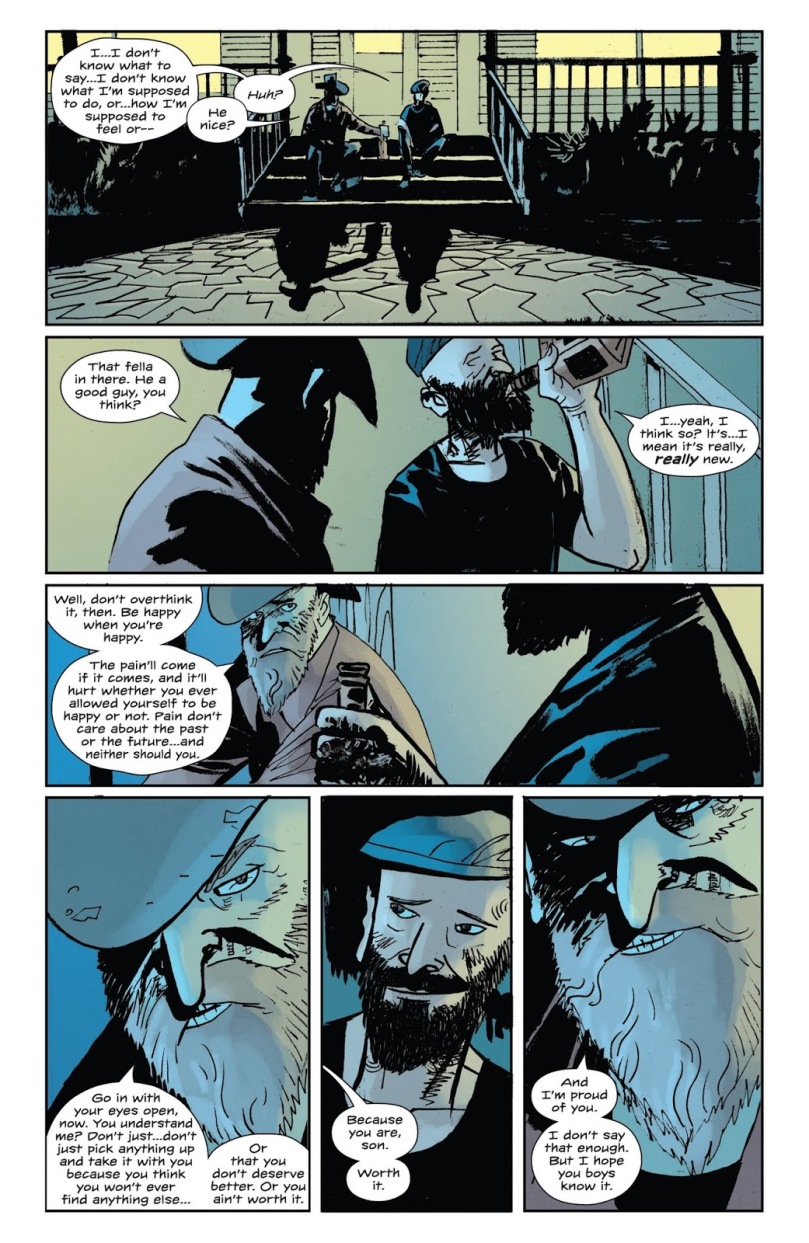
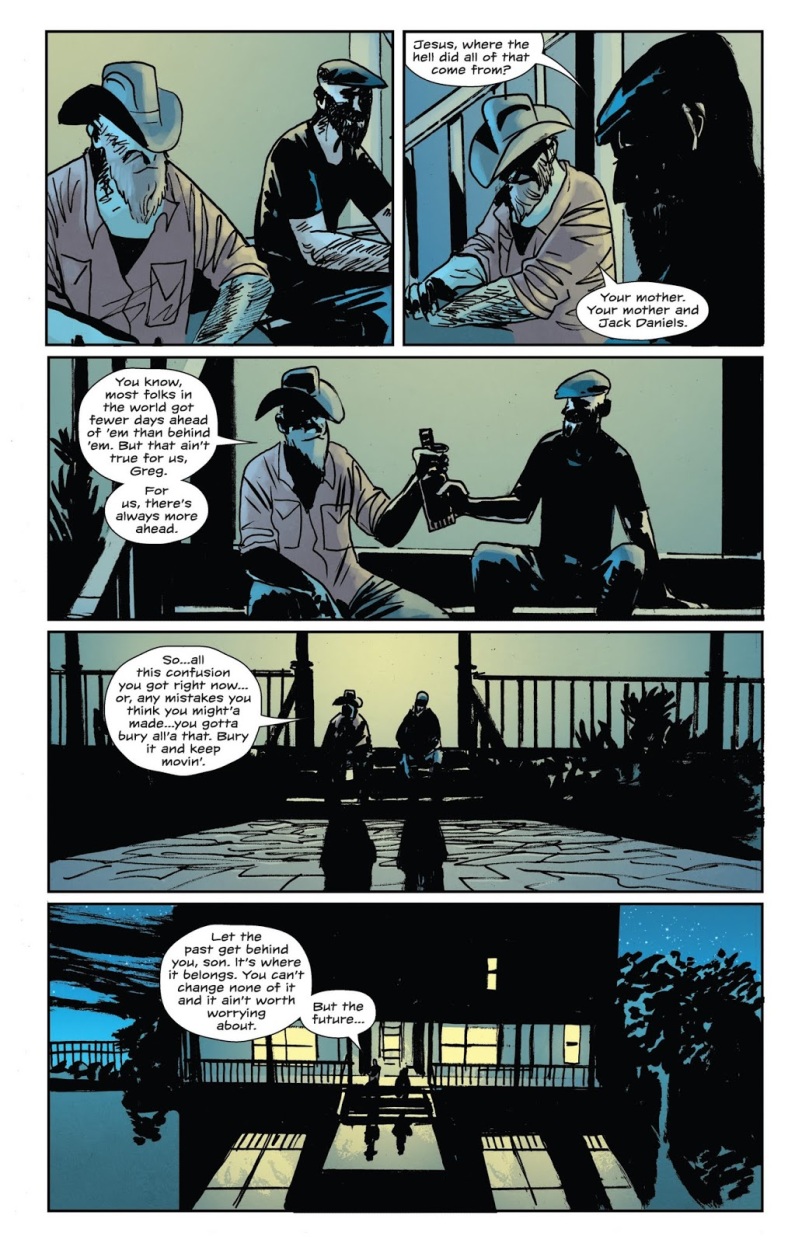
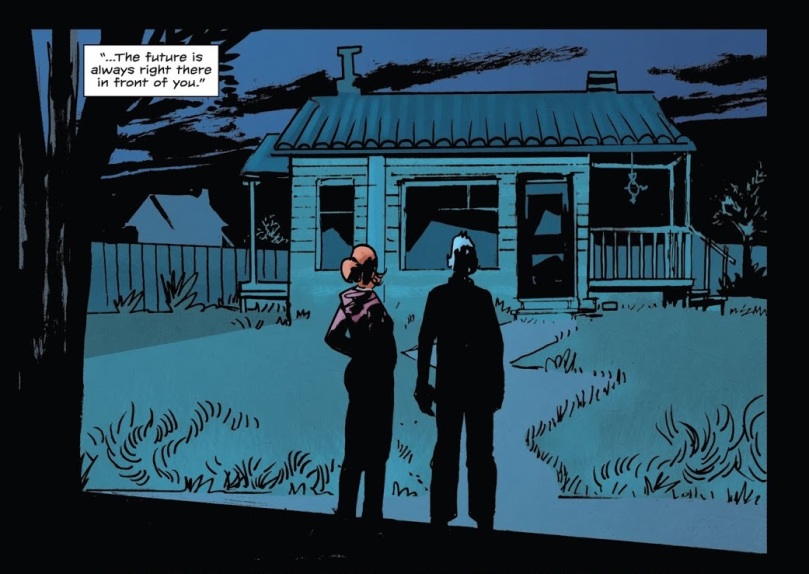
5. “Everything lives”, Secret Wars (2015) #9
Jonathan Hickman’s multi-series Marvel saga is a sight to behold. A grand story told across multiple series, spanning the entire Marvel Multiverse, the sheer scale of it is unprecedented and expertly executed. Secret Wars (2015) was the culmination of his Marvel work, but rather than a gigantic event that stood on its own, it — for better or worse — served as the grand finale to his saga and specifically an ending to his Fantastic Four run. Taken like that, it hits it out of the park.
Secret Wars (2015) follows the birth and destruction of Battleworld, a patchwork world created from the remnants of the multiverse by Doctor Doom. Doom saved what he could, but has taken to ruling over everything with an iron fist, and a surviving Reed Richards ends up fighting him for the right to fix the world — at great risk, possibly destroying what remains. The fight ends when Doom admits that Reed would have done a better job, and the Molecule Man ends the fight and gives Reed the power. There’s an epilogue where Valeria Richards explains what happened, but the last scene is of a smiling Victor von Doom, mask removed and face restored by his friend Reed.
This ending is a perfect ending to the themes of Hickman’s Fantastic Four run. The idea of believing in the future and not being fearful of saving what’s left, but instead building what comes next is the given a literalisation in the final battle between Reed and Victor. Reed and Franklin rebuild the multiverse together as one last act of father-son bonding, after the theme of fatherhood was so central to Hickman’s run. And, finally, Reed proves himself the better man, that his morality is what makes him who he is, as he gives Victor one last gift and a new lease on life, setting up stories for the future. This ending is so emblematic of all things good about Hickman that it was the perfect note for him to leave the universe on… but then he came back and reinvigorated the X-Men, and that’s also a great thing.
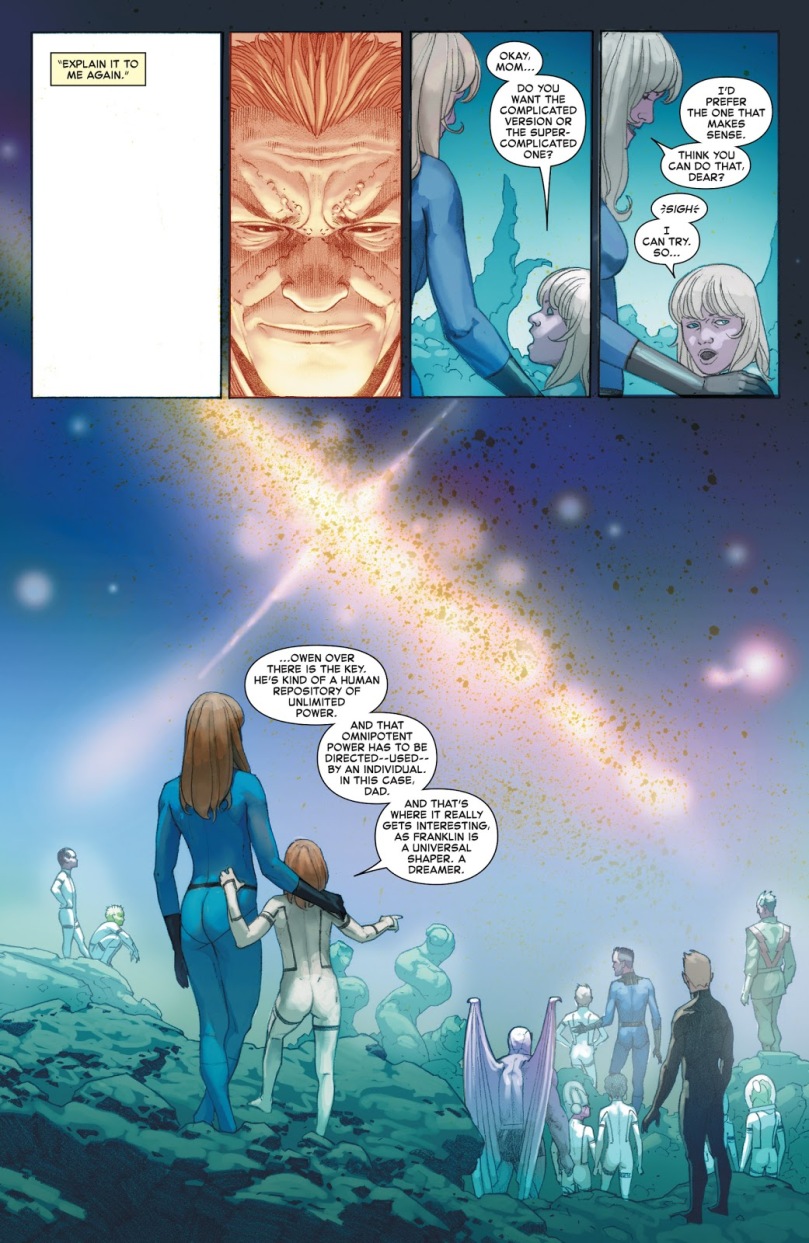
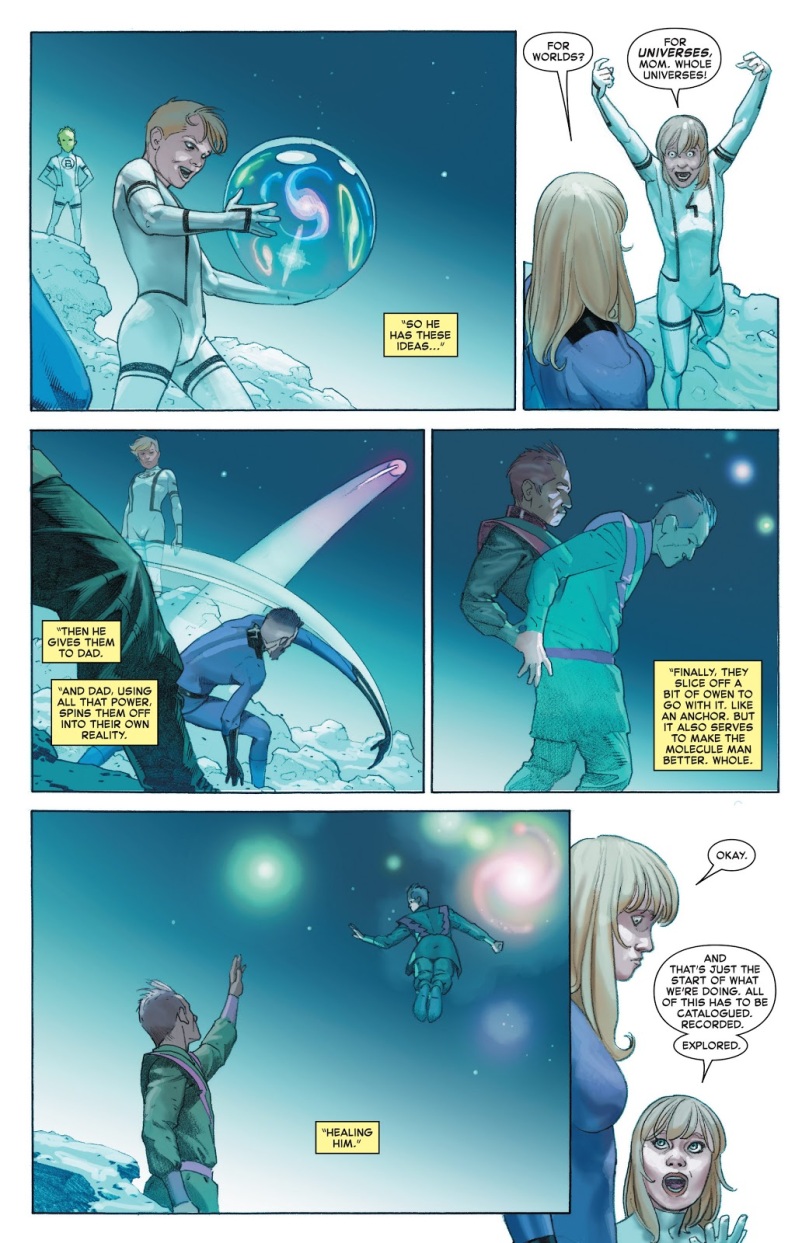
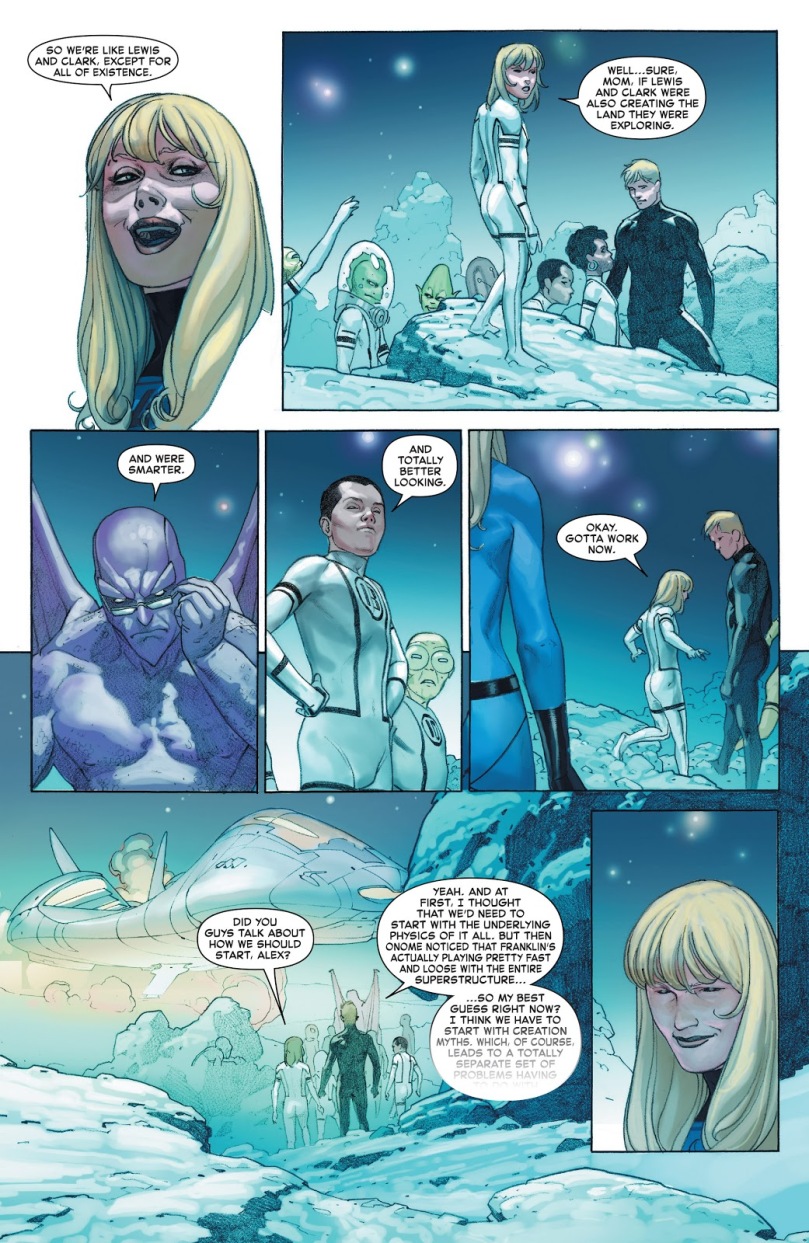
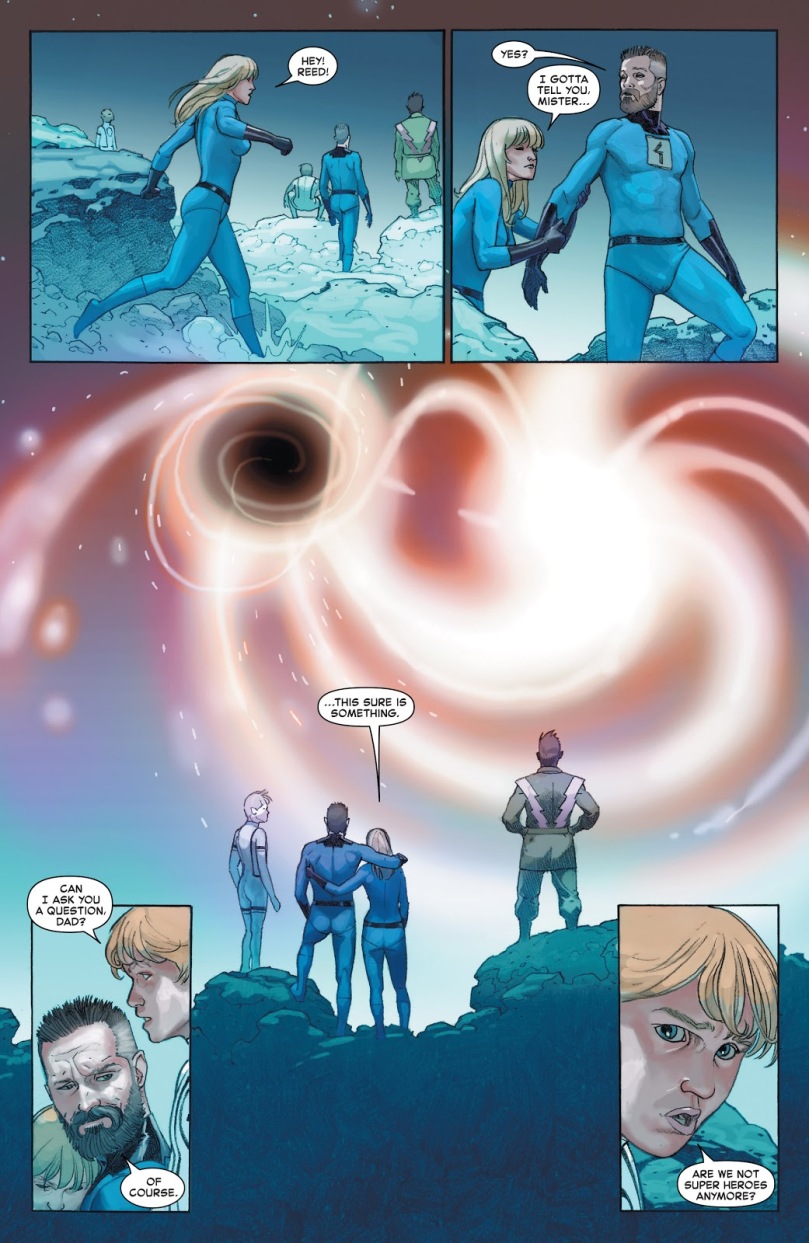
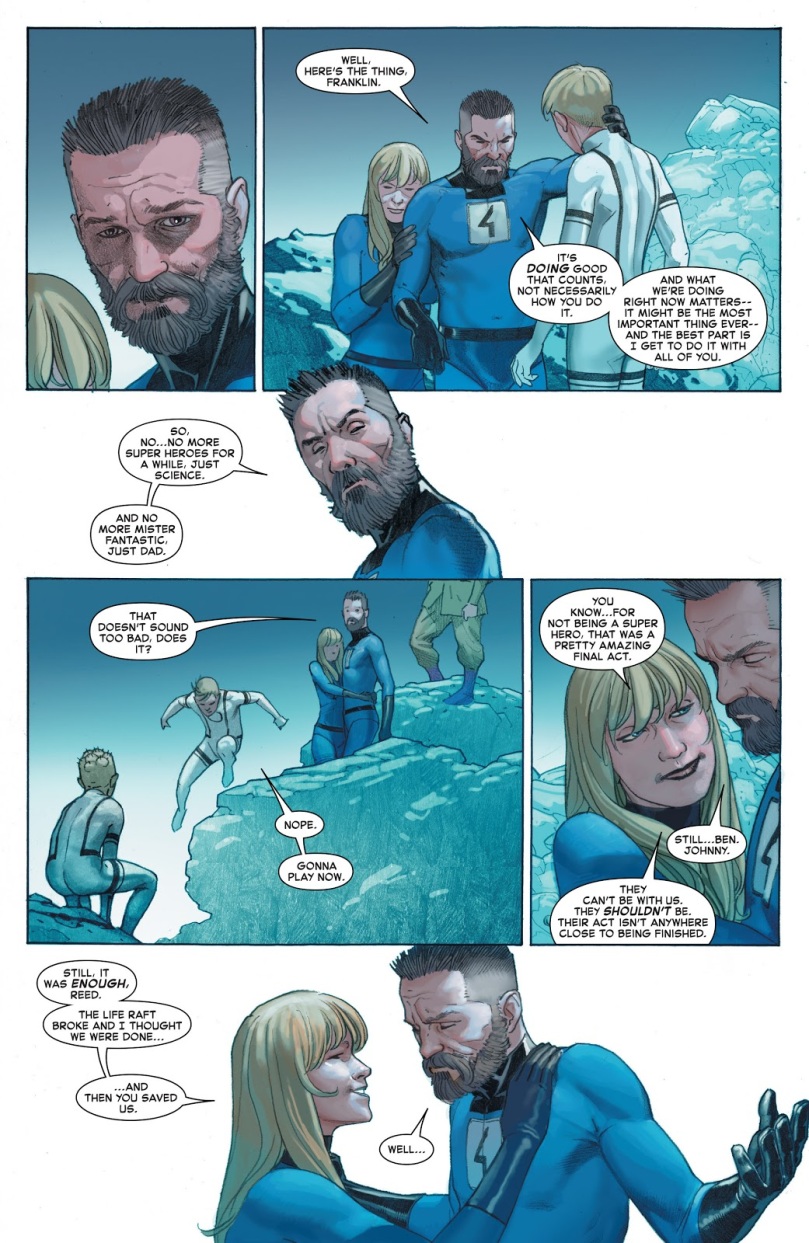
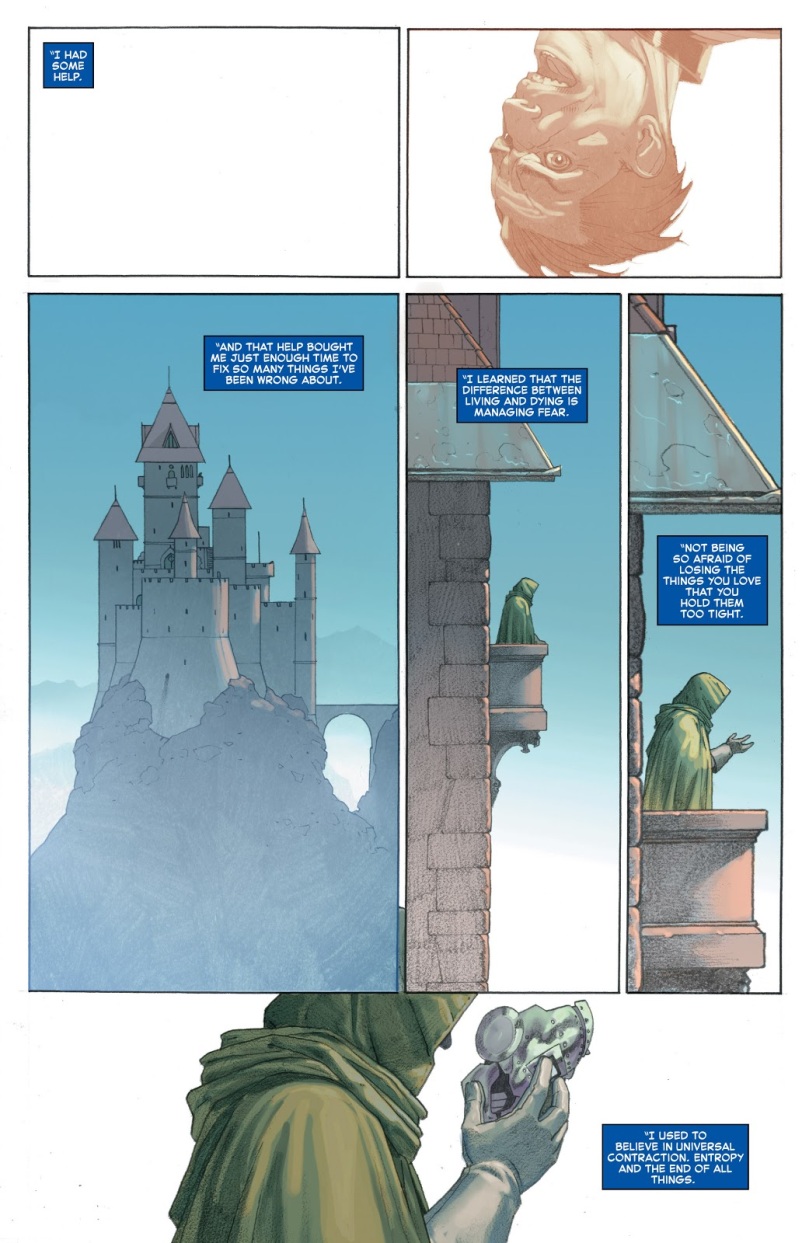
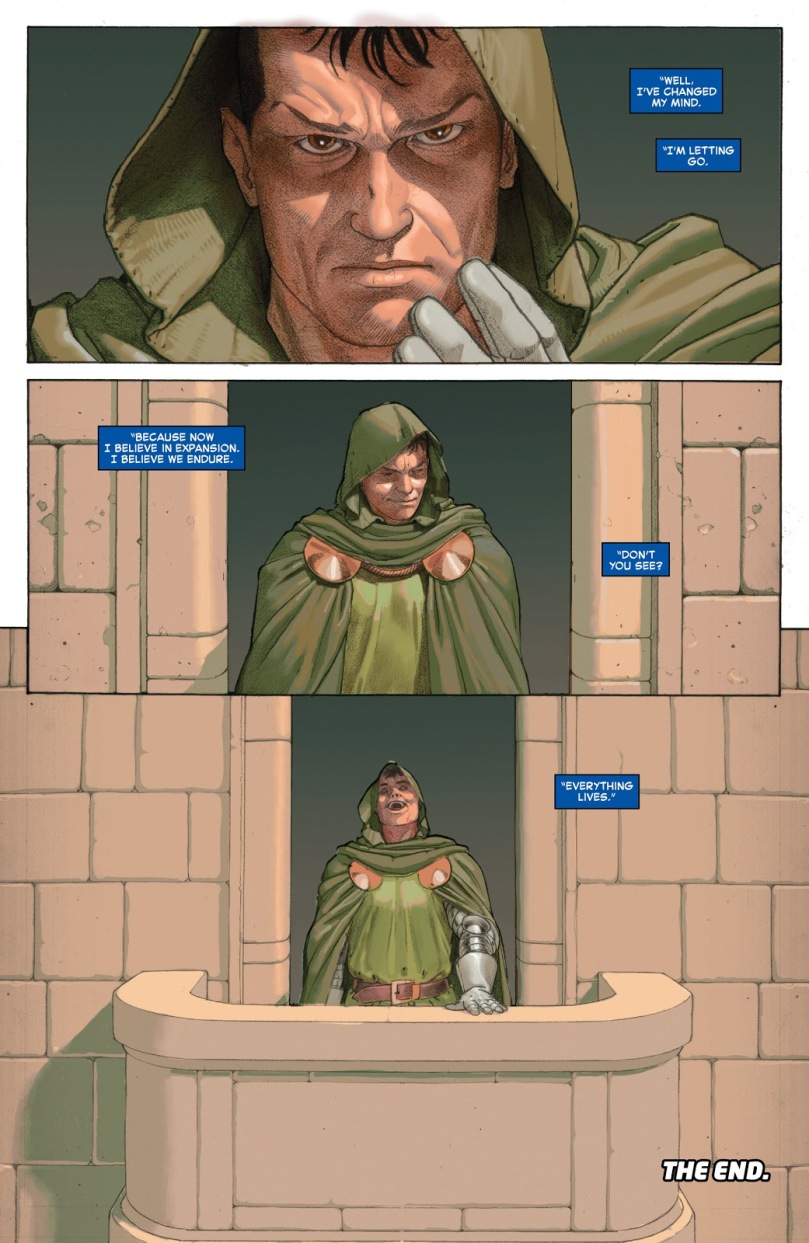
4. “How could I ever forget you?”, DC Universe: Rebirth #1
It wasn’t too long ago that DC Universe: Rebirth #1 released and heralded the return of much of what made the pre-Flashpoint DCU so great. A return of love, legacy and optimism, Rebirth truly revitalised DC’s comics and moved things forward, while not neglecting the past. And it all took the form of the Flash fan from Blue Valley, Nebraska coming home.
After years of questionable output from DC, Rebirth was the much-promoted revitalisation of the line. It was leaked that Wally would be returning, but given that it’s literally the premise of the issue, it doesn’t really affect the comic — in fact, it probably got more people excited for the relaunch than anything (especially since they teased his return beforehand but excluded him from the Rebirth panel). And when Wally finally returned, it was glorious. Wally traverses the New 52 and laments the loss of what fans loved, while simultaneously embracing the new. And after Linda fails to remember him in this issue, Wally goes to say goodbye to Barry in a heartfelt monologue, and it’s possible this really was going to be the end for Wally, but then he’s saved from the Speed Force.
Wally is the perfect character to usher in the Rebirth era. He is a character defined by his connection to the Flash legacy, whose love for his wife Linda has saved him on countless occasions and he’s a character who has never been defined by the tragedy in his life. Wally is the character that was all about moving forward, embracing the new — he represents what was so great about the DCU. As a long-time Flash and DC fan, this was everything I wanted — essentially an apology for how these two things were treated for most of the 2010s. Johns’ dialogue is sentimental and earnest, and it really resonates as a result. There are a lot of meta moments like this in the 2010s, but this one landed with me the most.
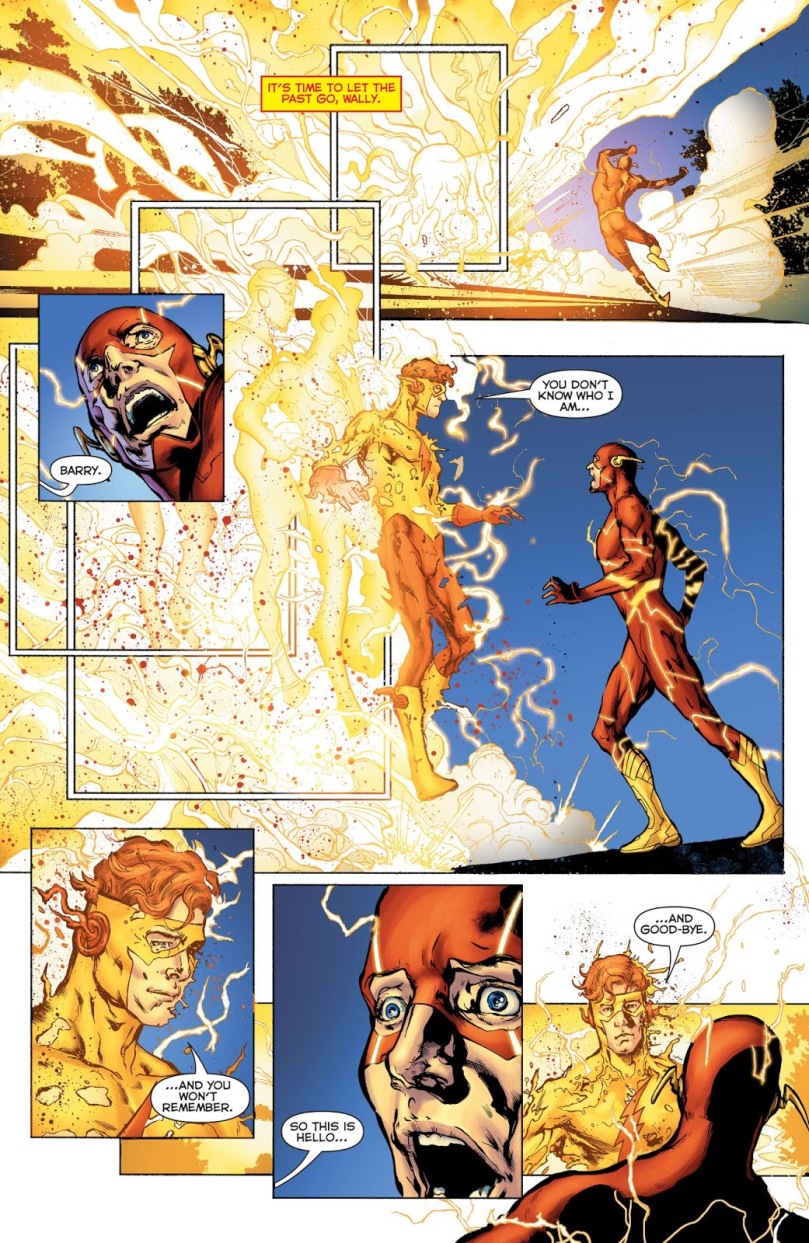
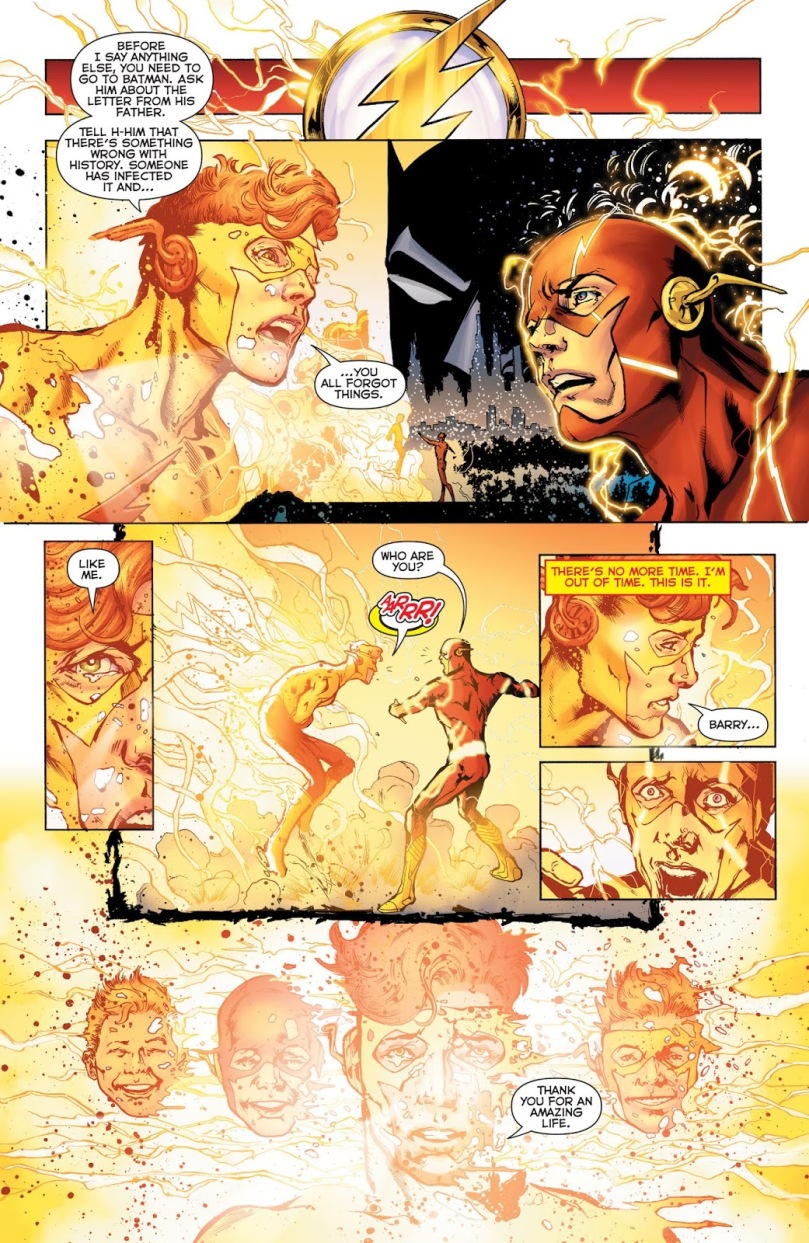

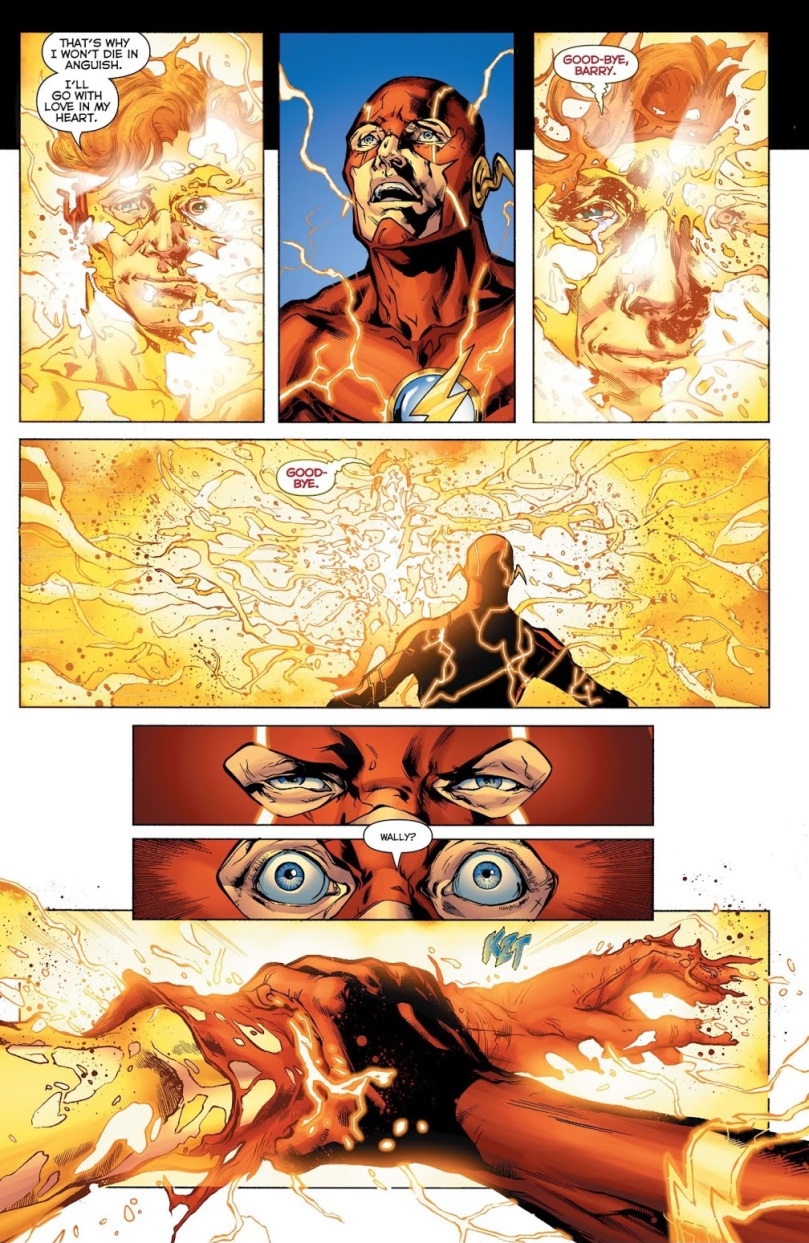
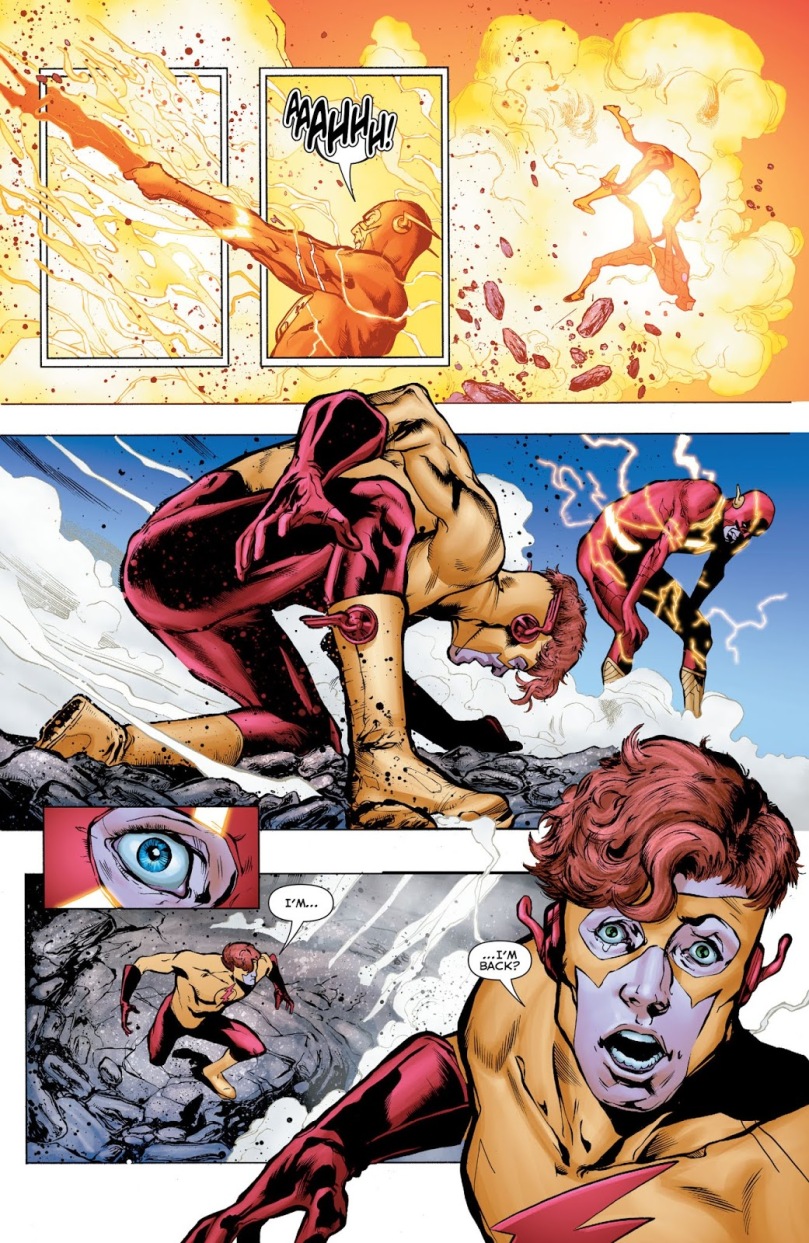
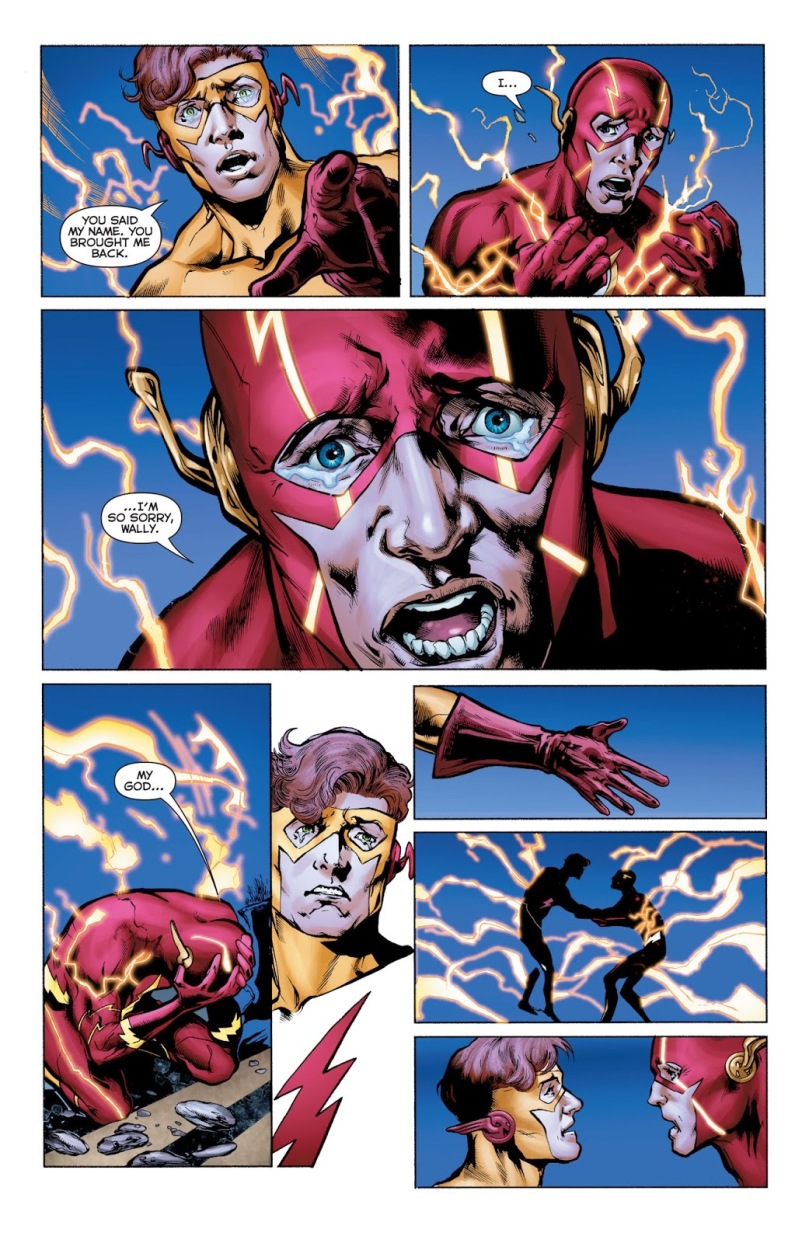

3. “Did we do a good job, son?”, FF (2011) #23
While Jonathan Hickman is known for his epic scope, I think what doesn’t get enough attention is his keen eye for human emotion. His aforementioned Fantastic Four run spans the multiverse, but at its core is about family. The larger than life scale of his run lends a grandeur to the sentiment, but in the end, the stories are about family — and it all ends with Reed and Sue talking to their son in his bedroom, before he’s gone forever.
There’s comic book science involved, obviously, but an adult Franklin Richards spends the day with his younger self before telling his past parents that he needs to return to his own time. What follows is a heartfelt, earnest scene that anyone who even has a passing interest in parenthood can relate to — Reed and Sue tell Franklin about their worries, their concerns if they did things right, and ask Franklin if they were good parents, and Franklin tells them yes.
Hickman’s Fantastic Four run was about the family, but a running element was Reed and Franklin’s relationship, and how they just aren’t similar. Sue expresses the concerns that a mother would express, but Reed getting to the root of it is a beautiful way for Hickman’s run to end. After he neglected Franklin and they’ve bonded, after he gained a broader view of his children, he’s finally able to reconcile his parenting with every other part of him.

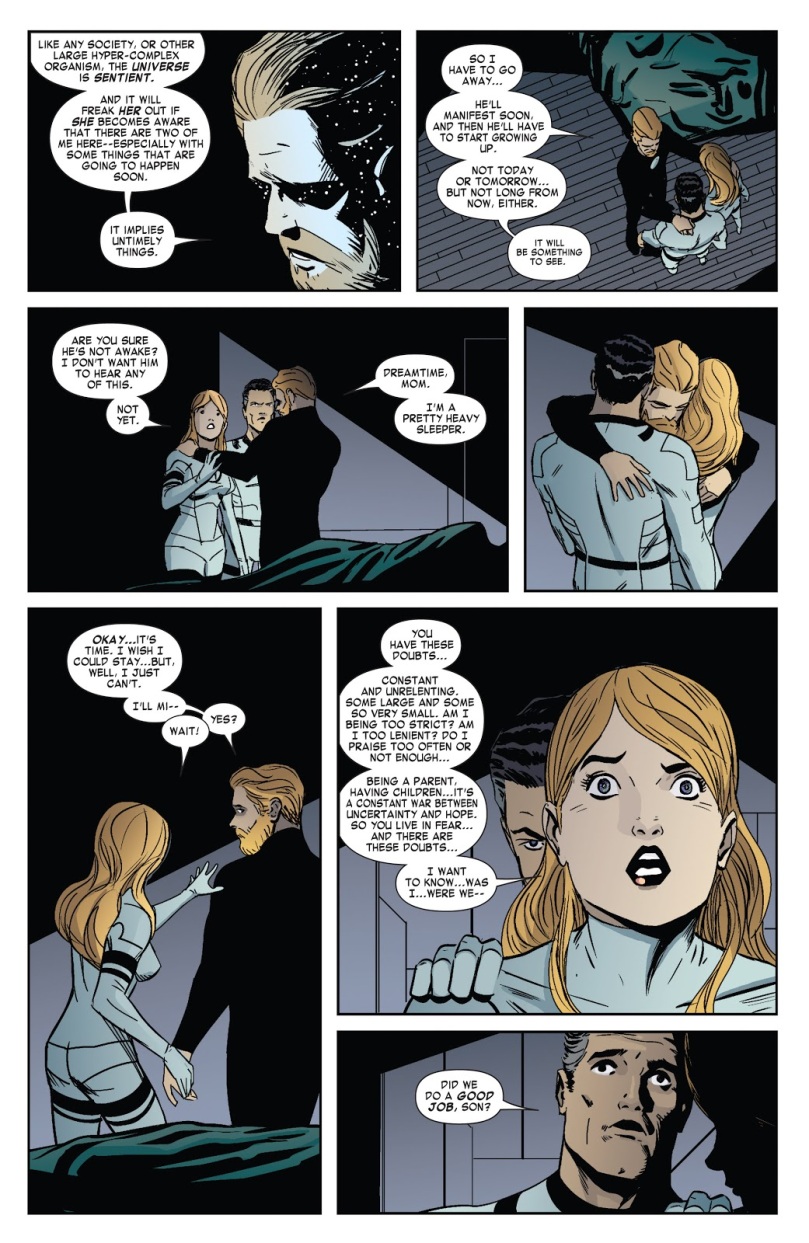
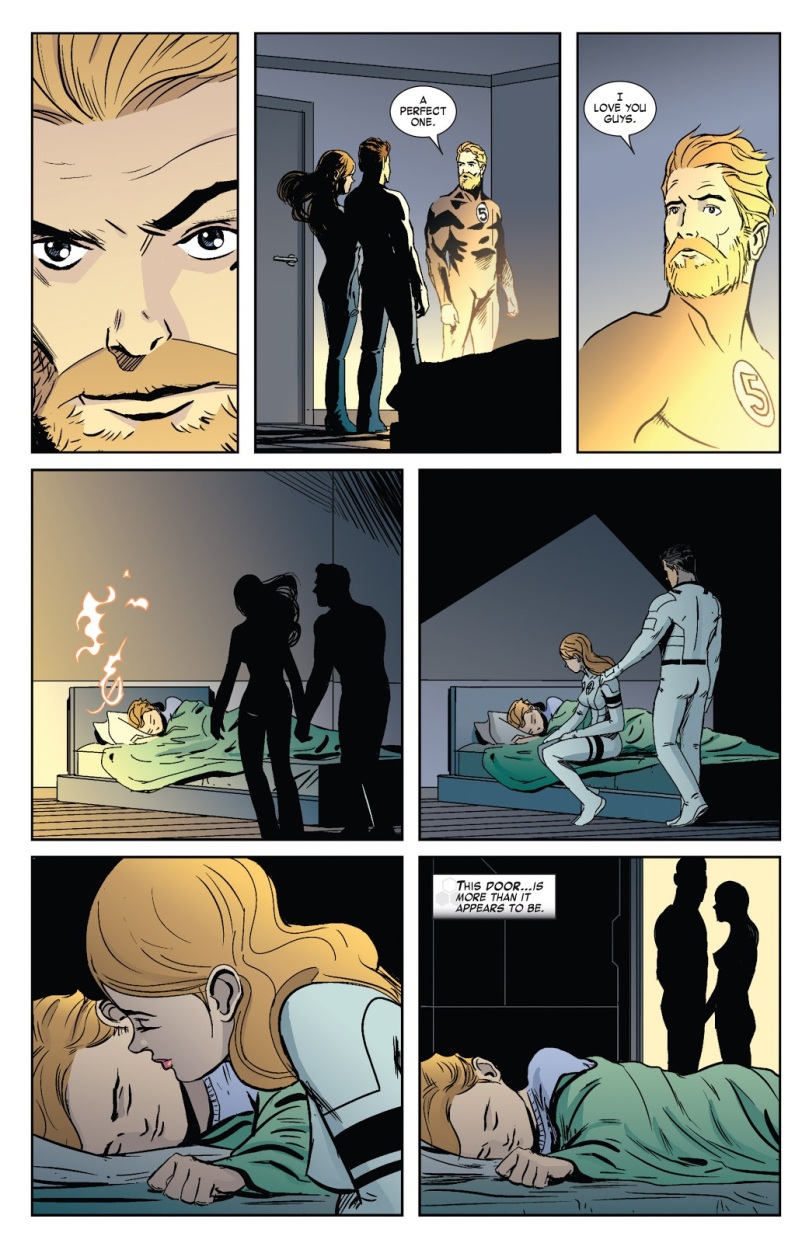
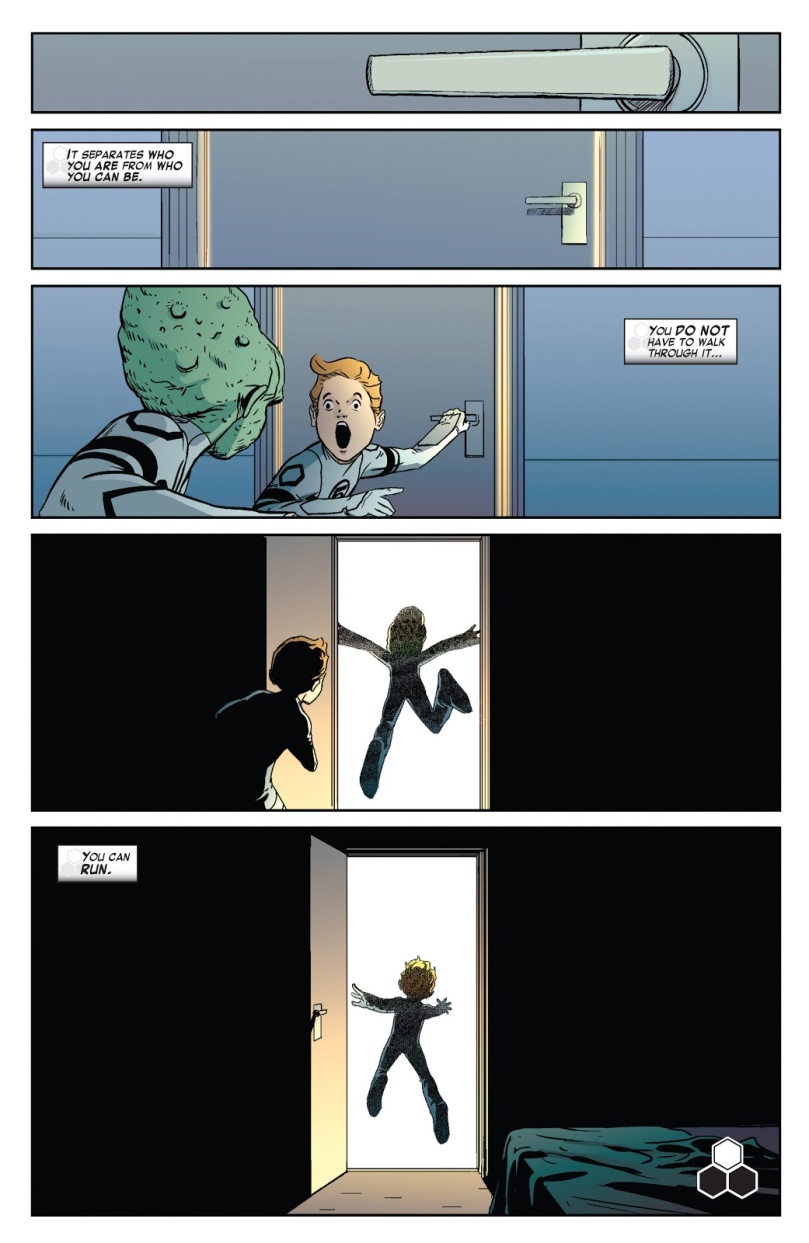
2. “You’re the fastest man alive!”, The Flash (2016) #50
Yes, another Wally West moment. After Wally returned in DC Universe: Rebirth #1, it was assumed by many that he would be given a greater role in the DC Universe. Instead, he appeared in a mediocre-to-bad Titans series where nobody seemed to know what to do with him. After several badly received stories, Wally was returned to the Flash book, where he was given a lot of prominence and importance, and Joshua Williamson showed a strong love and affinity for the character. Then came “Flash War”, a story that I dreaded for its tagline of “there can only be one fastest man alive”, and anyone familiar with DC’s heavily contrasting treatments of Wally West and Barry Allen can tell you why.
However… “Flash War” was great. It mined Flash lore for interesting ideas, tackled the plot point of Wally’s forgotten children when it seemed like writers forgot about them, and delivered a triumphant moment of Wally. As Barry and Wally start losing sight of a Speed Force-empowered Hunter Zolomon, Barry speaks the words that we all knew to be true — that Wally is the fastest man alive. Wally catches up to Hunter and, in a way that gets to the core of the character and what the Flash legacy means to him and to readers, defeats Hunter.
The epilogue issue that followed was also great, with some great meta-commentary, but I’m keeping it to one issue per series. So, make it an honourable mention. And sure, what followed “Flash War” for Wally was terrible and speaks of how badly creators can screw up characters, but for a brief time, Wally West was where he belonged — with his family, as the fastest man alive. Instead of Titans encouraging him to let go of his memories, The Flash has him embrace them and his past, because that’s what makes him who he is.
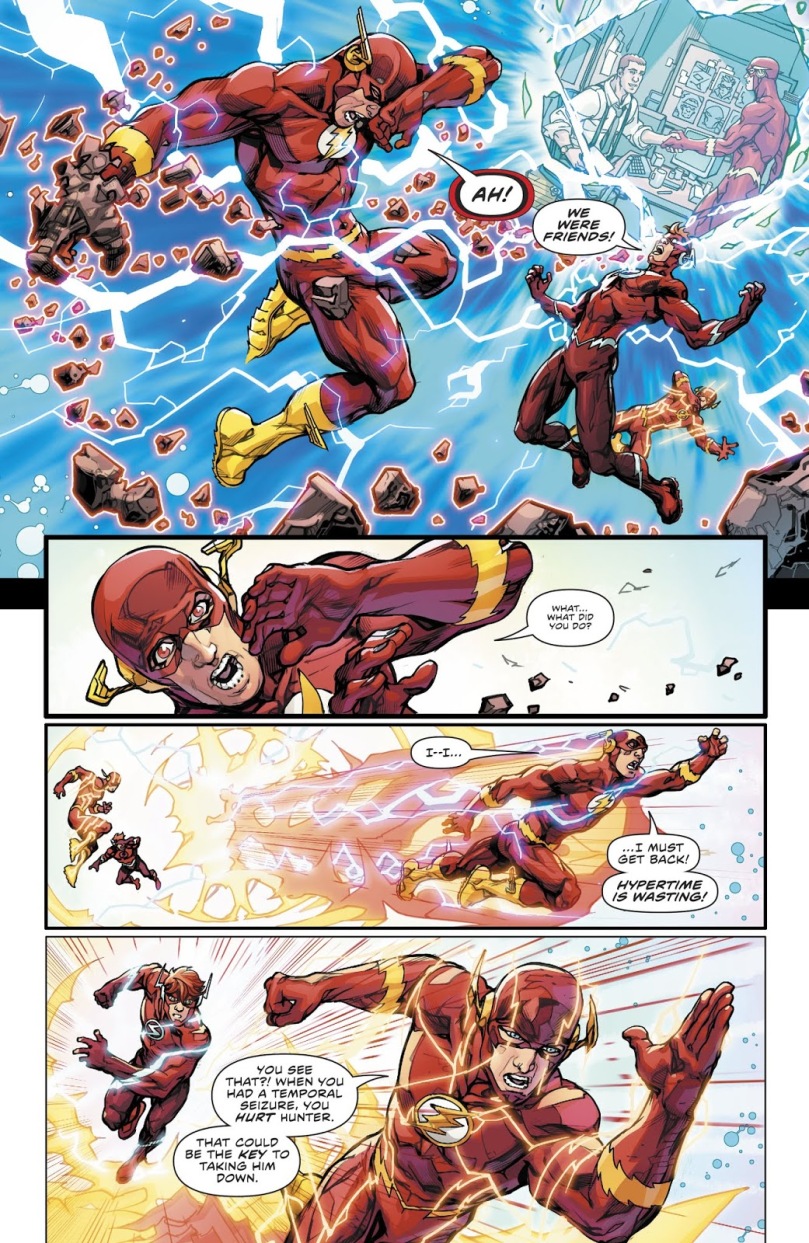
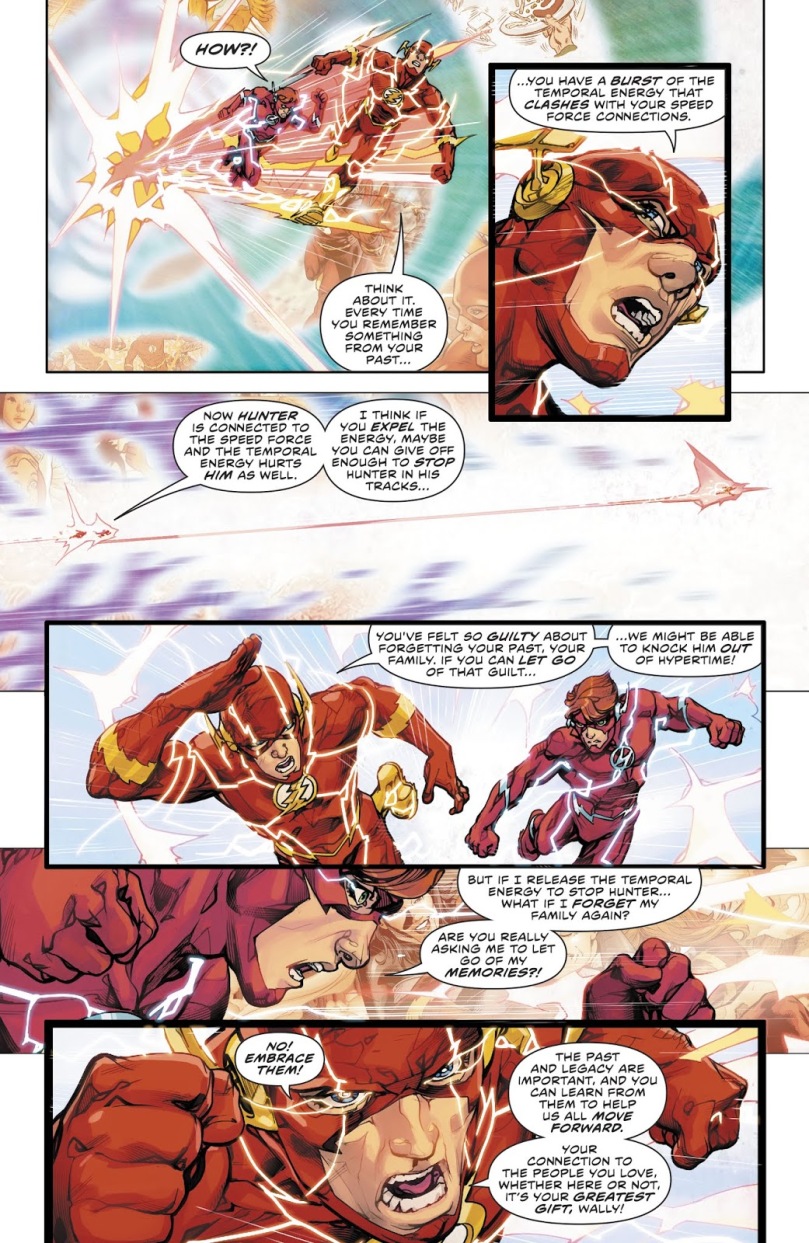
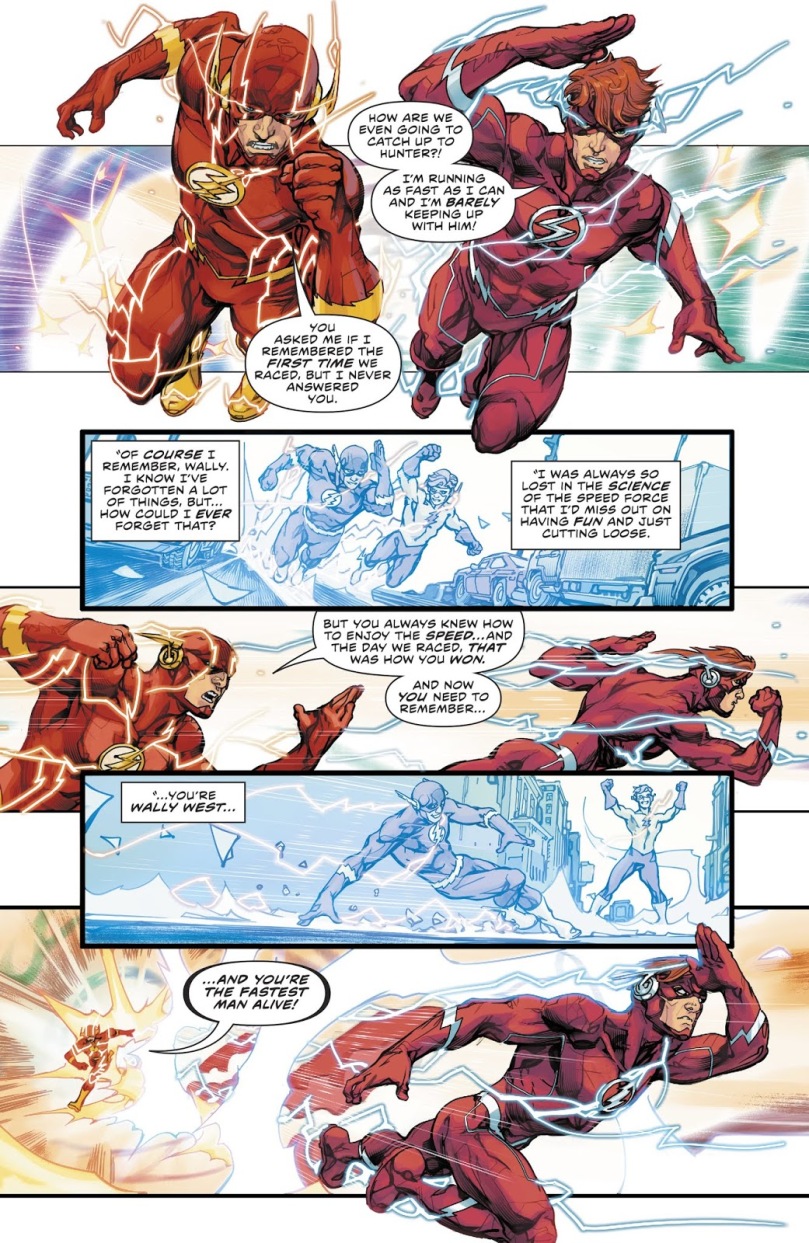

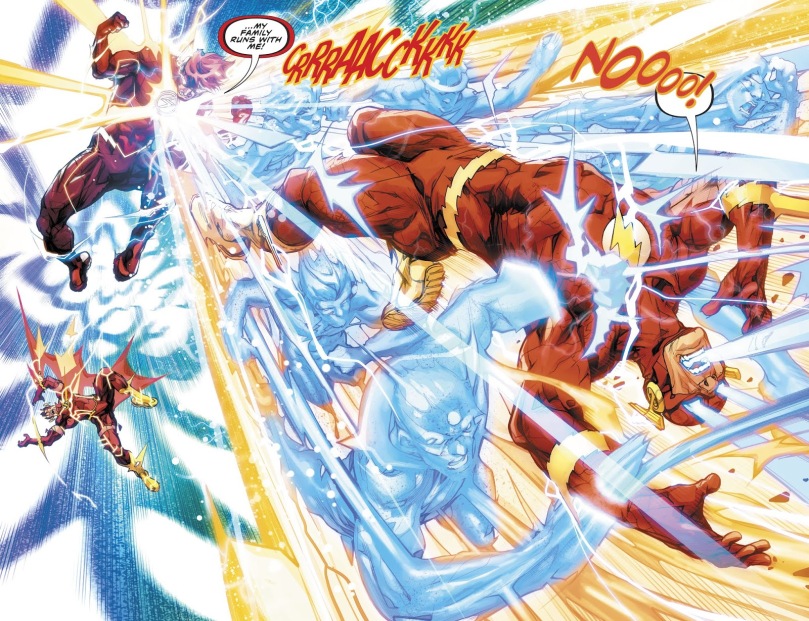
1. “Dawn”, Silver Surfer (2016) #14
Dan Slott’s Silver Surfer run is a joyful ride through the strangeness of space and is a soaring tribute to the Silver Age. However, at its core, Silver Surfer is about the relationship between Norrin Radd, the Sentinel of the Spaceways, and Dawn Greenwood, an average girl from Earth. This moment typifies that in the best way possible.
After Norrin and Dawn travel to before the Big Bang, they are stranded and decide to live their lives there. They get married and Dawn eventually passes away from old age, and Norrin doesn’t. As the old universe dies, Norrin travels through the event and ends up in the current universe once again, throwing Dawn’s essence into the Big Bang, creating the signature red and black dots of the power cosmic from her ladybug motif. Later, we see that every species has the same word for the sun rising: “Dawn”.
This moment is a perfect ending to a perfect run. It is goofy and weird, but also epic and heart-warming, paying tribute to Jack Kirby’s art and honing in on what made this run so great. If Dan Slott’s Silver Surfer was a tribute to the Silver Age, this moment is a testament that, for all the high concepts and strangeness, the Silver Age was about joy and wonderment.
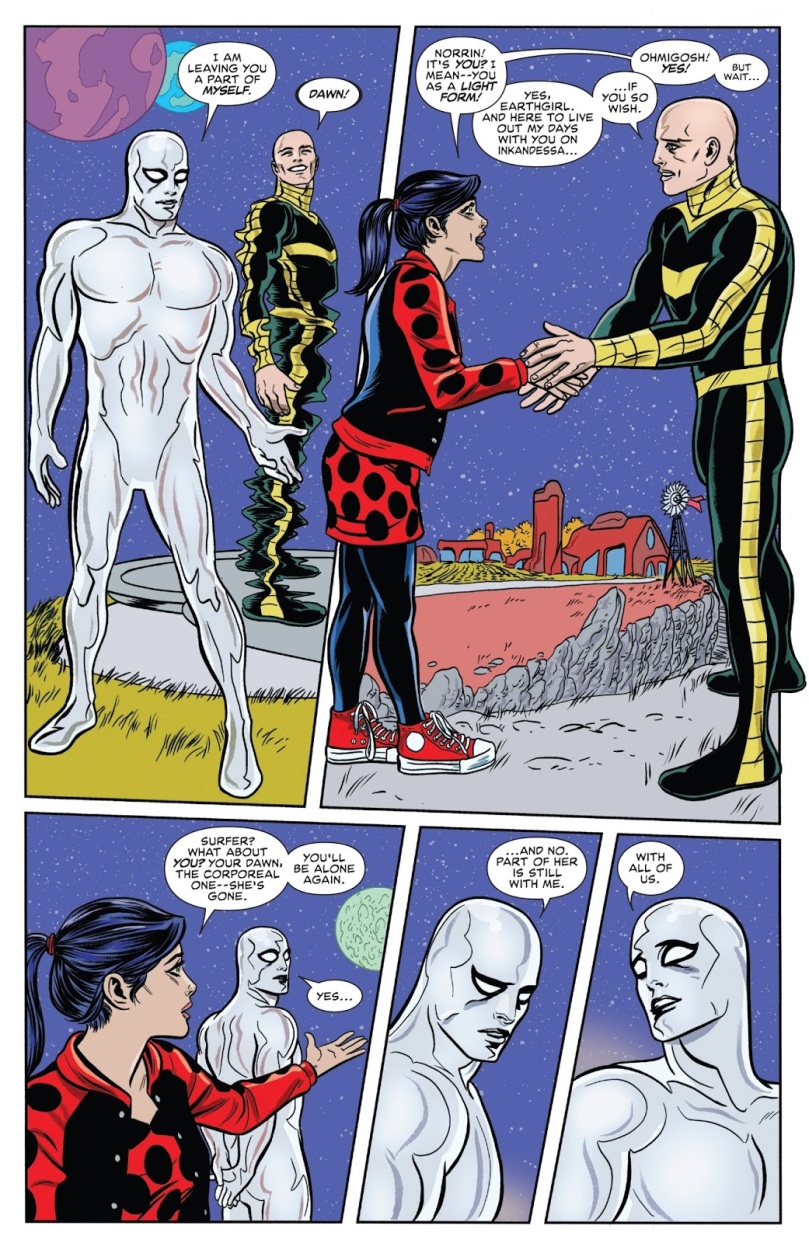

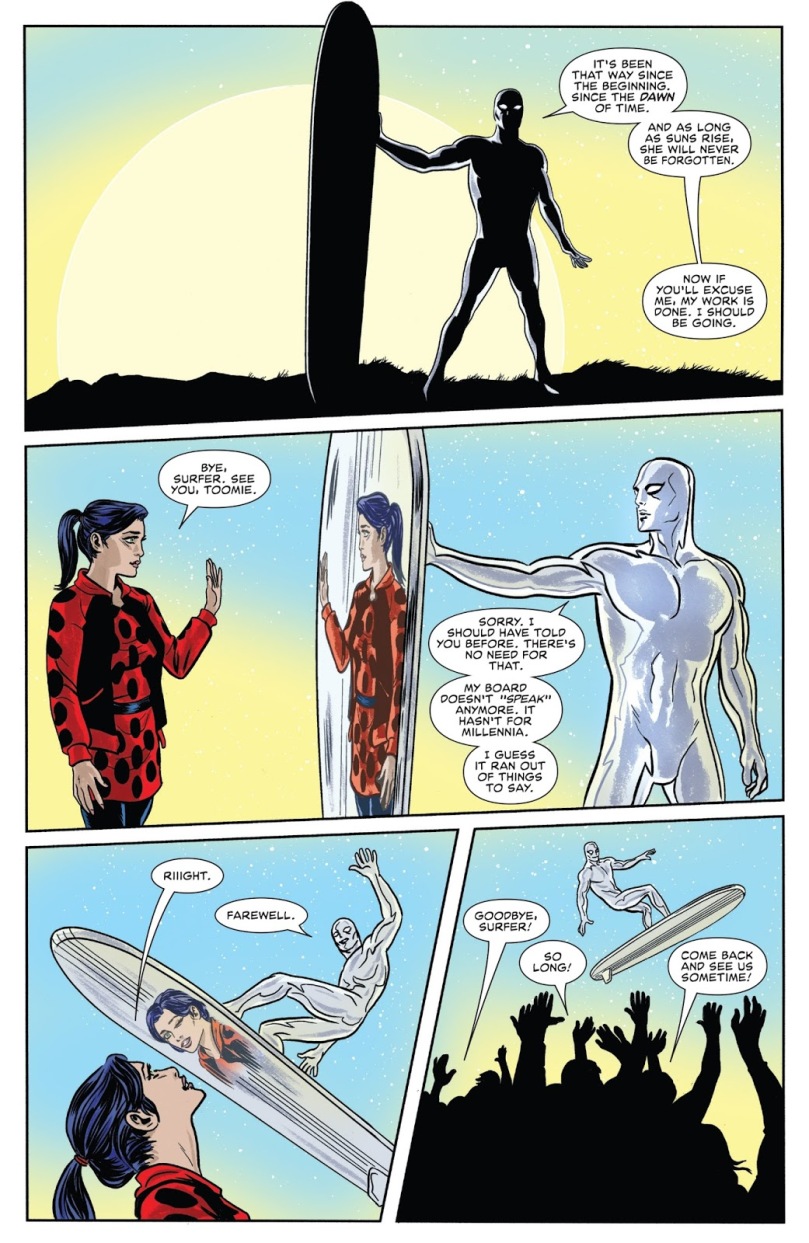
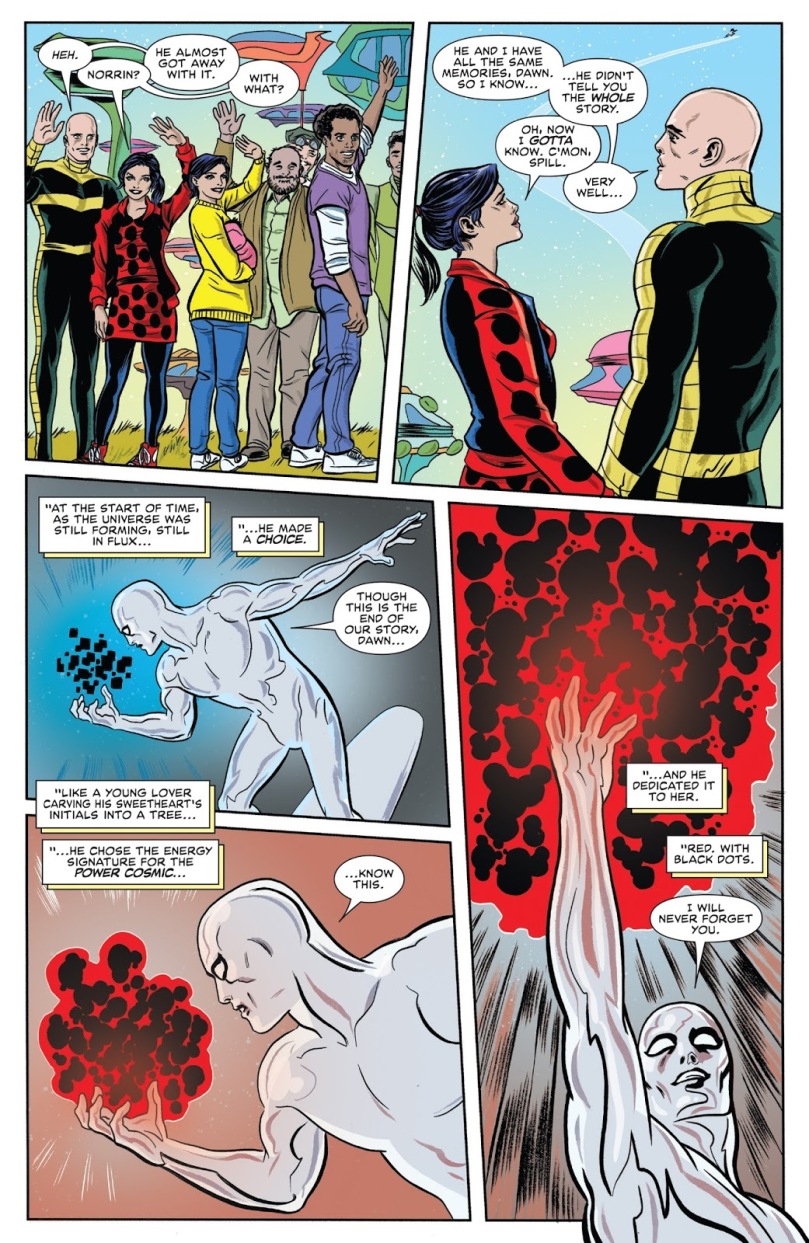
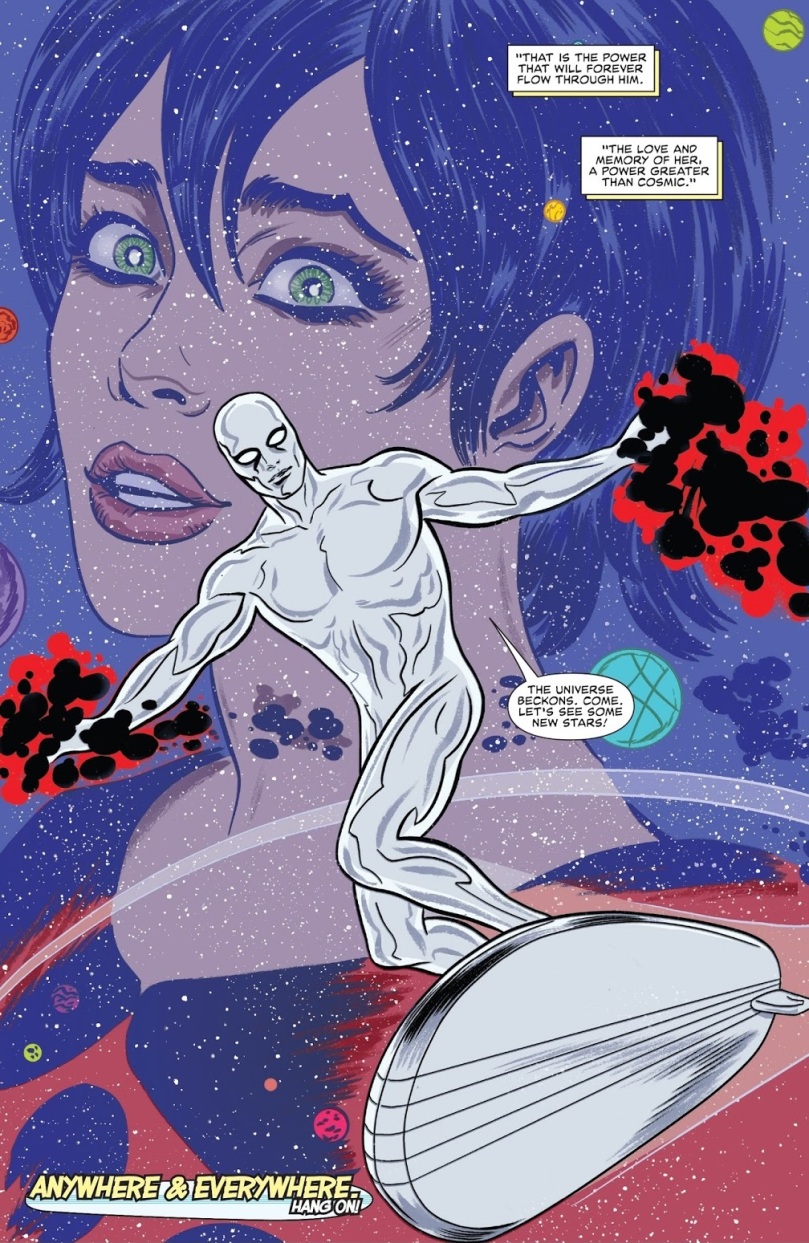
There you have it, my personal best comic book moments of the 2010s. Probably nobody is going to agree with me on these, but these are the ones I liked the most. There were others, but I had to be a bit strict, so this is what is left. Hopefully the 2020s will have just as many good moments, and of just as high a quality. But I don’t know, I don’t have 2020 vision.
(Sorry).


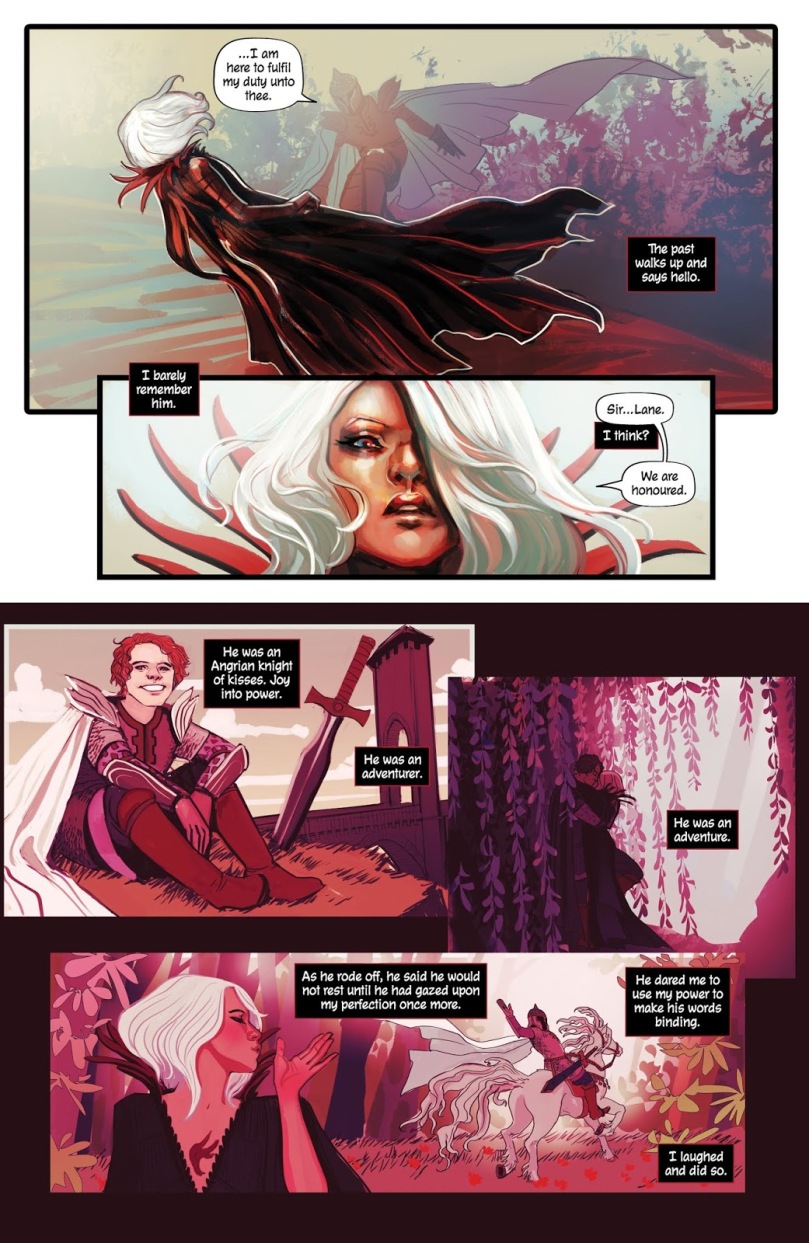
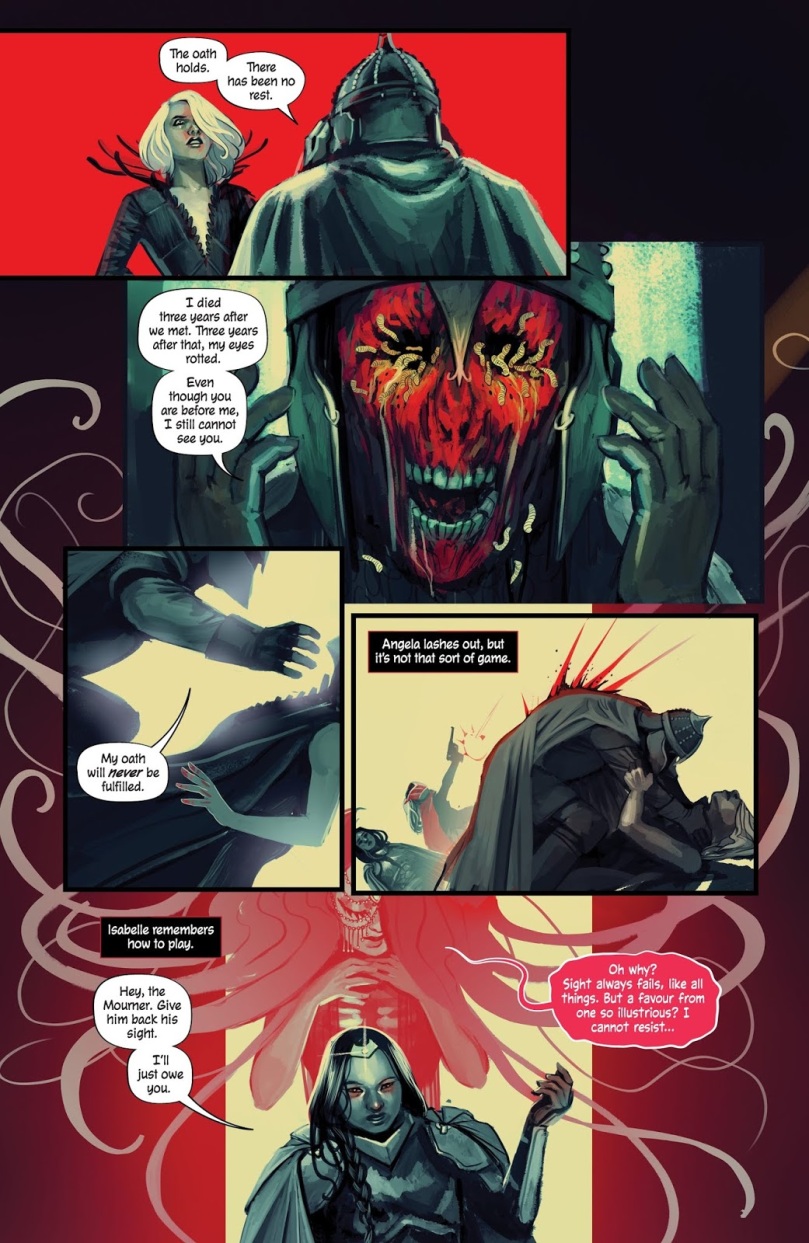

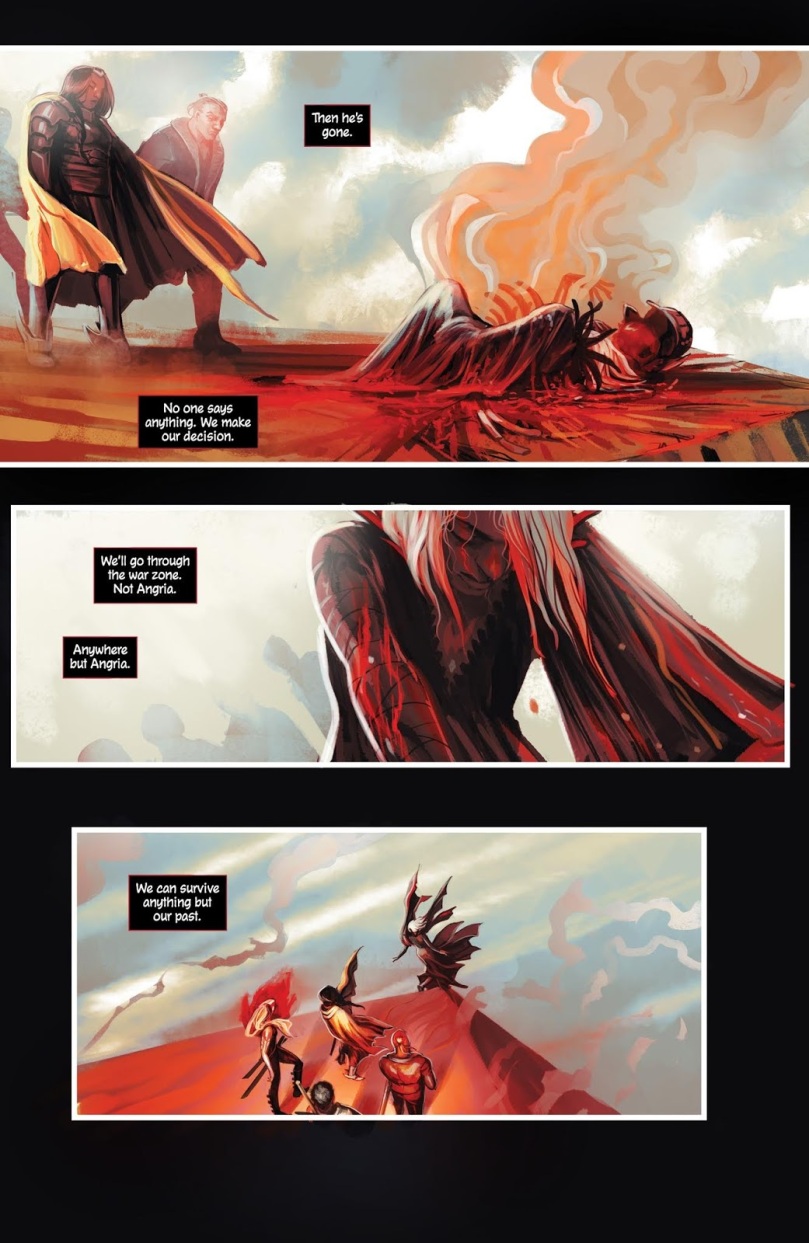
Needs more gays :p
LikeLike
True, but the guy and his alien ooze is already such great representation!
LikeLike